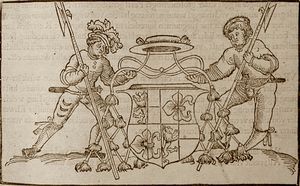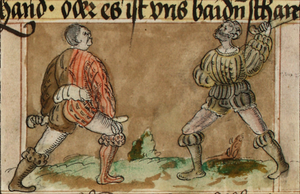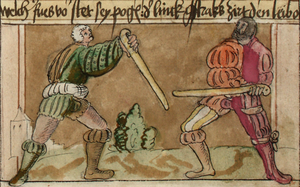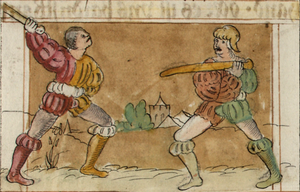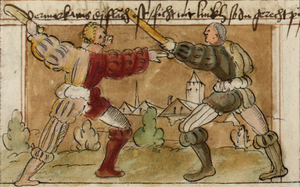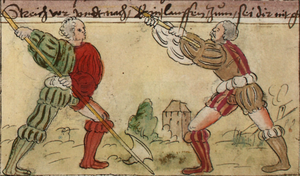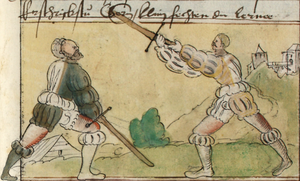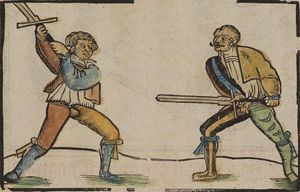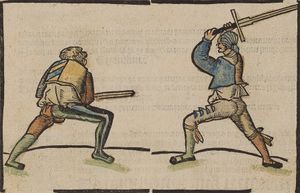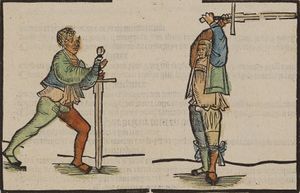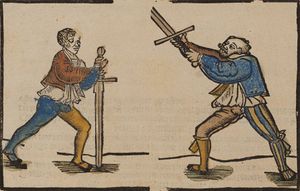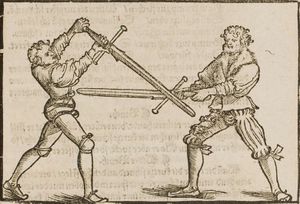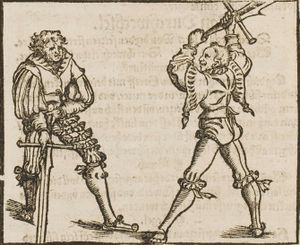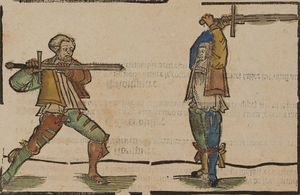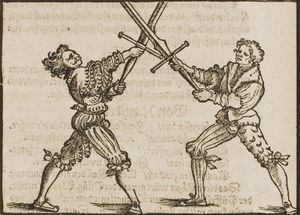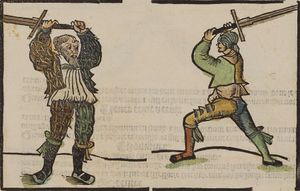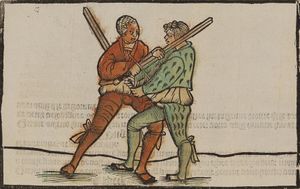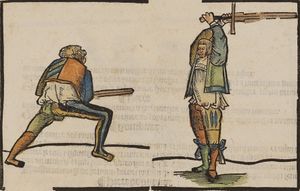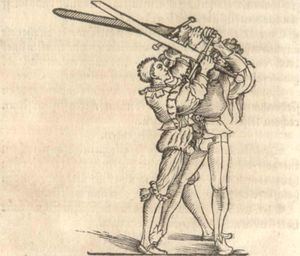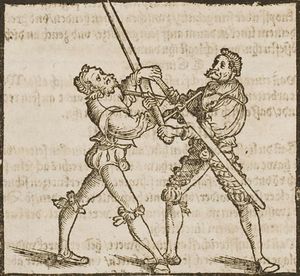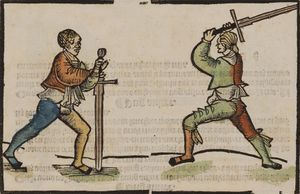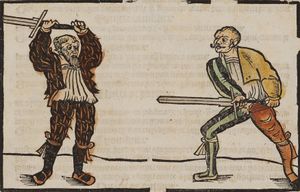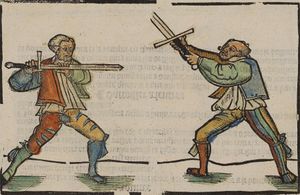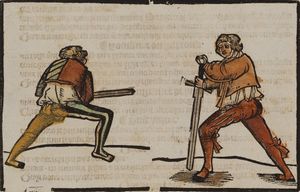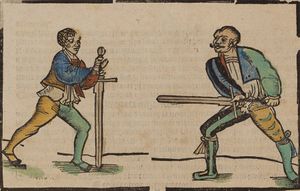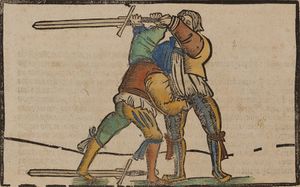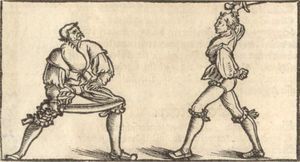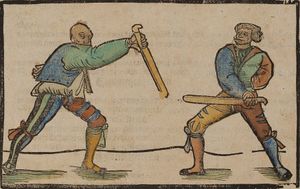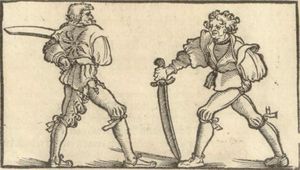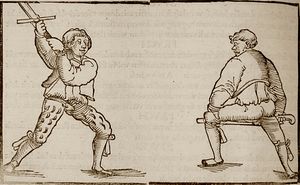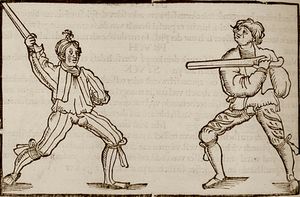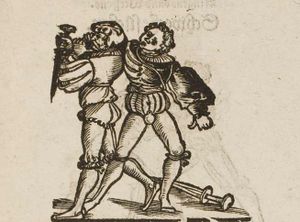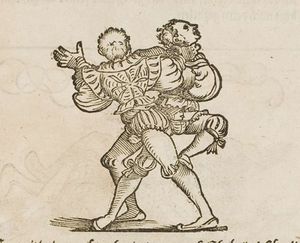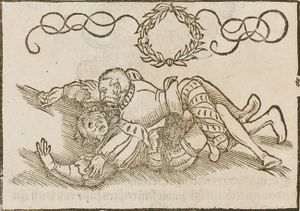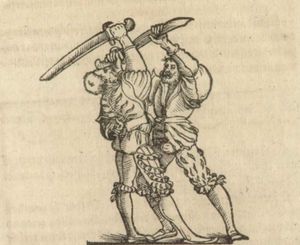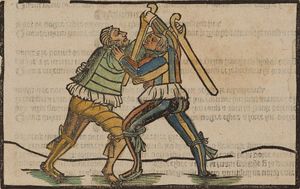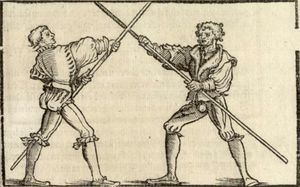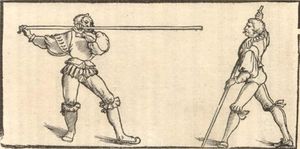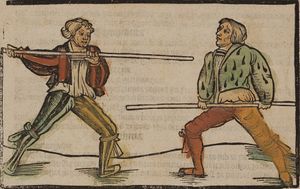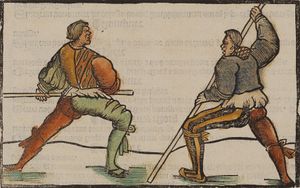|
|
You are not currently logged in. Are you accessing the unsecure (http) portal? Click here to switch to the secure portal. |
Difference between revisions of "Andre Paurenfeyndt"
| Line 3,332: | Line 3,332: | ||
Leg dich mit dem rechten fuß für / dz dein stang hinder dir lig zum streich zuck und wirff im dein stangen uß der leng in sein rechten seiten / so muß er sich versetzen zu seinem schaden / und dir den schwang geben zu der lincken seiten. | Leg dich mit dem rechten fuß für / dz dein stang hinder dir lig zum streich zuck und wirff im dein stangen uß der leng in sein rechten seiten / so muß er sich versetzen zu seinem schaden / und dir den schwang geben zu der lincken seiten. | ||
| '''Pieche''' | | '''Pieche''' | ||
| − | Mectez vostre droict pied devant que vostre estocq gise derier vous au train tirez et luyruez lestocq au loing, ou a tout | + | Mectez vostre droict pied devant que vostre estocq gise derier vous au train tirez et luyruez lestocq au loing, ou a tout la longure en son droict coste il luy fauldra remectre la deffence a son dommaige, & donner le tect vers le senestre coste. |
| | | | ||
| '''[59v] / stuckh /''' | | '''[59v] / stuckh /''' | ||
| Line 3,391: | Line 3,391: | ||
Wann sich einer verhawen hat / und sich seiner versatzung behilft so stoß im von oben nider inwendig zu seim gesicht / So muß er dem stoßwern / so sterck du gegen im dz dein ort zwüschen seiner beider hendt und deß leib eingewunden wird / und heb übersich / so nimstu im sein stangen. | Wann sich einer verhawen hat / und sich seiner versatzung behilft so stoß im von oben nider inwendig zu seim gesicht / So muß er dem stoßwern / so sterck du gegen im dz dein ort zwüschen seiner beider hendt und deß leib eingewunden wird / und heb übersich / so nimstu im sein stangen. | ||
| '''Rompure''' | | '''Rompure''' | ||
| − | Quand aulcun sa | + | Quand aulcun sa contretetu le coup, et se ayde a tout sa defense, luy boutez par deseur apres son visaige, il luy fauldra le coup tourner iuz ou empescher, & le coug tournant fortifie vous contre luy que vostre debout le gaingne entre ses deux mains & son corps & levez a mont, ainsi vous luy prenez son estocq. |
| | | | ||
| '''Bruch /''' | | '''Bruch /''' | ||
Revision as of 10:28, 25 January 2016
| Andre Paurñfeyndt | |
|---|---|
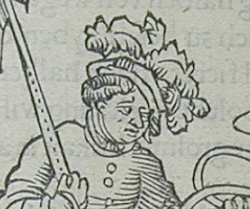 | |
| Born | 15th century |
| Died | 16th century |
| Occupation |
|
| Nationality | German |
| Patron | Matthäus Lang von Wellenburg |
| Movement | Liechtenauer Tradition |
| Influences | Johannes Liechtenauer |
| Influenced | |
| Genres | |
| Language | Early New High German |
| Notable work(s) | Ergrundung Ritterlicher Kunst der Fechterey (1516) |
| Manuscript(s) |
|
| Concordance by | Michael Chidester and Jeremiah Smith |
| Translations | Deutsch-Übersetzung |
Andre Paurñfeyndt (Paurñfeindt, Paurenfeindt) was a 16th century German Freifechter. He seems to have been a resident of Vienna, although he mentions in his introduction that he served as a bodyguard to Cardinal Matthäus Lang von Wellenburg (1468 - 1540).[1] In 1516, he wrote and published a fencing manual entitled Ergrundung Ritterlicher Kunst der Fechterey ("Founding of the Chivalric Art of Swordplay"), which Sydney Anglo notes may have been the first illustrated work of its kind.[2] Little else is known about the life of this master, but he describes himself as a Freifechter and the contents of his book make it clear that he was associated with the tradition of Johannes Liechtenauer. His treatise diverges significantly from the standard teachings of the Liechtenauer tradition, but this may be due to his stated purpose of writing for beginning fencers.
Contents
Treatise
Please note that only the first edition of this text (1516) has a complete set of illustrations, and we currently do not have scans of that edition that we are authorized to distribute. This article is illustrated using the remaining three illustrated texts, but following the order laid out in the original. The only exception to this is the image on page H2v of the 1516, which is replaced by the three images used in Egenolff's version. Furthermore, while the Twelve Rules for the Beginning Fencer are unillustrated in Paurñfeyndt's work, this presentation includes the illustrations for six of the twelve found in the MS B.200 (1524).
Images |
Archetype (1516) |
Empty |
Der Altenn Fechter anfengliche kunst (ca. 1531) |
La Noble Science des Ioueurs Despee (1538) |
Über die Fechtkunst und den Ringkampf (1538) |
||
|---|---|---|---|---|---|---|---|
| Founding of the Knightly Art of fencing through Andre Paurnfeindt, Freifechter in Vienna, Austria, clearly comprised with recent understandings. | [Ar] ERGRUNDUNG Ritterlicher kunſt der Fechterey durch Andre paurñfeindt Freyfechter cʒu Vienñ in Oſterreich / nach klerlicher begreiffung vnd kurcʒlicher verſtendnuſʒ. | Fechtbuch im Meier | La Noble Science des Ioueurs Despee | Ergrundung Ritterlicher Kunst Der Fechttereÿ Durch Liennhartt Sollinger Messerschmidtt / Nach Klerlicher Begreiffung vnd Kurzlicher Verstendnus | |||
| The Noble Great Prince and Gentleman, Herr Matheus [Lang] of the Holy Roman [stul], Cardinal of St Angelo, Bishop of Gurk, coadjutor of the See of Salzburg, etc. [Endbeut] Andre Paurnfeindt, Freifechter and with Cardinal's Greatness, a faithful Bodyguard, is my subservient service. | [Av] DEM Hochwirdigen Groſmechtigen Furſtñ vnd herren her MATHEus deſʒ heyligen Remiſchen ſtul Cardinal Sancti Angeli a latere / Biſchoff cʒu Gurck / peyhelffer des piſtumſʒ Salcʒburck c&. Endbeudt Andre Paurñfeyndt Freyfechter vñ Cardinaliſcher groſmechtigkait trewer trabandt / ſeyn untertenig dienſt | ||||||
| Highness in God the Father, Great Prince and gracious Sir, after that which I have seen, a greater departure and absence in attendance of daily practice, half due to the tender youth, I have resolved recently to write the Knightly Art of fencing and detailed interpretation of the Verses mostly avoided, (by) [spilfs] debauch [poser] Society and another one etc. Such explanation will I dedicate and entitle to your grace there with [beuilich] me, your Greatness in every Humility. | HOCHwirdiger in gott vater groſmechtiger Furſt genadiger herr / Nach dem mir gſehen virdt groſſer abgang vnd mangel vnaufmerckung halben von wegen der ʒarten iugent vnd teglicher vbung / hab ich mir furgnumen kurcʒlich ʒu beſchreyben dye Ritterlich kunſt der Fechterey vnd gruntlichs auſlegung der ʒetel fierer vrſach halben vermeidung / ſpilſs / praſſerei poſer geſelſchaft / und noch ains c&. Solche erclerung wil ich eureñ firſtlichen gnadñ dedicirñ intitulirñ da mit beuilich mich euer groſmechtikait in aller diemuet c&. | ||||||
| Recently I thought of 3 capital lessons in which shortly it will be understood, which elevates the Fencing, not only for the old fencers, but rather for the young students so that with passion and daily practice it will be realized, from such have I recently requested that twelve rules from which to you may arise and press forward subtly and quickly. Thus from a Master of the Sword or from a [vermerten] Freifechter you learn, and never from the elbow fencers, like the blind leading the blind, and falling in bed in the grave. | KVRCʒlich hab ich mir gedacht iii capitel in welchen kurcʒlich begriffen wirdt ler / vnd auſcʒug der fechterei / nit fur die altñ fechter / ſunder fur die iungen ſchueler damit in luſt vñ vbung teglich gmert werdt / auſʒ ſollichs hab ich kurʒlich erſucht ʒwelff regel aus welchen dir entſpringen mag pfortail ſubtilitet vnd pehendikait So du von ainem maiſter ſchwercʒ oder von ainem vermerten freifechter lerñſt / vnd nit von den winckel fechterñ als wan ain plinter den anderñ furt vnd fallen ped in graben. | Kürzlich hab Ich Mir gedachtt iii Cappillell [!] Inn welchen kürzlich begrifen wirdt Ler vnnd Auszug Der Fechttereÿ Nitt vir die Allttenn fechtterr sunder vir die Jungenn shuellerr Damitt Inn Lust vnnd Ibung teglich gmertt werdtt / Aufs solchs hab Ich kürzlich Ersuechtt zwelff Regell Aus welchenn Dir Enttspringenn Mag pfortaÿll Subtillÿgkhaitt Vnnd Behenndigkhaÿtt / so du vonn ainem Maÿster Schwerzs / Oder Vonn Aainem vermerttenn freÿfechtterr Lernnst / vnnd nit von den winckhellfechtternn Als wann ain plinder denn Anndernn fiertt vnnd vallenn baydt Inn grabenn | |||||
| When Grass and Greener did grow up so fast as hate and envy Thus had the sheep and cattle every year a good winter |
Wux laub vnd graſʒ Alſʒ neidt vnd haſʒ So hetten ſchaff vnd rinder Heur ein guetten winter |
Wux laub Vnnd grass als Neÿdtt vnd has So hettenn schaff vnd Rinderr heur ain guettenn Wintterr |
Images |
Archetype (1516) |
MS B.200 (1524) |
Der Altenn Fechter anfengliche kunst (ca. 1531) |
La Noble Science des Ioueurs Despee (1538) |
Über die Fechtkunst und den Ringkampf (1538) |
||
|---|---|---|---|---|---|---|---|
| Twelve Rules for the Beginning Fencer
Do not let the twelve rules annoy you |
[A2r] Cʒwelff regel las dich nit verdrieſſen |
Zwölff leren / den angehnden Fechteren.
Zwölff Regeln laß dich nit verdriessen / |
[90r] Zwelff lereñ deñ angehenndenn fechternn ~
Czwelff Regel laß dich nith ver drÿessenn |
zwelff Regell las dich nitt verdriessenn | |||
| The First
Whichever foot stands forward is bowed. |
Die erſt
Welcher fuſʒ forñ ſtet ſei pogñ |
[118r-c] Welcher fues von stet sey pogen: |
1.
Welcher fuß vorn steht / sei bogen / |
welcher fůß vornn stedth Seÿ geboge |
/ Die Erst /
Welcher fues forn stett seÿ bogen / | ||
| The Other
Fence high with an outstretched body |
Die Ander
Hoch gfochtñ mit gſtracktm͂ leib |
[118v-a] hoch gfochten mit gstraktem leib, |
2.
Hoch gfochten / mit gstracktem leib / |
hoch gefochte myt starckem leÿb |
Die annderr /
Hoch gefochten mit gstrackhenn leib / | ||
| The Third
Traverse and step with each other |
Die Drit
Straich vnd trit mit einander |
[118v-b] Straich vnd trit miteinander, |
3.
Streych und tritt mit einander |
Streych unnd thridt mith eÿn ander |
/ Die Drit /
Straich vnnd trit mit ainannderr / | ||
| The FourthTwelve Rules for the Beginning Fencer
Whoever steps after hews, |
Die Virt
Wer trit nach hewen |
[118r-b] Wer trit nach heyen: |
4.
Whoever steps after hews, |
wer thrÿdth nach heÿenn / |
Die Viert /
Wer trit nach hewenn / | ||
| The Fifth
Note what the flat is. |
Die Funft
Merck was die flech iſt |
[118v-c] Vermerk was dj flӑch ist, |
5.
Merck was die flech ist / |
merg waß die flech ist |
Die finfft /
Merckh was Ist die flech Ist / | ||
| The Sixth
Seek weak and strong. |
Die Sechſt
Such ſchwech vnd ſterk |
6.
Such schwech und sterck / |
Sůch schwech unnd sterck |
/ Die sechst /
Suech schwech vnd sterckh / | |||
| The Seventh
Probe soft or hard |
Die Sibendt
Prieff waich oder herdt |
7.
Prüff weych odder hert / |
prieff weÿch aber herth |
/ Die sibennt /
Prief waich oder hert / | |||
| The Eighth
Traverse before and after |
Die Acht
Streich for vnd nach |
[119r-d] Streich vor vndt nach, |
8.
Streych vor und nach / |
Sthreych vor und Nach |
/ Die acht /
streich vnd vor vnd nach / | ||
| The Ninth
Fence closely, by the body |
Die Neundt
Ficht nahendt beym leyb |
[119r-c] ficht nahent peym leib, |
9.
Ficht nahend beim leib / |
fÿcht nahent beÿm leÿb |
/ Die Neindt /
Ficht nachent beim leib / | ||
| The Tenth
Step closely in the bind |
Die X
Trit nahendt in pundt |
[119r-a] Trit Nahent Inn pünt, |
10.
Tritt nahend in Bundt / |
thrÿd Nahent inn bůndth |
/ Die zechenndt /
Trit nachent Im bundt / | ||
| The Eleventh
In front of the hand is named the long edge. |
Die XI
Vor der handt haiſt die lang ſchneidt |
11.
Vor der hadt / heyßt die lang Schneid / |
vorder hant heÿst dÿe lange schneÿdt~ |
Die ailfft /
Vor der handt haist die lang schneidt / | |||
| The Twelfth
If you frighten easily, |
Die XII
Erſchrickſtu gerñ |
[119r-b] Erschrickstu Gern, |
12.
Erschrickstu gern / |
Erschrÿeckstü gern |
Die zwelfftt /
Erschrickhstu gerenn / |
Images |
Archetype (1516) |
Empty |
Der Altenn Fechter anfengliche kunst (ca. 1531) |
La Noble Science des Ioueurs Despee (1538) |
Über die Fechtkunst und den Ringkampf (1538) |
||
|---|---|---|---|---|---|---|---|
| The first chapter teaches
how one should use advantage in the long sword, which is used with both hands, such as the battle sword, riding sword, estoc, and many others which I will for brevity's sake leave out. |
[A3r] DAS Erſt capitel lernd
wieman phfortayl prauchñ ſol im langñ ſchwerdt welchs gnucʒt wirt mit payden henden / als ſthlachtſchwerdt / reydtſchwerdt triecker vnd ander vil mer / die ich von kurcʒ wegen aus las. |
[IIIIv] Erst Theil diß Buchs.
Wie man fortheyl im langen Schwerdt / welchs ein grundt unnd ursprung allen Fechtens / zu beden henden brauche sol. |
Ici commenche ung tresbeau livret
contenant la chevalereuse science des joueurs despee, pour apprendre à jouer de lespee a deux mains, & aultres semblables espees lesqeles lon use a tout deux mains, auecq aussi braquemars, et aultres courts coulteaux, lesquels lon use a tout une main, atout la demy lance hallebarde, guysarmes, & semblables bastons, a tout le poingnart, et le bouklie. |
[50v] Das Erst Cappittell Lernndtt
wie Mann pfortaÿll brauchen soll Im lanngenn Schwertt welchs gnuztt wirtt mitt baÿdenn hennden als shlachtschwertt Reÿttshwertt trÿeckher vnnd annder vil merr die Ich kurz wegenn aus las / | |||
| Ein Zedel fechter ich mich rüm Im Schwerd un Messer ungestüm In stercke / schweche / kurtz und lang / Mein gegen man ich thu bedrang / In des hab acht / versteh mich recht / Ihn triff / eh er sein Läger schlecht. |
|||||||
| So hab ein anders ich darauff / Damit mein kunst gar teur verkauff Mein Arbeit treib ich nun bering / Am leib glatt einher / nach der kling / Zu schnid mach streych / stich / so widrub Wilts lerne grüntlich. Zu mir komm. |
|||||||
| The first Guard will be known as High-Point, or Ox as the ancient will, and will hereupon be taken. | Das erſt gleger wirdt genant hochort oder ochs als die alten wellen vnd wirdt vil dar auſʒ gnummen /
|
[Vr] Das erst Leger würdt genant Hochort oder Ochs / als die Alten woellen / Und würt vil darauß genommen.
Wer dir ober hawet / |
Ici commenche la manière pour jouer a tout lespee a deux mains | Das Erst Cappittell gleger wirdtt genanntt hohortt oder Ochs als die alttenn wellen vnnd wirt vill daraus gnumen /
Wer dir Oberhautt | |||
| WINGER
The Winger is taken from the High Guard or High-Point: the first, strike from the Roof to his left ear, the second from under with a step to your left side, the third strike after to the head. |
FLVGEL.
Flugel nym aus der obrñ hut oder hochort den erſten ſtraych von dach ʒu dem lincken or / den anderñ von vndñ mit dem trit deiner linckñ ſeytten / den drittñ ſtraych hinderſych auf den kopff. |
Flügel.
Flügel nim aus der Obern hut oder Hochort / Den Ersten streych von tach zu dem lincken ohr / Den andern von unden mit dem trit deiner lincken seiten. Den dritten streych / hinder sich auff den kopf. |
De la volee
Prenez du hault debout & de la haulte garde le premier treit de hault envers la senestre oreille, laultre a tout la demarche de votre senestre coste, le troisiesme frappez derriere sur la teste. |
fligell /
Flügell Nim aus der Obernhutt oder hohortt den Ersten straÿch von dach zu dem linckhen or den andernn von vnden mit dem tritt deiner linckhen seÿtten den driten tail straÿch hindersÿch auf den kopff / | |||
| BREAK
If one Wings to you, displace the first from the Roof, the second strongly from below with your long edge, and grab with your left hand to his sword's pommel, thus will you be in over his Sword. |
PRVCH.
Flugelt dir ayner ʒu / verſecʒ den erſtñ von dach / den anderñ ſteck von vnden mit deiner lan/gen ſchneydt vnd greyff mit deyner lincken handt anſeyn ſchwertʒknopff / ſo virfſtu yn vber ſeyn ſchwert. |
Bruch diß vorgeschribenen.
Flügelt dir einer zu / versetz den ersten von tach Den andern steck von unden mit deiner langen schneid / und greiff mit deiner lincken handt an sein schwerts knopff / so würffestu ihn über sein schwerdt. |
Rompure
Se aulcun vous cuyde frapper de la volee, retirez le premier coup, den hault, lautre refrappez par dessoubz a tout vostre long coup, ou taillon, et prenez le pommeau de son espee a tout vostre senestre main, ainsi le ruerez deseur son espee. |
[51r] Bruch /
Fligelt dir ainer zu Versezt denn Erstenn von dach den anderenn strckh vonn vnndenn mitt deiner lanngen shneÿdtt vnd greif mit deiner linckhen hanndtt an sein shwerzs knopf so wirfstu In vber sein shwertt / | |||
| TEXT | [A4r] TEXT
Zorñhau / krump / twer / |
Text.
Zornhaw / komp / twer / |
text /
Zornhaw / krump / twer / | ||||
| CROWN
Step and strike through from above with your long edge to his left ear, then next, step and strike with the short edge down to the right ear; the third strike goes after with the long edge. |
KRON
Trit vnd ſchlach von oben mit deiner langen ſchneidt durch / auf ſein linck or / den anderñ trit vnd ſclach mit kurcʒer ſchneid oben nider des rechtñ ors / den drittñ ſtraich hinderſich mit der langñ ſchneidt |
Kron.
Tritt unnd schlag von oben mitt deiner langen schneid durch / auff sein linck ohr. Den andern trit un schlag mit kurtzer schnei [Vv] de oben nider des rechten ohrs. Den dritten streych hinder sich mit der langen schneid. |
De croiser ou frapper droict
Marchez et frappez de hault a tout vostre long taillon parmy sur sa senestre oreille, secondement marchez et frappez a tout le court coup de hault desoubz la droicte oreille, tiercement retirez vous arriere a tout le long taillon. |
Kronn
Tritt vnnd schlach vonn Obenn Mit deinerr Lanngen Schneÿdtt Durch auff sein linckh Orr den anderen tritt vnnd Schlach mit deinerr kurzenn schneÿdt Oben Nyder des Rechtenn Orrs den trÿtten straÿch hindersÿch mitt der Lanngen shneidtt / | |||
| BREAK
When to you one will Crown Strike, catch the first, to the next strike put the short edge on his neck, and thus he harms himself. |
PRVCH
Wan dir ainer kronhaut veruach den erſth / ʒum anderñ ſtreich leg im dein kurcʒe ſchneidt an halſʒ ſo ſclecht er ſich ſelb |
Bruch.
Wann dir einer kron hawt / verfach den ersten. Zum anderenn streych / leg ihm dein kurtze schneid an hals / so schlegt er sich selb. |
Rompure
Quant aulcun vous faict le cromb coup, lattendez premier, secondement luy mectez le court taillon au col, il frappera a soy mesmes. |
/ pruch /
Wann Dir ainer kronhautt Vornach den erst zum andernn streÿch leg Im Dein kurze schneÿdtt an den hals so schlecht er sÿch selbs / | |||
| FAILER
Take the Failer from the highest points, cut through, quick, to his left ear and step with your left foot against his right side, the next, strike in long to his right ear, remain high with good displacing. |
FELER
Nim den feler auſʒ dem hohen ort hau kurcʒ durch auff ſein linck or vnd trit mit deim linkñ fuſʒ gegñ ſeiner rechtñ ſeittñ / vnd ſchlach den andrñ ſtraich lang hinein auf ſein recht or / bleib hoch mit gutter verſacʒung |
Feler.
Nim den Fehler auß dem Hohen ort / Haw kurtz durch / uff sein linck ohr / und tritt mitt deim lincken fuß gegen seiner rechten seitten / Und schlahe den andern streych lang hinein auff sein recht ohr / Bleib hoch mit guter versatzung. |
Par deseur tout en volant
Prenez par deseur en volant den hault, tenez court parmy envers sa senestre oreille & marchez a tout le senestre pied contre son droict coste et frappez laultre coup en au loing de luy sur la droicte oreille et demourez hault a tout bonne defence. |
[51v] vellerr
Nim den veller aus dem hohen Ortt haw kurz Durch auff sein Linckh Orr vnnd tritt mitt deinem linckhen fues gegen seinerr Rechten seÿttenn vnnd schlach den andern straich lang hinein auf sein recht Orr bleib hoch mitt gutter versazung / | |||
| BREAK
Hew from above in the Ox against him, under, through the Rose, and put the short edge in his face, turn away slightly and strike after with the long edge. |
PRVCH
Hau von obñ auſʒ dem oxſen gegen ym / vnden durch die roſen vnd leg ym die kurcʒ ſchneid in ſein gſicht / wendt kurcʒ ab vnd ſchlach mit der langen ſchneidt nach |
Bruch.
Haw von oben auß dem Ochsen gegen ihm / unden durch die Rosen / und leg ihm die kurtze schneid in sein gesicht / wind kurtz ab / und schlahe mit der langen schneid nach. |
Rompure
Tenez vous en hault hors les ales contre luy, parmy les roses, et lui mettez le court coup en son visage,tournez vous bien brief iuz et frappez apres luy a tout le long taillon |
pruch /
haw vonn Oben aus dem Ochsen gegen Im vnden durch die Rossenn vnnd leg Im die Lanng kurz In sein gsichtt / wendt kurz ab vnd schlach / Mitt der Langen schneydtt nach / | |||
| DEVICE
Hew through, against his strike, and step with the right foot in the triangle so that you are farily open, which causes him to strike to your opening, there after step with the left foot and stike after from the hand. |
STVCK
Hau gegñ ſeinem ſtraich durch / vnd trit mit dem rechtñ fuſʒ in triangel darmit du dich vaſt endtpleſt / vrſach daſʒ er deiner ploſʒ cʒuſchlach / darnach trit mit dm͂ linckñ fuſʒ vñ ſchlach von der hand nach |
Regel.
Haw gegen seinem streych durch / unnd tritt mit dem rechten fuß in Triangel / damitt du dich fast entblössest / Ursach / das er deiner blösse zuschlahe / Darnach tritt mit dem lincken fuß / und schlahe mit der hand nach. |
Piece
Tenez alcun contre son coup parmy, et marchez a tout le droict pied le triangle, a ce vous vous decouvrez fort lequel il considere, par quoy marchez apres a tout le pied senestre devant et frappez ariere de la main apres lui. |
Stuckh /
Haw gegen seinem straÿch durch vnd trit mit dem rechten fues In triangell darmit du dich Entblest vrsach das er deiner bloss zushlach darnach trit mit deinem Linckhen fus vnnd shlach vonn der hanndt Nach / | |||
| FROM THE FOUR OPENINGS | [B] Von 4 Pleſſen
Vier pleſʒ wiſſe / |
Von vier blößen.
Vier Bloesse wisse. |
Von 4 plessen /
Vier pless wiss | ||||
| BREAKING THE FOUR OPENINGS | Vier Pleſʒ prechñ
Wildu dich rechen / |
Vier Blöße brechen.
Wiltu dich rechen / |
Vier ples prechenn /
Wiltu dich Rechen | ||||
| SLINGING
Slinging is taken from the high guard, hew against him with the long edge to his left ear, if he displaces you, then make like you will pull, but remain with the short edge on his left ear, pull and sling from below with the flat to his right ear. |
SCHLEVDERN
Schleydrñ nim auſʒ der obrñ hut / hav gegñ ym mit der langñ ſchneidt auf ſein linck or verſecʒt er ſich thu ob du ʒucken welleſt vñ pleib mit der kurcʒñ ſchneidt an ſeim͂ linckñ or ʒuck vnd ſchleyder von vnden mit der flech an ſein recht or |
Schlaudern.
Schlaudern nim auß der Obern hut / Haw gegen ihm mitt der langen schneid auff sein linck ohr Versetzt ers / thu ob du zucken wollest / und bleib mit der kurtzen schneid an seinem lincken ohre / Zuck und Schlauder von unden mit der fleche an sein rechtes ohr. |
Tranier du long coup
Prenez du deseure garde, tenez contre luy a tout long coup vers la senestre oreille, sil se remect faictes comme si vouldriez tirer, et demourez a tout le court coup a la senestre oreille, tirez et frappez a tout le plat a la droicte oreille. |
[52r] Schleÿderenn /
Schleidern Nim aus der Oberhuett haw gegen Im mitt der Langen shneÿdtt auff sein linckh or versezt er stÿch thue ob du zuckhen wellest vnd bleib mitt der kurzen shneidt an sein linckh or zuckh vnd shleÿder von vnden mit der flech an sein rechtt orr / | |||
| BREAK
If one will sling at you, allow the first strike to cut away, and displace the second from above, downwards with your long edge, thus you may thrust or suppress. |
PRVCH
Ob dir ainer ʒu ſchleidert laſʒ den erſten ſtraich ab ſchneiden vnd verſecʒ den anderñ von obñ nider mit deiner langen ſchneidt / ſo magſtu in ſteckñ oder tempffen |
Bruch.
Ob dir ainer zu schlaudert laß den ersten straich abschneiden / und versetz den andern von oben nider mitt deiner langenn schneid / so magstu ihn bstecken oder dempffen. |
Rompure
Quant aulcun vous traine le long coup, laissez le premier courir iuz, & remectez laultre de hault en bas a tout vostre long coup, ainsi le pourez bouter ou frapper. |
pruch /
Ob dir ainer zuschleidertt las den Ersten straich abschneÿden vnd versez den andern vonn Oben nider mitt der Lanngenn schneidtt so magstu In stecken oder tempffen | |||
| SHOOTING THROUGH
You may also take the shooting through from the high guard, hew from above downwards through the Rose, with reversed hands and short edge in his face, allow this quickly to run off, work after with the long edge. |
Durch ſchiſſen
Durchſchiſſen magſtu auch nemen anſʒ dem hohenort / hav von oben nider vnden durch dieroſen / mit verkertñ henden vnd kurcʒer ſchneid in ſein geſicht / laſʒ kurcʒ ablauffen / mit der langen ſchneidt nachtretten |
Durchschiessen.
Durchschiessen magstu auch nemenn auß dem Hohen Ort / Haw vonn oben nider / unden durch die Rosenn / mitt verkerten henden und kurtzer schneid / in sein angesicht Laß kurtz ablauffen mit der langen schneid nachtretten. |
Passer dessoubz
Passer oultre pourez aussi prendre hocs ( ?) le hault debout, tenez de hault en bas parmy les roses avec les mains traverses, & court taillon en son visaige, et laissez courtement courir iuz a tout le long taillon, & apres marcher. |
Durchschiessenn
Durchshiessen Magstu auch Nemen aus dem hochen Ortt haw von obenn Nider vnnden durch die Rossenn mit verkertten henden vnd kurzer shneidt Inn sein gsichtt las kurz ablauffen mitt der Langen shneidt nachttretten / | |||
| BREAK
When one shoots through to you, and will lay on you with the short edge, so that you cannot work further, take your sword by the point and strike him on the head with the cross. |
PRVCH
Wan dir ainer durch ſcheuſt / vnd wil dir die kurcʒ ſchneid an legñ daſtu anderſt nit arbaitñ kanſt / nim dein ſchwerdt peim ort vnd ſchlach ym daſʒ creucʒ an kopf |
Bruch
Wann dir einer durchscheußt / unnd will dir die kurtz schneide anlegen das du anderst nit arbeiten kanst / so nim dein schwerdt beim ort und schlahe ihm das Kreutz an kopff |
Rompure
Quant aulcun vous passe deseur, et vous veult mectre le court taillon, si aultrement ne pouvez besoigner ne oevrer, prenez vostre espee a tout le taillant, et lui frappez la croix sur la teste. |
pruch
Wann dir ainer durchsheust vnd wil dir die kurz shneÿdt an legen dastu annderst nitt arbaitten kanst Nim dein shwertt peim Ortt vnnd shlach Im das Creÿz ann kopff / | |||
| IRON DOOR
The third guard will be known as the Iron Door, or the Twir after the ancients. |
[Bii] Eyſrñ portñ
DAS drit gleger wirt gnandt die eyſſrñ portñ oder die twir nach den altñ / twir benimpt / |
Eisern Pforten.
Das Dritt Läger würt genant / die Eisern Pforten / oder die Zwir nach den Alten. Zwir benimpt |
[52v] Eissen portten /
Das dritt gleger wirdtt genandtt die Eÿssen portten oder die zwer nach den alten zwer benimbt | ||||
| FROM THE ROOF
Position yourself in the Iron Door with crossed hands, if one diagonally cuts at you from the Roof, take his strike from the Roof with the short edge and work after him with the long edge. |
Vom tag
Leger dich in die eiſrenporten mit gſchrenkten henden / ſchlecht dir ainer von dach / nym ſein ſtraich vom tag mit kurcʒer ſchneidt / vnd trit ym nach mit langer ſchneid |
Von Tach.
Leger dich in die Eisern pfortten mitt geschrenckten henden / Schlegt dir ainer von tach / nim sein streych von tach mit kurtzer schneid / und tritt ihm nach mit langer schneid. |
De deseur
Longez vous de la longue pointe a tout les mains croissiez en la serrure de fer. Si aulcun vous frappe de deseur, prenez son coup den hault a tout le court taillon et marchez apres luy avecq le long coup. |
Vom tag /
Leger dich In die Eisen porten mit geshrenckhen henden schlecht dir ainer von dach Nim sein straich vom tag mitt kurzer schneidt vnd trit Im nach mit Langer shneidt / | |||
| BREAK
Work the Failer on him, thus he suffers in the iron door, thus he proceeds to freely make himself open. |
PRVCH
Treib den feler auff yn / ſo er leidt in der eiſrenportñ ſo verfert er vmbſunſt vnd pleſt ſich |
Bruch.
Treib den Fehler auff ihn / so er ligt in der Eisern pfortten / so verfert er umbsunst / und blößt sich. |
Rompure
Chassez par deseur sur luy quant il est en la serrure de fer, et il se bouge pour riens, et se descouvre. |
pruch /
treib den feller auf in so er leidt in der Eissenportten so ververt er vmbsuns[t] vnd bleß sÿch / | |||
| SHOOTING OVER
Position yourself as before with crossed hands and work with the short edge shooting over to his left ear and turn your hands and strike after with the long edge. |
Vberſchieſſen
Leg dich wie for mit gſchrenckten hendñ vnd trit mit der kurcʒñ ſchneid vbergſchoſſen auf ſein linck or vnd verwendt dein hendt vnd ſchlach mit der langen ſchneid nach |
Uberschiessen.
Leg dich wi vor / mit geschrenckten henden / und tritt mit der kurtzen schneid übergeschossen auff sein linck ohr / unnd verwend dein hend und schlahe mit der langen schneid nach. |
Tirer oultre
Debassez vous comme devant a tout les mains croissiez et marchez a tout le court taillon oultre tire sur son oreille senestre, et destournez vous mains et frappez a tout le long coup apres luy. |
Vberschiessen
Leg dich wie vor Mitt geshrenckhen henden vnd trit mit der kurzen shneidt vbershossen auf sein linckh Orr vnd verwendtt dein hendt vnnd shlach mit derr Lanngen shneÿdtt nach / | |||
| BREAK
When one has shot over to you with his short edge, thus wind the strike out, then come to strike after strike, and more such work. |
PRVCH
Wan dir ainer die kurcʒ ſchneid vber ſcheuſt ſo wendt den ſtraich ab / ſo kumpt dir ſtraich wider ſtraich / vnd gleiche arbait |
Bruch.
Wann dir einer die kurtz schneid überscheußt / so wennde den streych ab / se kompt dir streych wider wider streych / und gleiche arbeit. |
Rompure
Quant aulcun vous passe deseur vous oultre le court taillon, tournez lalle iuz, ainsi aurez coup contre coup et pareil ou semblable œuvre ou traveil. |
pruch / | |||
| FROM DISPLACING | [Biii] Von verſecʒen
Vier findt verſecʒen / |
Von Versetzen.
Vier sind Versetzen / |
[53r] Von versezenn /
Vier sindtt der versezen | ||||
| DAS ander gleger wirdt gnandt hangendtort vnd iſt ʒwifach
krump auff pehendt / |
Das ander Läger würdt genant Hanged ort / und ist zwifach
Krump auff behend / |
Das anderr glegerr wirdtt genandtt hangentortt vnd Ist zwifach
krump auff / Behenndtt | |||||
| HANGING POINT
Hanging point puts the right foot forward like in the figure, and is with the flat facing down, this works quick and high, and displaces those strikes which come from the Roof, quickly sink the running off, and work after with the long strike. |
Hangengtordt
Hangendort legert den rechtñ fueſ for als in der figur iſt mit der flech vnter das angeſicht trettñ kurcʒ vñ hoch verſecʒt was ſtraich von dach gſchlagñ wirdt / kurcʒ ab laſſñ lauffen vnd lang nach treten mit dem ſtraich |
Hangend Ort.
[VIIv]Hangend ort legert den rechten fuß vor / mitt der fleche under das angesicht tretten / kurtz und hoch versetzt / was streych vonn tach geschlagen würdt / kurtz ab lassen lauffen / und lang nachtretten mit dem streych. |
Pendant le point sur le poulx.
Boutez le droit pied devant, marcez court et remectez en hault quel coup que soit frapes de hault, laissez bien court courir iuz, et marchez au loing vers luy a tout le coup. |
/ hangenortt /
Hangendortt leger den Rechten fus vor als In der figur Ist mitt der flech vnter das angsicht treten kurz vnd hoch versezt was straÿch von dachshlage wirdt kurz ab lasen lauffen vnd lang nach treten mitt dem straÿch / | |||
| BREAK
Work from the right hand, with the right foot forward, if he continues to lay in the hanging point, put the short edge on his right ear, so that he may not pull away, where he then however will pull away, thus he opens himself. |
PRVCH
Treib von der rechtñ handt den rehten fues vor ligt er ſtil im hangñdnort leg im die kurcʒ ſchneid an ſein recht or ſo tar er nit ʒucken wo er aber ʒuckt ſo entpleſt er ſich |
Bruch.
Treib von der rechten handt / den rechten fuß vor / ligt er still im Hangenden ort / leg ihm die kurtze schneid an sein recht ohr / so darff er nit zucken / wo er aber zuckt / so entblößt er sich. |
Rompure
Chassez de la main droicte le droict pied devant, sil gist coy en le pendant point mectez luy le court taillon a la senestre oreille, et nosera tirer, car sil tire il se descouvre. |
pruch /
Treib von der Rechten handt den rechten fus vor ligt er stil Im hangendortt Leg im die kurz shneidt an sein recht or so darf er nit zuckhen wo er aber zuck | |||
| COUNTER BREAK
When one lays his short edge on your neck, turn your hands with the sword under him from above, with the long edge, and grab on to his pommel with your left hand, throw him to the left side over his sword. |
Wider Pruch
Wan dir ainer die kurcʒ ſchneidt an den halſʒ legt verwendt dein hendt mit dem ſcwerdt vñ ſper yn von obñ mit der langñ ſchneid / vnd greiff mit deiner linckñ hand an ſein knopf wirf yn auf die linck ſeitten vber ſein ſchwert |
Wider Bruch.
Wann dir einer die kurtze schneid an den hals legt / verwende dein hend mit dem schwerdt / und sperr ihn von oben mit der langen schneid Und greiff mit deiner lincken hand an seinen knopff / wirff ihn auff die linck seiten über sein schwerdt. |
Contre roumpure
Quand aulcun vous mect le court coup au col, tournez voz mains, a tout lespee, et le serrez d'en hault a tout le long coup, et prenez a tout vostre senestre main, le pommeau de son espee, et le ruez sur le senestre coste oultre son espee. |
[53v] Wider pruch /
Wan dir ainer die kurz shneidt an den hals legt verwendt dein hendt mit dem schwert vnnd sper In von Oben mit der Langen schneidt vnd greif mit deiner Linckhenn handtt an sein knopf vnd wirf in auf die lincke seÿten vber sein shwert | |||
| Welcher lebt ycʒ auf erdt Der von nyemancʒ gſchendtwerdt |
Welcher lebtt Jez auff Erdtt : Der von Niemandanz gschendt werdtt / | ||||||
(after the ancient art) but to our rabischen and new art we have other |
[(B4)] Vier gleger allain / (nach der altñ art) aber nach vnſſer rabiſchñ neyen art hab wir ander nam wie wol ain pe/deuttung iſt / hochort / hangendtort / eyſñpartñ / phflug / die manigfeltig ſeind |
[VIv] Vier Läger.
Vier Läger alleyn |
Vier gleger allain nach der alten art aber nach vnser rabichsen neuen art hab wir ander Nam wiewoll ain bedeitung Ist hochort hangendort eisenporten pflug die manigfaltig sind / | ||||
| GRABBING OVER
You may also take Over-Grabbing from the Highpoint, grab with your right hand over your cross onto the blade so that your fingers stay on the flat, if one strikes at you, strike against him with the strong so that you are over his and pull your flat to his right ear and lead high in the displacing. |
Wbergreiffñ
Vber greiffñ magſtu auch nemen auſʒ dem hohenort / greiff mit deiner rechtñ handt vber dein kreucʒ in die kling daſʒ dein finger in der flech ſtendt / ſchlecht dir ainer ʒv / ſchlach ge/gñ ym mit der ſterck daſtu mit not ſein ſchwert vber dringſt / vnd ʒvck ym dein flech an ſein recht or vnd verfar hoch in dein verſacʒung |
Ubergreiffen.
Ubergreiffen magstu auch nehmen auß dem Hohen ort. Greiff mit deiner rechten handt über dein Kreutz in die klinge / das dein finger in der fleche stehend. Schlegt dir einr zu / schlahe gegen ihm mit der stercke das du mit not sein schwerdt übertringest / und zuck ihm dein fleche an sein recht ohr / unnd verfare hoch / in deine versatzung. |
Poigner [des epee]
Le poigner pouvez aussi prendre hors le haut debout, prenez a tout vostre main droicte deseur vostre croix lalumelle que vous dois gisent sur le plat, et si aulcun frappe apres vous, frappez contre luy par force tellement que par force luy efforcez son espee, & luy tirez vostre plat a son oreille droicte, et haulsez en haut vostre coup. |
Vbergreiffen /
Vbergreiffen Magstu auch Nemen aus dem hochenortt greiff mit deiner recht[ten] handt Iber dein kreiz In die kling das dein finger In der flech stendt shlecht dir ain[er] zu schlach zu Im mit der sterckh dastu mit nott sein schwert vber dringst vnd zuckh Im dein flech an sein recht orr vnd verkar hoch In deiner Versazung / | |||
| BREAK
When one would Over-Grab to you, offer him the strike and pull short, then strike long after or break him with the Failer or the Crown Strike, etc. |
PRVCH
Wan dir ainer vbergreift peudt ym den ſtraich vnd verʒuck kurcʒ ſtreich lang nach oder prichs mit dem feler oder kronhaw &c. |
Bruch.
Wann dir einer übergreifft / beut ihm den streych / und verzuck kurtz Streich lang nach / oder brichs mit dem Feler oder Kron hawe. |
Rompure
Quant aulcun vous poignist, offrzez luy lallee & tirez le court coup au loing vers vous ou rompez par deseur en volant ou pardroict frappez. |
pruch /
Wann dir ainer Vbergreifft pendt Im den straich vnd verzuckh kurz streich lang oder prichs mit dem veller oder kronhaw / | |||
| REMAINING
Position yourself in the High Guard or Highpoint, and hew with the long edge to his left ear, and make as if you would pull this, but remain with the short edge on his left ear, thereafter pull and hew after with the long edge. |
Pleybñ
Leg dich in die ober huet oder hochort / vnd haw mit der langñ ſchneidt an ſein linck or vñ thu ob du ʒuckñ welſt vnd pleib mit der kurcʒñ ſchneid an ſeinem linckñ or / darnach ʒuck vnd haw mit langer ſchneid nach |
Bleiben.
Leg dich in die Oberhut oder Hochort / und haw mit der langen schneid an sein linck ohr / und thu ob du zucken wolltest / unnd bleib mit der kurtzen schneiden an seinem lincken ohr. Darnach zuck und haw mit langer schneid nach. |
Demourer
Boutez ou mectez vous en le hault debout ou garde, et tenez a tout le long coup, a sa senestre oreille, et faictez comme si tirer vouldriez, et demourez a tout le court taillon a sa senestre oreille, et puis tirez et tenez a tout le long coup vers luy. |
pleiben
Leg dich in die oberhuet oder hochort vnd haw mit der langen schneidt an sein linck[h] or vnd thue ob du zuckhen welst vnd bleib mit der kurzen schneidt an seinem linckhen or darnach | |||
| BREAK
When one would remain with the short edge on your left ear, thus remain also on the other side; if he pulls away first, he thus harms himself. |
PRVCH
Wan dir anier pleibt mit kurcʒer ſchneid an deinem linckñ or / ſo pleib du auch an der an/dernſeitten ʒuckt er aber von erſt ſo ſchlecht er ſich ſelber |
Bruch.
Wann dir einer bleibt mit kurtzer schneid an deinem lincken ohr / so bleib du auch an der andern seitten / Zuckt er aber von erst / so schlegt er sich selber. |
Rompure
Quant aulcun vous demeure avec le court coup a vostre senestre oreille, demourez vous aussi a laultre coste, sil tire alors premier, il frappe soymesmes. |
[64r] pruch
Wan dir ainer bleibt Mitt kurzerr schneidt an deinen linckhen orr so bleib Du auch an der andern seÿten Zuckht er aber von Erst so schlecht er sich selberr / | |||
| Wolher / Mich schon besunen hab / Uff bede ort zusetzen ab / Doch nit zulang. Behalt das Vor / Biß mir die blöß wird offenbor. Keins Legers ich dir wird sein gut. Im Nach dich triff uß freiem mut. Damit zur arbeit kom geschwind / Ja wart biß ich dir erst anbind. |
|||||||
| FROM RUNNING OVER | [C] Von Vberlauffñ
Wer vndñ ramubt / |
Uberlauffen.
Wer unden raubt / |
Von vberlauffen /
Wer vnden Ramett | ||||
| TRIANGLE
Position yourself with crossed hands before your face; if one strikes wildly to you from the Highpoint, then turn your hand out from under and step in with a false step and displace after, that he is torn out with your flat, thereafter step and strike after with the long edge. |
TRIANGEL
Leger dich mit gſchrñcktñ henden vorm gſicht / ſchlecht dir pufel auſʒ dem hohen ort / ſo verwendt dein hend von vndñ auf / vnd trit in falſchñ trit vnd verſecʒ dich kurcʒ / daſʒ er ab ruſt auf deiner flecch / darnach ſclach mit dem trit vnd langer ſchneid nach |
[VIII v] Triangel.
.Leger dich mit geschrenckten henden vorm gesicht / Schlegt er dir Püffel auß dem Hohen ort / so verwend dein hend von unden auff / und tritt in falsch tritt / und Versetz dich kurtz / das er Abrüst auff deiner fleche / Darnach schlahe mit dem tritt und langen schneiden nach. |
Triangle
Longez vous du long point a tout les mains croisez devant le visaige, sil frappe lassayant coup du hault de bout, destournez vos mains de bas en haut, et marchez la faulce marche & remettez vous court qu'il courre iuz sur vostre plat puis frappez a tout la marche et le long coup apres. |
Trianngell /
Leger dich Mitt geschrenckhten henden vorm gsicht schlecht dir piffell aus dem hochenortt so verwendt dein hendt von vnden auf vnd trit in falchsen trit vnd versez dich kurz das er abrust auf deiner flech darnach schlach mit dem trit vnd langerr schneid nach / | |||
| BREAK
When you yourself have cut at him, thus drive with your pommel upwards that you are also displaced, allow him also to be parried and work after to him with haste. (?) |
PRVCH
Wan du dich verhaudt haſt auf yn / ſo far mit deinem knopf vberſich ſo piſtu auch ver/ſectʒ / laſʒ in auch ab ruſchñ vnd arbeit mit ym nach phfortal |
Bruch.
Wann du dich verhawen hast auff ihn / so fare mitt deinem knopf übersich so bistu auch versetzt / Laß ihn auch abrauschen / und arbeit mit ihm nach vortheil. |
Rompure
Quand vous avez four frappe ou detenu sur luy haulchez vostre pommeau en hault et vous serez aussi remis, laisselle aussi courir iuz , et besoignez avecq luy pour l'avantage |
pruch /
Wan du dich verhaust hat auf In so var mit deinem knopff vbersich so bistu auch sezt las In auch abruschen vnd arbait Im nach phfortaÿll | |||
| FROM DISPLACING | Von abſecʒen
Lere ab ſecʒen / |
Von Absetzen.
Lere Absetzen / |
Von absezen /
Lernn absezen | ||||
| FROM RUNNING THROUGH | Von durchlauffñ
Durchlauffñ laſʒ hangñ / |
Durchlauffen.
Durchlauffen laß hangen / |
von durchlauffen
Durchlauffen las hanagen | ||||
| DEVICE
Mark when you have thrust high at one, so that you work with the point, thus always wind the sword with the pommel under your right shoulder. |
STVCK
Merk wan du ainem obñ cʒu ſtichſt / daſtu trifſt mit dem ort / ſo windt alweg dein ſchwert mit dem knopf vnter dein recht uxñ |
Regel.
Merck / Wann du einem zustichst / das du triffst mit dem ort / so wind alwege dein schwerdt mitt dem knopff under die rechte achseln. |
Piece
Considerez quant vous boutez apres quelcun de deseur que vous lattaingnez a tout votre debout, tournez vostre espee tousiours a tout le pommeau dessoubez vos dextres aselles. |
Stuckh /
Merckh wan du ainen oben zustichst dastu trifst mit dem ort so windt alweg dein | |||
| FROM CHANGING THROUGH | [Cii] Von durch wexl
Durch wexl lere / |
[VIIIr] Von Durchwechsel.
Durchwechsel lere / |
|||||
| Von cʒuckn
Trit nahendt in pund / |
|||||||
| FIGHTING DEVICE
Position yourself against him as before, grip with your left hand on your sword's blade in the middle, and thrust at him towards his face, thus he must displace you, and lay on the thrust, thus follow after him with a step, and release your left hand from the sword, grip with your pommel over both of his hands, and put your sword on his neck, and thus will you put him in the weak. |
KAMPSTVCK
Leg dich gegñ ym wie for / greif mit deiner linckñ handt in dein ſchwerdtʒ klingñ in der mit vnd ſtich ym gegñ ſeinem gſicht / ſo mueſʒ er ſich verſecʒñ / vnd den ſtich auſtragñ / ſo folg ym nach mit dem trit / vnd laſʒ dein lincke handt vom ſchwerdt / greif mit deinem͂ knopf vber ſein ped hendt / vñ leg ym dein ſchneid an halſʒ / vnd leg yn in die ſchwech ſo wirfſtu in |
Kampffstuck
Leg dich gegen ihm wie vor / Greiff mitt deiner lincken handt in deine schwerdts klingen / in der mitte / und stich ihm gegen seinem gsicht so muß er versetzen / und den stich außtragen / so folge ihm nach mit dem tritt / und laß dein lincke handt vom schwerdt / Greiff mit deinem knopff über sein bede hend / und lege ihm deine schneid an hals / und lege ihn in die schweche / so wirffestu ihn. |
Piece de bataille
longez vous comme devant, prenez lalumelle de vostre espee a tout vostre main senestre au moyen, et luy boutez apres son visaige, & par ainsi il luy fauldra recuiller [here ="go backward"], et luy porter le coup, suyvesle a tout la marche, et ostez la (ta ?) main senestre du lespe, prenez a ce vostre pommeau par dessus ses deus mains, et luy mectez le taillon a son col et ainsi le ruerez oultre vos iambes. |
||||
| BREAK
When one has set their sword on you and will throw you, release your right hand from your sword and push from under on his left elbow that he must be turned. |
PRVCH
Wan dir ainer ſein ſchwerdt hat an gſecʒt vnd wil dich werffñ / laſʒ dein recht handt vom ſchwert vnd ſtoſʒ von vndñ an ſein linckñ elpogñ ſo muſʒ er ſich wendñ |
Bruch
Wann dir einer sein schwerdt hat angesetzt / und will dich werffen / laß dein recht hand vom schwerdt / unnd stoß von unden an sein lincken elnpogen / so muß er sich wenden |
Rompure
Quant aulcun vous a miz son espee ou col, et quil vous veult ruer, ostez vostre main de vostre espee, et poutez de dessoubz a son senestre cubite, & il luy fauldra tourner |
||||
| DEVICE
When one has set [his point] on your chest, thus grab your sword near the point with the left hand forward, and thrust with your sword behind his left leg, and get through with your chest against him, and thrust back with your left hand to his chest, behind you over your sword. |
STVCK
Hat dir ainer angſecʒt an dein pruſt, ſo bgreiff ſein ſchwert mit der linckñ handt vorñ pey dem ort / vnd ſtich mit deinem ſchwert hinter ſein linck pain / vnd dring mit deiner pruſt ge/gen ym / vnd ſtoſʒ yn mit deiner lincken handt an ſein pruſt cʒu ruck / hinderſich vber dein ſchwert |
Regel
Hat dir ainer angesetzt an dein brust / so begreiff sein schwerdt mit der lincken hand / vorn bei dem ort / un stich mit deim schwerdt hinder sein linck beyn / unn tring mit deiner brust gegen ihm / und stoß ihn mit deiner lincken handt an sein brust zurück hindersich über dein schwerdt |
Piece
Si aulcun a touche lespee a la poictrine prenez son espee a tout la senestre main devant au point et poutez vostre espee deriere sa senestre gambe, et efforcez a tout vostre poictrine contre luy, et le boutez a tout vostre main arriere oultre vostre espee |
||||
| FROM FOLLOWING AFTER | [C3] Von Nachraiſñ
Nach rayſñ lere |
Vom Nachraysen
Nachreysen lere |
Vom Nachraissenn /
Nachraissenn lerne | ||||
| [PLOW]
The Fourth guard will be known as the Plow, what the bruffel corrupts, step in a triangle with the right foot and displaces quickly with the flat so that he calls forth, and thereafter step to him with the left foot and strike after, with the long edge. |
DAS virdt gleger wirt gnandt der pflug waſʒ dier prufel ſchlecht / trit in triangl mit dem rechtñ fuſʒ vnd verſecʒ dich kurcʒ mit der flech / daſʒ er ab ruft / darnach trit im nach mit dem linckñfuſʒ vnd ſchlag mit langer ſchneid nach |
[Pflug.]
Das vierd Läger würt genant der Pflug. Was dir Püffel schlegt / tritt in Triangel mit dem rechten fuß / unnd versetz kurtz mit der fleche / das er abrüst. Darnach tritt ihme nach mit dem lincken fuß / und schlahe mitt langer schneid nach. |
Quant aulcun vous frappe en assayant de loing marchez au triangle a tout le droict pied et defendez vous a tout la torture, tellement vous pouvez avaller, puis marchez apres luy a tout le pied senestre, et frappez atout le long taillon apres |
Das viert gleger wirdtt genandt der pflug was der piffell schlecht trit In triangel mit dem rechten fus vnd versez dich kurz mit der flech das er abrust darnach trit Im nach mit dem linckhen fus vnd schlag mit langerr schneidt nach / | |||
| BREAK
When one has displaced you, and you yourself have cut, pull your pommel upwards so that you are well covered, and allow him also to slide off, the same is also understood in Hilprantz or Pliczhewen. |
PRVCH
Wan dir ainer verſecʒt / vñ du dich verhawdt haſt / cʒuck dein knopf vberſich daſtu wol deckt ſeyſt / vñ laſʒ in auch ab ruſchñ deſʒ gleichñ iſt auch begriffñ in hilprantʒ oder plicʒ hewen |
[Xr]Bruch.
Wann dir einer versetzt / und du dich verhawen hast / zuck dein knopff übersich / das du wol deckt seiest / und laß ihn auch abrüschen / Desgleichen ist auch begriffen in Hiltprants oder Plitzhaewen. |
Rompure
Quant aulcun se defende, et que vous avez entretenu, tirez vostre pommeau en hault que soyez bien couvert, et laisselle aussi courir iuz |
pruch /
Wan dir ainer versezt vnd du dich verhaut hast zuckh dein knopff vbersÿch dastu wol deckht seÿest vnnd las In auch abruchsen des gleichen Ist auch begrifen Inn hiltbrandts oder bliz hewen | |||
| FROM CUTTING AWAY | Von abſchneidñ
Schneyd ab dye hertñ / |
Abschneiden
Schneid ab die herten / |
/ von abschneidenn /
Schneid ab von herten | ||||
| DEVICE
When you wind on one in the plow, and he shoots over, it is with short or long edge that he comes to work, thus bar him so that he may neither pull or strike, thus you won't be hurt, then you have understanding in this guard. |
STVCK
Wan du ainen vindeſt im pflug ſcheuſʒ ym vber / eſʒ ſey mit kurcʒer oder langer ſchneid ee er cʒu arbayt kumpt / ſo ſperſtu yn daſʒ er weder cʒucken noch ſchlahen mag / daſʒ felt dir nit / ſo du yn begreifſt im gleger |
Regel
Wann du einen findest im Pflug / scheuß ihm über / es sei mit kurtzer odder langer schneid / eh er zu Arbeit kompt / so sperrestu ihn / das er weder zucken noch schlahen mag / Das fehlt dir nit / so du ihn begreiffst im Läger. |
Piece
Quant vous trouvez aulcun en la volee, passez deseur luy soit a tout le court ou loing taillon avant qu'il commence a besoigner, vous le defendez de non pouvoir, ne tirer ne frapper, cela ne vous faulce iammais quant vous le prenez en esloignant la poincte |
Stuckh /
Wan du ainen vindest Im pflug scheus Im Iber es seÿ mit kurzer oder Lannger schneidt ee er zu arbait kumptt so sperstu In das er weder zuckhenn noch schlagen kann das felt dir nit so du In begreifst Im glegerr / | |||
| FROM THE SHIELHAU | [(C4)] VOM SCHILHAV
Schiler pricht / |
Vom Schilhaw.
Schiler bricht / |
Vom Schillhau /
Schilher pricht | ||||
| Das Kurtz un lang mein vorrath ist Beschütz mich des zu aller frist / Daraus ich all mein Arbeit treib / Zur Klingen stercke / glat am leib. Darin dein sterck empfinden kan / Mit scwech dirs brich vo stunden an Verfellest dich / hab acht gar drat / Was mich mein meister glernet hat. |
|||||||
| FROM PULLING | Von Cʒuckñ
Trit nahent in pund / |
Von Zucken.
Tritt nahend in Bund / |
Von zuckhenn /
Tritt Nachent Im bundtt | ||||
| FROM BINDING-ON
When one has bound with you from above, then test if he lays on hard or soft, if he lays hard, thus wind under and through the Rose to his face, to the left ear, thus you have wound out on his sword and opened there with, but if he pulls and strikes, drive above with the displacing. |
Von Anpindñ
Pind dir eyner obñ an prueff ob er herde oder waych leyt / ligt er herde ſo wind vndñ durch auſʒ der roſñ gegñ ſeinem gſicht / an daſʒ linck or / ſo windeſtu im ſein ſchwerdt auſʒ vñ pleſt in dar mit / ʒuckt er aber vnd ſclecht / vervar obñ mit der verſacʒung |
Von Anbinden.
Bindt dir einer oben an / prüff ob er hert oder weych lige / Ligt er hert / so wind unden durch / auß der Rosen / gegen seinem gsicht an das linck ohr / so windestu ihm sein schwerdt auß / und blössest ihn damit. Zuckt er aber / und schlegt / verfare oben mit der versatzung. |
De entre
Si aulcun vous entre a la poitrine, et sil efforce fort sus, tournez dessoubz parmy hors des roses contre le visaiges a la senestre oreille, et vous lui tournez son epee et le descouvrez, mais sil tire et frappe, haultez en hault a tout la defence. |
Vonn annpindenn /
Pindt dir ainer oben an prieff ob er herdt oder waich seÿ leit ligt er herdt so wind vnden durch aus der Rossenn gegen seinen gsicht an das linckh orr so windstu im sein schwertt aus vnd plest In darmitt zuckht er aber vnd schlecht verwar oben mit der versazung / | |||
| BREAK
When one has bound-on with you from above, and stays fast so that you may not pull away, and he will also not pull, thus heave your pommel upwards and allow the point to go between his hands, and pull to yourself thus he must leave it go. |
PRVCH
Wan dir ainer obñ hat anpundñ / vnd leit veſt daſtu nit cʒukñ darfſt / vnd er wil auch int cʒuckñ / ſo heb dein knopf vberſich vnd laſʒ ym den ort cʒwiſſñ ſeiner hendt ein gan / vnd cʒuck an dich ſo muſʒ er laſſñ |
Bruch.
Wann dir einer oben hat anbunden / unnd ligt vest / das du nit Zucken darffst / und will auch nit Zucken / So heb dein knopff übersich / und laß ihm den ort zwischen seiner hend eingehn / unnd zuck an dich / so muß er lassen. |
Rompure
Quant aulcun vous a de deseur entouille, et gist fort tellement que vous nosez tirer, et veult aussi tirer ens, levez vostre pommeau en hault, & laissez le debout entre les mains et tirez lui et il vous laissera. |
pruch /
Wan dir ainer oben hat anpunden vnd leit vest dastu nit zuckhen darfst vnd er wi[l] auch nit zuckhen so heb dein knopff vbersich vnd las Im den ort zwichsen seinerr hendt ein gann vnd zuckh an dich so mues er lassenn / | |||
| TRAVELING OUT
When one has bound on you, and stays hard in the bind on your sword, thus grab with your hilt, over both of his hands, and wrench downwards to yourself, there with you open and hurt him. |
Auſ ʒreiſſñ
Wan dir ainer an pindt / vnd leit hert ym anpinden an deim ſchwert / ſo greiff mit deinem ghilcʒ / vber ſeine ped hend vnd reiſʒ vnderſich cʒu dir dar mit du yn pleſt vnd ſchleſt |
Außreissen.
Wann dir einer anbindet / und ligt hert im Anbinden an deim schwerdt So greiff mit deinem ghültz über seine bede hend / und reiß undersich zu dir / damit blössestu und schlegst ihn. |
Lever croix a croix
Quant aulcun vous lye croix a croix & gist en lyant fort a vostre espee, avanchez vous avec la manche de vostre espee oultre les deux mains, & avallez [here "swallow"] vers vous, dont le decouvrez et frappez. |
ausreissenn /
Wan dir ainer anpindt vnd leit hert Im anpinden an deim schwert so greif mitt deinem gehilz vber sein bed henndt vnnd Reis Vnndersich zu dir darmitt du In blest vnnd schlest / | |||
| Des Schnids mich tröst gegn deiner sterck Dabei das Duppelieren merck. Diß fenster wol versperren kann / Ob mich glust / nim dein arbeit an. |
|||||||
| FROM THE SCHEITELHAU | [D] VOM SCHADTELHAV
Der ſchaitel dem antlicʒ iſt gfar |
Schedtelhaw.
Der Schaitel dem Antlitz ist gfar / |
Vom Schaitelhaw /
Der Schaitelhaw dem antliz Ist gfar | ||||
| FROM RUNNING THROUGH | VON durch lauflen
Durch lauffñ las hangñ / |
[65v] Vonn Durchlauffenn /
Durchlauffen las hangen | |||||
| FROM SPRECHFENSTER | Von ſprechfenſter
ſprechuenſter mache / |
Sprechfenster.
Sprechfenster mach / |
vom sprechfensterr /
Schrechfenster mache | ||||
| A DEVICE
When one lays before you in Speaking-window, thus grab with your pommel over his hilt, between his hands, and grab with your left thumb on his hilt and bring this to yourself thus you open him and harm him there with. |
Ain Stuck
Wan ainer vor dir leit imſprechfenſter ſo greiff mit deinem knopf uber ſein ghilcʒ cʒwiſ/hñ ſeinen henden vnd greiff mit deim lincken daum auf ſein ghulcʒ vnd ʒeuch an dich ſo pleſtu yn vnd ſchlechſt yn da mit |
Regel
Wann einer vor dir ligt im Sprechfenster / so greiffe mit deinem knopff über sein gehültz / zwischen seinen henden / und greiff mit deinem lincken daum auff sein gehülze / und zeuch an dich / so blössestu ihn und schlegst ihn damit. |
Piece
Quant aulcun vous eslonge a tout le loing point sur la croix devant vous boutez vous a tout le pommeau de vostre espee oultre la manche de son espee entre les deux mains et prenez a tout votre senestre poulx sur la manche et tirez envers vous, par ainsi vous le descouvrez, et puis frappesle. |
ain stuckh /
Wan dir ainer vor dir leit Im sprechfenster so greiff mit deinem knopff Iber sein gehilz zwischen seinen hendenn vnnd greif mit deinem daum auff sein gehilz vnd zeuch an dich so plestu In vnd schlest In damitt | |||
| ANOTHER
When one lays in Speaking-window, thus lay like this also, and if he will not work, thrust in with your left hand to his right hand that he is turned and there with you he makes open. |
Ain anders
Wan ainer ym ſprechfenſter leid ſo leg dich gleich alſo / wil er nit arbaitñ ſtos yn mit dei/ner linckñ handt an ſein rechte handt das er ſich wendt do mit endpleſtu yn |
Ein andere
Wann einer im Sprechfenster ligt / so leg dich gleich also / Will er nit arbeytten / so stoß ihn mit deiner lincken handt an sein rechte handt / das er sich wendt / damit entblössestu ihn. |
Ung aultre
Quant aulcun savance de soy mectre en la croix, mectez vous aussi comme luy, et sil ne veult besoigner, boutezle a tout vostre main senestre sur la sienne droicte q(ue)les tourne et ainsi il se decouvre tout |
ain annders /
Wann ainer Im sprechfennsterr leidt so leg dich gleich also will er nit arbaitten stos In mit deiner linckhen handt an sein rechte hanndt das er sich wendtt damit Entplestu In / | |||
| FROM HANGING | [D2] Von Hengñ
Cʒway hengñ / werdñ / |
[Xr] Hengen.
Zwifach Hengen werden |
Vonn henngenn /
Zwaÿ henngenn | ||||
| FROM HAND-PUSHING | Von Hendtruckñ
Dein ſchneid wend / |
Hendtrucken
Dein schneid wend / |
von hendtruckhen /
Dein schneidt wenndt | ||||
| A DEVICE
When one lays to you in Speaking-window, position yourself also this way, and grab with the fingers of your right hand over your sword, and grasp his sword to yours. Therewith you push his hands. |
Ain Stuck
Wan ainer gegñ dir leit im ſprechfenſter leg dich auch alſo / vnd greiff mit deinen fingerñ der rechtñ handt vber dein ſchwerd vñ pegreif ſein ſchwerd ʒu deinem dar mit du ym ſein hend truckſt |
Wann einer gegen dir ligt im Sprechfenster / leg dich auch also un greiff mit den fingern deinr rechte hand über dein schwert / un begreiff sein schwert zu deinem / damit truckst ihm seine hend |
Piece
Quant aulcun est sur la croix devant vous, mectez vous pareillement ainsi & prendez avec voz dois de vostre main dextre en prenant son espee avec la vostre et a tout ce pressez mains ses. |
ain stuck
Wann ainer gegen dir Leitt Im sprechfennsterr leg dich auch also vnnd greiff mitt Deinen fingern der Rechten hanndt vber dein schwertt vnnd begreiff sein schwertt zu deinem damitt du Im sein henndt truckhest / | |||
| SWORD-TAKING
If you find one in Speaking-window or Zwerch, thus grab up with your left hand over and outside his right hand and stay in the weak with your left foot outside and over the crook of his right knee, and push from yours, so must he allow his sword to fall. |
Schewert nemeñ
Vindſtu ainen im fprechfenſter oder ʒwerch / ſʒo greif mit deiner liinckñ handt obñ auſſñ vber ſein rechtñ handt vñ leg yn in die ſchwech mit deinem linckñ fuſʒ auſſñ vber ſein re / cht knye pug vnd cʒeuch von dir ſo muſʒ er ſchwert fallen laſſen |
Schwerdt nehmen
Findstu einen im Sprechfenster oder zwerch / so greiff mitt deiner lincken handt oben aussen über sein rechte handt / leg ihn in die schweche mit deinem lincken fuß / aussen über sein recht kniebug / und zeuch von dir / so muß er schwert fallen lassen. |
Prendre lespee.
Si vous trouvez aulcun sur la croix devant vous, avanchez vous avec vostre main gauche par dehors oultre la main droicte, & le mectez en la balanche avec vostre senestre pied oultre le ployer de son genoulx droict, en tirant de vous avec vostre sennestre main laquelle avez a lespee. Si faut quil laisse tomber lespee. |
Schwertt Nemenn /
Vindstu ainenn Im sprechfenster oder zwerch so greiff mitt deiner Linckhen hanndtt Obenn ausen Iber sein Rechten hanndt vnd leg Im die schwech mit deinem linckhen fus aussen Iber sein rechten kniebug vnd zeuch von dir so mues er schwert falen lasen / | |||
| A THROWING
When one will run in to you with the sword and has bound with you high, thus drive him with your right arm on his left breast and put him in the weak with your right foot well behind the right crook of his knee, and throw him down. |
Ein werffen
Wan dir ainer ein lauffen wil im ſchwerdt vnd hat dir anpundñ hoch / ſo far im mit deinem rechtñ arm͂ in ſein lincke wuegſt / vnd leg yn in die ſchwech mit deinem rechtñ fuſʒ wol hin/ter ſein rechtñ kneipug / vnd wirf in nider |
[Xr] Oder /
Wann dir einer einlauffen will im schwerdt / und hat dir anpunden hoch / so fare ihm mit deinem rechten arm in sein linck brust / unnd lege ihn in die schweche mit deinem rechten fuß wol hinder seinen rechten kniebug / und wirff ihn nider. |
Pour ung iecter.
Si quelcun vous veult courir ens vostre espee & vous ait serre par hault entrez a tout vostre bras dextre en son coste gauche, & le mectez en la balance avec vostre pied droict deriere au ployer de son genoulx & le iectez en bas. |
ein werffenn /
Wan dir ainer Einlauffen will Im schwertt vnd hat dir anpunden hoch so var Im mit deinem rechten arm In sein linckhe Iegs vnnd leg In in die schwech mit deinem Rechten fues woll hinder sein rechte kniebug vnd wirf Inn niderr | |||
| ANOTHER
When to you one runs in, thus thrust in with your left hand to his right elbow and step with your left foot forwards to his right foot, let him there be launched over. |
Ain anders
Wan dir ainer ain laufft ſo ſtoſʒ yn mit deiner linckñ handt an ſein rechtñ elpogñ vnd trit mit deinem linckñ fuſʒ fur ſein rechtñ fuſʒ laſʒ in dar uber ſtarcʒñ |
Oder /
So dir einer einlaufft stoß ihn mitt deiner lincken handt an sein rechten elnpogen / un trit mit deinem lincken fus für seinen rechten / lasse ihn darüber stürtzen. |
Ung aultre.
Quant quelcun vous accourt boutez luy avec vostre main gauche a son cubite droict & marchez avec vostre pied senestre devant son droict pied, luy laissant tomber oultre. |
ain annders
Wan dir ainer Einlaufftt so stos In mit deiner Linckhen handt an sein rechte elenbogenn vnd trit mit deinem linckhen fues vir sein rechten fus las In dar vber sturzen / | |||
| HOLDING ONE HORIZONTAL
Thrown him on his stomach thus sit upon him, and step over his arm and thus you may break him. |
Haltñ ain ligendñ
Wurfſtu yn auff ſein pauch ſo ſicʒ anf yn vnd ſchreit yber ſeine arm͂ vnd prich im ſi |
Oder /
wirffestu ihn auff seinen bauch / so sitz auff ihn / schreit über seine arm / so möchtest ihm sie brechen. |
Pour ung tenir en bas.
Si vous le iectez sur son ventre, & estez assiz sur luy, passez oultre les braz & les rompez |
haltu ain ligenndenn /
Wirfstu Inn auf sein pauch so siz auff Inn vnd schreitt vber seinen arm vnnd prich Im sÿ / | |||
| Item; two devices of the long sword, the first device is called: | [D(3)] ITEM cʒwa ſtuck deſʒ langñ ſwercʒ / daſʒ erſt ſtuck haiſſet
verkerer twingt / |
[IXv] Zwo Regeln / darauß die Acht Ringen gehn.
|
[66v] Ittem zwaÿ stuckh des langen schwerts das Erst stuckh haisett
verkererr zwingt | ||||
| The other device is called: | Daſʒ ander ſtuck haiſt
durchlauf las hangñ / auſʒ den cʒwaien ſtuckñ gen die acht ringñ |
Durchlauff / laß hangen / |
das ander stuckh haiset/
durchlauffen las hang aus den zwaÿen stuckhen gen die acht ring~ | ||||
| SWORD-TAKING
Mark when he goes high in Zwerch or the Speaking window, loose your left hand from the sword and grab him under between his hands with your pommel, thereafter take your pommel again with reversed hands, and wrench towards your left side, thus you take his sword. |
SCHWERT nemen
Merck leit er hoch cʒwerch oder ſprechfenſter / laſʒ dein hink handt vom ſchwert vñ greif ym vndñ cʒwiſſñ ſeineñ hendñ mit deinem knopf / darnach nim dein knopf wider mit ver/kerter handt / vnd reis gegñ deiner linckñ ſeittñ / ſo nimſtu ym ſein ſchwert |
[XIIr] Schwerdt nemen
Ligt er hoch zwerch / oder im Sprechfenster / laß deine lincke handt vom schwerdt / griff ihm unden zwischen seinen henden / mit deim knopff / darnach nim den knopff wider / mitt verkerter handt / un reiß gegen seinr lincken seiten so nimmst ihms schwert. |
Prendre lespee.
Si vous trouvez aulcun sur la croix devant vous, avanchez vous avec vostre main gauche par dehors oultre la main droicte, & le mectez en la balanche avec vostre senestre pied oultre le ployer de son genoulx droict, en tirant de vous avec vostre sennestre main laquelle avez a lespee. Si faut quil laisse tomber lespee. |
Schwertt Nemenn /
Merckh leit er hoch zwerch oder sprechfennster las dein linckh handt vom schwertt vnd greif Im vndenn zwichsen seinen henden mit deinem knopf darnach inn den knopf wider mit verkerter hanndt vnd reiss gegen deiner linckhen seÿten sonimstu Im sein schwertt | |||
| ANOTHER
If he is positioned lower however, then grab with your sword above and over his grip with your pommel, and take your pommel down and clench and wind towards your right side. Thus you throw him over your sword, or he must let go of his sword. |
Ain anders
Ligt er aber nider ſo greiff mit deinem ſchwert obñ vber ſein heft mit deinem knoopf / vnd nim dein knopf vndñ in palñ vnd windt gegñ deiner rechtñ ſeittñ / ſo wirfſtu yn vber ſein ſchwert / oder er mueſʒ ſchwert laſſñ |
[X] Ligt er aber nider / so greiff mitt deinem schwerdt oben über sein hefft / mit deinem knopff / und nim dein knopff unden in ballen / und wind gegen deiner rechten seitten / wo wirffestu ihn über sein schwert / oder er muß schwert lassen. |
Ung aultre.
Ou sil couche son espee, li passez deseur luy a tout vostre pommeau oultre sa manche de lespee, et prenez vostre pommeau par dessoubz en vostre main le tournant vers vostre coste dextre, par ainsi luy jecterez oultre son espee, ou il doibt laisser son espee |
ain annders /
Ligt er aber nider so greiff mit deinem schwert oben Iber sein heft mit deinem knopff vnd nim dein knopff vnden In paln vnd windt gegen deiner rechtenn seÿtenn so wirfstu In vber sein schwertt oder er mues schwertt Lassenn / | |||
| A THROWING
If one meets you high in the displacing and would not thereafter work, grab him with your left foot behind his right foot and with your left arm to his left breast, and throw him off his feet over your left leg. |
Ein werffñ
Ob dir ainer begegnet hoch in der verſacʒung / vnd wolt nit dar anſʒ / greif ym mit deinem linckñ fuſʒ hinter ſein rechtñ fuſʒ / vnd mit deinem linckñ arm͂ in ſein linck wugſt / vnd wirf in auſʒ dem fuſʒ vber dein linck pain |
Ein Werffen.
Ob dir einer begegnet hoch in der versatzung / und wolt nit darauß / Greiff ihm mit deinem lincken fuß hinder seinen rechten fuß / und mit deinem lincken arm in sein linkc brust / unnd wirff ihn aus dem fuß über dein linck beyn. |
Ung iecter.
Si aulcun vous rencontre hault sur la deffence, tellement quil ne veult pas issir. Alors mectez vostre pied senestre deriere son dextre pied, et avec vostre droict bras en son coste senestre, et luy iectez par vostre gambe gauche. |
ein werffenn
Ob dir ainer begegnet hoch In der versazung vnd wolt nit daraus greif Im mit deinem linckhen fus hinter sein rechten fus vnd mit deinem linckhen arm In seine linckhe Iegs vnd wirff In auf dem fus Iber dein linckhe pain / | |||
| HOLDING ONE HORIZONTAL
Throw him on his stomach, thus fall on him with your right knee, to his back, and with the left hand grab over his head to a tuft of hairs, and pull upwards, twisting his neck, thus he fails again on his belly. |
Haltñ ain ligendñ
Wirfſtu in auff den pauch / ſo val ym mit dem rechtñ knie auff ſein ruck / vnd mit der linkñ handt greiff vber ſein haupt vorñ in den ſchopf / vñ cʒeuch vberſich verdre ym den halſʒ / ſo felt er wider auff den pauch / ob er auff wolt ſten |
Halten einn ligenden.
Wirffstu ihn auff den bauch / so fall ihm mit deinem rechten knie auf sein rucken / unnd mit der lincken handt greiff über sein haupt vorn in den schopff / und zeuch übersich / Verdrehe ihm den hals / so felt er wider auff den bauch / ob er auff wolt stehn. |
Pour ung tenir en bas.
Si vous le iectez sur son ventre, si tombez sur son doz avec vostre genoul droict : & avec la main gauche passez oultre au toupet de son chief en tirant a mont et luy tournant le col, et tombera de rechief sur son ventre sil se veult lever. |
haltu ain ligenden /
Wirfstu In auf den bauch so val Im mit dem rechten knie auf sein ruckh vnnd mit der linckhen hant greiff vber sein haupt vorn In den knopff schopff vnd zeuch vbersich verdre Im den hals so felt er wider auf den bauch ob er | |||
| DEVICE IN STRIKING OUT
When you stand in the side guard to his left side and one will hew to you from above, from his right shoulder, thus strike from under to his sword with the short edge. If he holds strongly against it and is not high with the hands, thus duplier between the man and his sword, with the short edge to his left ear. |
[(D4)] STVCK ym auftreichñ
Wan du leiſt yn der nebñ huet auf deiner linckñ ſeitñ / vud ainer haut auf dich ain oberhau von ſeiner rechten axel ſo ſtreich von vndñ auf vaſt yn ſein ſchwert mit der kurcʒñ ſcneid / helt er ſtarck wider vñ iſt nit hoch mit den hendñ / ſo duplier cʒwiſchñ dem man vñ ſeinem ſchwert ein / mit der kurcʒen ſchneid cʒu ſeinem lincken or |
Vom Auffstreichen.
Wann du ligst in der neben hut / auff deiner lincken seitten / un einer hawt auff dich ein Oberhaw / von seiner rechten achseln / so streich von unden auff / fast in sein schwert / mit der kurtzen schneide / Helt er starck wider / und ist nit hoch mit den henden / so Duplier zwischen dem man und seinem schwert in mitt der kurtzen schneid / zu seinem lincken ore. |
Piece en elevant
Quant vous estes en la garde aupres de vous sur vostre senestre coste, et que aulcun tient le deseur coup sur vostre teste venant de sa senestre aselle, levez en haut par dessoubz son espee a tout le court taillon, sil sefforce fort alencontre, et sil nest point hault a tout les mains, doublez entre lhomme et son espee a tout le court taillon envers son oreille senestre. |
Stuckh Im aufstreichenn
Wann du leist In der Nebenhuett auf deiner linckhen seÿtten vnd ainer haut auff dich ain Oberhaw vonn seiner rechten axell so streich von vnnden auf vast In sein schwertt mit der kurzen schneidt helt er starckh wider vnd ist nit hoch mit den henden so duppillier zwischen dem man vnd seinem schwertt ein mit der kurzen schneydt zu seinen linckhen orr | |||
| ANOTHER
When you have struck out to his sword, and he holds strong against it, thus strike with the Twer to his left side and duplier, but between his sword and strike to his right ear with the long edge. |
Ain anders
Wan du auff ſtreichſt an ſein ſchwert helt er ſtarck wider / ſo ſclach mit der twer ſeine lin/cken ſeittñ / vnd duplier aber cʒwiſchñ ſeinem ſchwert vñ ſclach cʒu ſeinem rechtñ or mit der langen ſchneidt |
Wann du auffstreichst an sein schwerdt / helt er starck wider / so schlahe mit der Zwirch sein lincke seitten / und Duplir aber zwischen seinem schwert / und schlahe zu seinem rechten ohr / mitt der langen schneid / oben an der blöße |
Ung aultre
Quand vous vous levez a son espee, sil sefforce fort encontre, frappez a tout louvraige de son senestre coste et doublez de rechief entre son espee et frappez apres la droicte oreille a tout le long taillon. |
ain annders /
Wan du aufstreichst an sein schwert helt er starckh wider so schlach mit der zwerch seiner linckhen seÿtenn vnd duppillier aber zwischen seinem schwert vnd schlach zu seinem rechten or mit der langen schneidt | |||
| ANOTHER
When you have struck out below on his sword and he is weak on the sword, and low with his hands, thus hew him with the long edge high to the openings. |
Ain Anders
Wen du vndñ auf ſtreichſt an ſein ſchwert vnd iſt er waich am ſchwert vñ nider mit den hendñ ſo hav ym mit der langñ ſchneid obñ nach der pleſʒ |
Ung aultre
Quand vous levez de bas en hault a son espee, & sil est tenre [ndt : lire " tendre "] audict espee, & plus bas a tout les mains, frappez le a tout le long taillon en hault envers le lieu decouvert. |
/ ain annders /
Wann du vnden aufstreichst an sein schwert vnd er ist waich am schwert vnd nider mit den henden so haw Im mit der langen schneidt nach der bless / | ||||
| ANOTHER
When you strike to him and the he moves high and winds, thus stick with the long edge. If he displaces this with the Zwerch, thus strike him to the left side with a step out. |
Ain Anders
Wan du ym ſtreichſt an das ſchwert fert er hoch auf vnd windt / ſo ſteck mit der langen ſchneidt / ſchlecht er aber mit der twer / ſo ſchlach yn indie linck ſeitten mit ainem ab trit |
Wann du ihm streichst an das schwerdt / Fehrt er hoch auff un windet so steck mit der langen schneid / Schlegt er aber mitt der Zwirch / so schlahe ihn in die linck seitten mit einem abtritt |
Ung aultre
Quant vous touchez a son espee, sil leve en hault et sil tourne frappez a tout le long taillon, sil refrappe a tout louvraige, frappesle au senestre coste a tout larriere marche. |
in annders /
Wan du Im streichst an das schwert fert er hoch auff vnd windt so sterckh mit der lange~ schneidt schlecht er aber mit der zwerch so schlach Im in die linckhen seÿten mit ainem abtrit | |||
| ANOTHER
When you lay in the side guard, or work the striking to the man, and he holds then his sword athwart before himself, and will fall on your sword, and he is high with the arms, thus strike him below on his sword, and thrust in under sword to his chest. |
Ain Anders
Wan du ligſt in der neben huet / oder treibſt die ſtreichñ cʒu dem man / helt er dan ſein ſch/wert twerchs vor ym / vñ wil dir auf dein ſchwert vallñ / vnd iſt er hoch mit den armen / ſo ſtreich ym vnden an das ſchwert / vnd ſtoſʒ yn vnder ſeinem ſchwert in pruſt |
Wann du ligst in der Nebenhut / odder treibst die streichen zu dem man / Helt er dan sein schwerdt zwerchs vor ihm / unnd will dir auff dein schwerdt fallen / unnd ist er hoch mit den armen / so streich ihm unden an das schwerdt / unnd stoß ihn under seinem schwerdt an brust. |
Ung aultre
Quant vous estes en la garde aupres de vous ou si vous menez les coups vers lhomme, sil tient son espee traverse devant luy & quil veult tomber dessus la vostre estant leve en hault a tout les brez frappez par dessoubz lespee sur la poictrine. |
ain annders /
Wan du ligst In der nebenhuet oder streichst die streichen zu dem man helt er dan sein schwertt zwerchs vor Im vnd wil dir auf dein schwert vallen vnd ist er hoch mit den armen so streich Im vnden an das schwertt vnd stos v In vnnder sein schwertt Inn die prust / | |||
| ANOTHER
If he is lower with the hands and will drive out, thus strike through, and thrust him to the chest to the other side, this is changing through. |
[E] Ain anders
IST er nider mit den henden / vnd wil auff farñ / ſo ſtreich durch / vnd ſtoſʒ yn cʒv der pruſt auf die ander ſeittñ daſʒ iſt durch gewechſelt |
[VIIIr] Regeln zum Ringen
Ist er nider mitt denx henden / unnd will auffarenn / so streich durch / stoß ihn zu der brust auff die ander seitten / das ist durchgewechselt. |
Ung aultre
Si est avec les mains en bas, et se veult lever a mont, tirez oultre & le boutez a sa poitrine daultre coste et ce est passe en change. |
[60v] ain annderss /
Ist er Nider mit den henden vnd will auff varn so streich durch vnnd stos In zu der brust auf die annder Seÿten das Ist durch gewechselt / | |||
| ANOTHER
When you have struck through, thus fall on him with your long edge on his sword, and turn to your left side so that your thumb comes under, then drive him with the strong of your long edge, to the right side of his neck, then spring with the right foot and throw him over with your sword. |
Ain anders
Wandu durch ſtreichſt / ſo fall ym mit der langñ ſchneidt auf ſein ſchwerdt / vñ windt auf dein lincke ſeittñ das dein daum vnden kumpt / vnd var ym mit der langen ſchneidt mit der ſterck an ſein rechte ſeittñ deſʒ halſʒ / vnd ſpring mit dem rechtñ fuſʒ vnd ruck yn mit deim ſcwerdt dar vber |
[XIr] Wann du durchstreichst / so fall ihm mit der langen schneid uff dein schwerdt / und wind auff dein lincke seitten / das dein daume unden kompt / und far ihm mit der langen schneid / mit der sterck an sein rechte seitten des hals / unnd spring mit dem rechten fuß / und ruck ihn mit deinem schwerd darüber. |
Ung aultre
Quant vous tirez oultre si avallez vec la longue poincte ou taille sur son espee, & tournez sur vostre coste senestre que vostre poulx viengne en hault, & luy entrez par force avec la longue taille a la dextre de son col, & marchez avant de vostre pied dextre, & luy tirez oultre |
ain annders /
Wan du durchstreichst so val Im mit der lanngen schneidt auf sein schwertt vnd wint auf dein lincken seytenn das dein daum vnden kompt vnd var Im mit der lanngen schneidt mit der sterckh an sein rechten seÿten des hals vnd spring mit dem rechtenn fues vnnd ruckh Im mit deim schwert dariberr / | |||
| ANOTHER
When you changed through from the striking, and have come to the other side above his sword, thus you may just as well do the devices, as before with the Vexing, and with all things as stated before, to all sides. |
Ain anders
Wan du auſʒ dem ſtreichñ durch wechſelſt / vñ kumbſt ʒv der anderñ ſeittñ obñ auff ſein ſchwerdt / ſo magſtu die ſtuck gleich als wol treibñ als vor mit cʒeckrurñ / vñ mit allñ din/gñ alſʒ vor auff allñ ſeitñ |
Ein Anders.
Wann du auß dem streichen durchwechselst / unnd kompst zu der andern seittten obenn auff sein schwerdt / so magstu die stuck gleich als wol treiben als vor / mit zeckrurn / und mitt allen dingen als vor / auff allen seitten. |
Quant vous passez en change : & venez a laultre coste deseur son espee, alors pouez vous bien faire les cas semblables |
ain annders
Wann du aus dem streichen durch wechselst vnd kumbst zu der andern seÿttenn oben auf sein schwert so magstu die stuckh gleich als woll treiben als vor mitt zeckhruerr vnnd mit allen dingen als vor auf allen seÿttenn / | |||
| FIGHTING FROM THE DISPLACEMENT
When you are fighting with one, and oncoming to him you come, thus come in the Plow, and work then, quickly with winding from one side to the other, and so that your point always remains before you, from this you may also do the displacing, that is the next, and in these, you may do this strongly with the long edge, all the forthcoming devices. Also you may hew and thrust the displacing and break the weak ones, and with the point, search for the opening. |
Fechtñ auſʒ dem abſecʒen
Wan du mit ainem fichſt / vnd nahendt cʒu ym kumſt / ſo kum in den phflug / vnd treib den behendlich mit wendñ von ainer ſeitñ cʒu der andrñ / vnd daſʒ dein ort alweg vor dir pleib / auſʒ dem magſtu treibñ daſʒ verſecʒñ / daſʒ iſt die nech / vnd yn dem magſtu ſterckñ mit der langen ſchneidt / vnd dar auſʒ treiben alle vor geende ſtuch / auch magſtu hew vnd ſtich abſecʒñ vnd die flechlichñ prechñ / vnd mit dem ort die pleſʒ ſuchen |
Fechten auß dem Absetzen.
Wann du nahend zu einem kompst / so kom in den Pflug / und treib den behend mit wenden vonn einer seitten zu der anderen / und das dein ort alweg vor dir bleibe. Aus dem magstu treiben das versetzen / das ist die nähe / unnd in dem magstu stercken mit der langen schneid / und daraus treiben alle vorgehnde stuck. Auch magsut häw un stich absetzen / und die flechlingen brechen / und mit dem ort die blösse suchen. |
Batailler a lentrer.
Quant vous bataillez avecq quelcun & que luy approchez, si venez en la croix & luy en chassez quoyement tournoyant dung coste a laultre, & que votre taillant tousiours demeure devant vous, par lequel pouvez faire la defence, & cest le plus prochain, et en apres fortifier avec la longue taille, & de cela faire tous les dessusdictz cas ou pieces. Aussi povez deffendre la pointe en frappant et le rompre en changeant, cherchant la deffence avec le taillant |
Fechtenn aus dem absetzenn /
Wann du mit ainem vichst vnnd Nachent zu Im kombst so kum In den phflug vnnd treib denn behendlich mit wendenn von ainer seÿten zu der annderenn vnnd das dein ortt alweg vor dir bleib aus dem magstu treiben das versezen das Ist die nech vnd In dem magstu sterckhen mit der Langen schneidtt vnd daraus treibenn alle vorgeende stuckh auch magstu hew vnd stich absezenn vnnd die flechlingenn prechen vnd mit dem ort die bles Suechenn / | |||
| SIDE GUARD
When you fight with one, and are oncoming to him, thus stay with the left foot forward and hold the sword with the point to the earth, at your right side, so that the long edge stays up, that goes for both sides. |
[E2] Nebñ Hut
Wan du mit ainem fichſt / vñ nahendt cʒu ym kumſt / ſo ſte mit dem linckñ fuſʒ vor vnd leg das ſchwerdt mit dem ort auf die erdt cʒu deiner rechtñ ſeittñ/das die lang ſchneid obñ ſey daſʒ get cʒu paiden ſeittñ |
Neben Hut.
Wann du nahend zu ihm kompst / so stehe mit dem lincken fuß vor / und leg das schwerdt mit dem ort auff die erd / zu deiner rechten seitten / das die lang schneid oben sei / das gehet zu beyden seitten |
Garde du coste.
Quant vous combattez avecq quelcun et luy approchez, si mectez vostre piedt senestre deuant, en mettant lespee a terre sur la pointe, vers le coste dextre, la taille longue en hault, car cela sen va a deux costez. |
Nebennhuet /
Wan du mit ainem fichst vnnd nachent zu Im kumbst so ste mit dem linckhen vorr vnd leg das schwert mit dem ort auf die erdt zu deiner rechten seÿten das die lang schneidt oben seÿ das get zu baÿdenn seÿtenn / | |||
| DEVICE FROM THE SIDE GUARD
If one hews to you from above, or from elsewhere, thus hew him crooked to his opening with a step out. |
Stuck auſ der Nebñ hut
Haut dir ainer obñ cʒu / oder ſunſt wo eſʒ ſey / ſo haw du ym krump ein ʒu der pleſʒ mit ainẽ auſʒ trit |
Regel darauff.
Hawt dir einer oben zu / oder sunst wo es sei / so haw du ihm krump ein zu der blösse / mit einem außtritt. |
Piece.
Si quelcun frappe par hault apres vous, ou quil soit frappez luy ens ou crom, ou de coste apres le descouvrect avecq une frappure iuz tiree. |
Stuckh aus der nebenhuett /
Haut dir ainer oben zu oder sunst wa es seÿ so haw du Im krump ein zu der bles mit ainem austritt / | |||
| ANOTHER
Work to him with the Reverser with the point to his face, and when he binds on, thus strongly with the long edge you may do all the forthcoming devices in the striking. |
Ain Anders
Treib den verkerer ein mit dem ort cʒu ſeinem gſicht / vnd wan er anpindt / ſo ſterk mit der langñ ſchneidt / vnd magſt alle ſtuck treiben die vorgeendt ſeindt in dem ſtreichñ |
Einn andere.
Treib den verkerer ein mit dem ort zu seinem gesicht / Unnd wann er anbindet / so sterck mit der langen schneid. Und magst alle vorige ding treiben in dem Streichen. |
Ung aultre.
Chassez le deffendeur ens, avec le taillant apres son visaige, & quant il entre si fortifiez avec la longue taille & vous pouvez faire toutes pieces dessusdictes qui sont en la piece allever. |
ain annders /
Treib den verkerer ein mit dem ort zu seinem gsicht vnd wan er anpindtt so sterckh mitt der langen schneidt vnd magst alle stuckh treiben die vorgeendt sendt In den streÿchen / | |||
| INTERPRETATION OF THE COUNSEL
When you fight with one, thus stretch your arm long from you and so that your thumb stays on the sword, then turn the sword from you with the point, with this you may get him from under to your left side quickly, and go to the opponent, from there you may change through to which side you will, or whichever device is convenient to you quickly thereafter. |
Auſʒ legung deſʒ Racʒ
Wan du mit ainem fichſt / ſo ſtreck dein arm͂ lang von dir / vñ daſʒ dein daum obñ pleib auff dem ſchwerdt / vñ wendt daſʒ ſchwerdt von dir mit dem ort / darmit du auftreiben magſt / von vndñ auff deiner linckñ ſeittñ behendt / vñ gee cʒu dem man / dar auſʒ magſtu auff wel/che ſeitten du wildt durchwechſlñ / oder waſʒ ſtuck dir fuglich iſt / dẽ pfortail nach |
Außlegung des Rats.
Streck deine arm lang von dir / und das dein daum oben bleibe auff dem schwert / und wend das schwert von dir mit dem ort / darmit du aufftreiben magst von anden / auff deiner lincken seitten behend / und gehe zu dem man / Darauß magstu auff welche seitten du wilt / durchwechseln / Odder welche arbeit dir füglich ist / dem vortheil nach. |
Demonstrance de lanneau.
Quant avec aulcun vous combatez, si ellongiez vous mains de vous, & tournez lespee avec le taillant de vous, par lequel vous pouez legierement par dessoubz lever croix a croix sur vostre coste senestre, en allant apres lhomme, duquel aussi pouez passer enchange au coste que vous volez, ou a la piece que vous plaira ou sert. |
aus legeung des Raczs /
Wan du mit ainem fichst so streckh dein arm lang von dir vnd das dein daum obenn blaib auff dem schwertt vnd wendt das schwert von dir mit dem Ort darmit du auf treiben magst von vnden / auf deiner linckhen seÿten behendt vnd ge zu dem man daraus magstu auf welcher seyten du wilt durchwechslen oder was stuckh dir fieglich Ist dem pfortaill nach / | |||
| TWERHEW BREAKING
When you stand in the guard of the Roof, and one will hew to you with the Twer, thus hew the Wrath strike at the same time with him and bind him strongly on the middle of his sword, and will he then strike around with the Twer, thus Twer him first, to his neck. Also you may do all the devices that are in the striking. |
Twer Hew prechñ
Wan du ſteſt in der hut vom tag / vñ ainer auf dich haut mit der twer / ſo haw den ʒorñhaw gleich mit ym ein vnd pindt ym ſtarck mitten auff ſein ſchwerdt vñ wil er vmſchlahñ mit der twer / ſo twer ym vorñ cʒu ſeinẽ halſʒ / auch magſtu alle ſtuck treibñ als in dem ſtreichñ |
Zwir häw brechen.
Wann du stehest in der Hut von tach / und einer auff dich hawet mit der Zwir / so haw den Zornhaw gleich mit ihm ein / unnd bind ihm starck mitten auff sein schwerdt / Und will er umbschlahen mit der Zwir / so zwirch ihm vorn zu seinem hals. Auch magstu alle stuck treiben / als in dem Streichen. |
Rompure du fort coup.
Quant vous estez en vostre garde denhault et quelcun frappe apres vous avecq louvraige, si frappez ens avec luy le coup tourne ou courouche, et si veult frapper entour avec louvraige, alors le mectez devant apres son col, aussi pouez vous faire toutes pieces comme dedens les trainez. |
Zwerr hew brechenn /
Wan du stest In der huet vom tag vnd ainer auf dich hautt mit der zwer so haw den zornhaw gleich mit Im ein vnd bindt Im starckh miten auf sein schwert vnd wil er vmbschlachenn mitt der zwerch so zwerch Im vorn zu seinen hals auch magstu alle stuckh treibenn alls Inn denn streichenn / | |||
| ANOTHER
Mark when you Zwerch and he will also Zwerch at you forthcoming under your sword to your neck, thus fall on him indes with the long edge strongly on his sword, thus this is broken and take the next opening, as pleases you. |
[E3] Ain Anders
MERCK wan du twerſt vnd dir ainer auch mit der twer wil uorñ vor kumen vnder dein ſchwerdt an den halſʒ / ſo vall ym indes mit der langñ ſchneidt ſtarck auff ſein ſchwerdt / ſo iſt es geprochen / vnd nym die nechſt pleſʒ an dye dir werden mag |
Ein anders.
Merck / wann du zwirchest / und dir einer auch mit der Zwire will vorn vorkomen / under dein schwert / an den hals / So fal ihm In des mit der langen schneid starck auff sein schwerdt / so ist es gebrochen / Und nim die nähest blösse an die dir werden mag. |
Ung aultre
Quant vous vous defendez & vous dung aultre en defendant voulez premier depeschier soubz vostre espee, entresle avec le long taillon fort sur son espee, & il est rompu. |
ain annders /
Merckh wan du zwerchst vnd dir ainer auch mit der zwerch wil vorn vor kumenn vnder dein schwertt an dem hals so vall Im Indas mit der langen schneidt starckh auf sein schwertt so Ist es gebrochen vnd nim die nechst bles an die dir werden mag / | |||
| FROM THE WRATH HEW
When you are fighting with one, and you hew him with the wrath strike, or something from above, and he will displace you, and drive up high with the arms, and run both one to the other, and he is so careful and he will take your slice under the hands on the arm, thus follow after his sword underneath yours with the long edge and push down, thus have you broken him. |
Vom ʒorn haw
Wan du mit ainem fichſt / vnd hauſt ym ein mit dem ʒorñhaw / oder ſunſt von oben nider / vud er dir das verſecʒt / vnd fert hoch auff mit den armen / vnd lauft paidt einander ein / vñ iſt er dan ſo furſichtig vñ will dir dein ſchnidt nemen vnder den hendñ in die arm͂ / ſo volg ſeinem ſchwerdt nach vndrſich mit der langñ ſchneidt vñ truck nider / ſo haſtus prochñ |
Zornhaw.
Wann du einem einhawest mitdem Zornhaw / oder sunst von oben nider / und er dir das versetzt / und feret hoch auff mit den armen / und lauffent bed einander ein / Ist er dan so fürsichtig / und will dir dein schnidt nehmen under den henden in die arm / so volge seinem schwerdt nach undersich mit der langen schneid / un truck nider / so hastus brochen. |
De coup courouche.
Quant vous combatez avec aulcun & luy frappez dung coup courouche, ou ainsi de hault en bas, et quil le vous deffent, en tendant avec les bras en hault, et que tous deux entres lung sur laultre. Si alors il veult empescher ou rompre vostre taille dessoub les mains entre les bras suyuez adonc son espee tyrant en bas avec le long taillon, et pressez fort en bas & avez rompu. |
Vom zornnhaw /
Wan du mit ainem fichst vnd haust Im ein mit dem zornhaw oder sunst von oben nider / vnd er dir das versezt vnnd fert hoch auff mit den armen vnd laufft baidt einander ein vnd Ist er dan so virsichtig vnd wil dir dein schnit Nemenn vnnder deinen hendenn in den arm so volg seinem schwertt nach vnndersich mitt der lanngenn schneÿdtt vnnd truckh nider so hastus gebrochenn / | |||
| ANOTHER
When you have come high with your arms, however, and he has also and runs in to you, and would he the thrust to you with the pommel, through your arms and under your hands, or under your eyes, or to your chest, thus drive downwards with the pommel strongly with the arms, and move yourself in closer, and strike him with the sword to his head. |
Ain Anders
Wan du aber hoch mit den armen kumſt / vnd ainer auch alſo/ vnd laufft dir ein vñ wolt er dich den mit dem knopf durch dein arm͂ vnder deinen lendñ / vnder die augñ / oder in die pruſt ſtoſſñ / ſo var vnderſich mit dem knopf ſtarck mit den armen / vud ruck an dich / vnd ſchlach yn mit deim ſchwerdt auff ſein kopf |
Ein anders.
Wann du aber hoch mit den armen kompst / und einer auch also / und laufft dir ein / unnd wölte dich dan mit dem knopff durch dein arm under deinen lenden / under die augen / oder in die brust stossen / so far undersich mit dem knopff / starck mit den armenn / und ruck an dich / unnd schlahe ihn mit deinem schwerdt auff seinen kopff. |
Ung aultre.
Ou quant vous venez avec les bras en hault et ung aultre aussi vous courant ens. Si veult adonc avec le pommeau par vos braz dessoubz vos rains, ou en vostre visaige, ou boutez sur la poictrine. Alors entres avecq le pommeau fort en bas a tout voz mains et tirant vers vous, et frappez avec lespee sur la teste. |
Ain annders /
Wan du aber hoch mit denn armenn kumst vnd ainer auch also vnd laufft dir ein vnnd wolt er dich den mit dem knopff durch dein arm vnder deinen henden vnnder die augen oder In die brust stosenn so var vndersich mit dem knopff starckh mit denn armen vnnd ruckh ann dich vnnd schlach In mit deim schwertt auf sein ko[pf] | |||
| FIGHTING DEVICE
Thrust at him inside to the face and drive through, and thrust him outside to the face if he would do this to you however, thus step with your left foot between both his legs, and grip with your pommel out and over his left leg at the crook of his knee, and heave upwards with your pommel and with the left shoulder push up from you, thus he falls. |
[E4] KAMPF ſtuck
Stich ym inwendig cʒu dem gſicht vnd vardurch / vnd ſtich ym auſwendig cʒu dem gſicht wert er dir daſʒ aber / ſo ſchreit mit deinem linckñ fuſʒ cʒwiſchñ ſein peyde pain / vnd greiff mit deim knopf auſſñ vber ſein lincks pain in die kniepug / vñ heb vberſich mit deim knopf vnd mit der linckñ achſel truck oben von dir / ſo velt er |
Kampffstuck.
Stich ihm inwendig zu dem gsicht / Weret er dir das aber / so schreit mit deinem lincken fuß zwischen sein bede beyn / un greiff mit dem knopff aussen über sein linck beyn / in die kniebüg / unnd heb übersich mit deiem knopff / und mit der lincken achsel truck oben von dir / so fellt er. |
Pieche de bataille.
boutez luy par dedens après le visaige & passez oultre, & luy boutez aussi par dehors, apres le visaige, sil deffent cela alors vous avanchez avec vostre pied senesetre, entre les deux iambes, et passez avec le pommeau oultre la iambe gauce au ployer de son genoul, et le levez a mont avec icellui pommeau, en le boutant avec vostre espaule deseur de vous, si tombera. |
Kampff Stuckkh /
Stich Im Inwendig zu dem gsicht vnnd vardurch vnnd stich Im auswendig zu dem gsichtt werdt er dir das aber so schreit mitt deinem linckhen fues zwischen sein paÿde pain vnd greiff mitt dein knopff aussen Iber sein linckh pain In die kniepug vnnd heb vbersich mit Deim knopff vnnd mit der linckhen achsell truckh oben von dir so velt Err / | |||
| BREAK
When one has driven to you with his pommel to the crook of your left knee, thus grab him with your left hand behind his left hand and grab with your right hand from under onto his elbow, and take him then where you wish. |
PRVCH
Wan dir ainer fert mit ſeinem knopf in dein linck kniepug / ſo greiff mit deiner linckñ hand ym hinder ſein lincke handt / vnd greiff mit deiner rechten handt von vnden auff an ſein el/pogen / vnd nim ym daſʒ gwicht |
Bruch.
Wann dir einr fert mit seinem knopff in dein linck kniebug / so greiff mit deiner lincken handt ihm hinder sein lincke hand / und greiff mit deiner rechten handt von unden auff an sein elnpogen / und nim ihm das gewicht. |
Rompure.
Quant quelcun avec le pommeau le met en la ploye de vostre genoul senestre alors luy prendez avec vostre main gauche deriere la sienne main senestre, & passez avec vostre droicte main du bas en hault a son cubite, en luy prenant le poulx, par ainsi fault il quil se tourne a laultre coste. |
pruch /
Wan dir ainer vert mitt seinem knopff Inn dein Linckhe kniepüg so greif mit deiner linckh hanndt Im hinder sein linckhen hanndt vnd greif mit deiner rechten handt von vnden auff ann sein Ellenbogenn vnd nim Im das gwichtt / | |||
| FIGHTING DEVICE
Thrust him inside to his face, and set on him; he will thus pull, then thrust him to the other side. If he however strikes away your point, thus drive to him with your pommel, and go over his right shoulder and around his neck, and spring with your right foot behind your left and throw him over. |
KAMPF Stuck
Stich ym inwendig cʒu ſeim gſicht / vnd ſecʒ ym an / werdt ers ſo ʒuck / vnd ſtich ym cʒu der anderñ ſeittñ / werdt er aber vñ ſtreicht dir dein ort ab / ſo far mit deim knopf ym vber ſein rechte achſel vmb den halſʒ / vnd ſpring mit deinem rehten fuſʒ hinder ſein lincken / vud wirff yn dar vber |
Kampffstuck.
Stich ihm inwendig zu seinem gesicht / und setz ihm an / Weret ers / so zuck und stich ihm zu der andern seitten / Wert er aber und streicht dir dein ohr ab / so far mit deim knopff ihm über seine rechte achsel umb den hals / unnd spring mitt deinem rechten fuß hinder seinen lincken / und wirff ihn darüber |
Pieche de bataille.
boutez luy dedens après le visaige & touchez lespee, sil le deffent, tirez donc & luy boutez apres laultre coste, sil le deffent aussi & quil traine a votre oreille descendant alors vous avanchez avec vostre pommeau, oultre ses espaulez au tour de son col, saillant avec vostre pied dextre deriere son senestre, & luy faictez tomber oultre. |
Kampff Stuckh /
Stich Im Innwendig zu seim gsicht vnnd sez Im an werdt Ers so zuckh vnd stich Im zu der rechten achsell vmb denn hals vnnd spring mit deim rechten fues hinder seinen linckhen vnnd wirff In darvberr / | |||
| BREAK
When one is driving to you with his pommel over your right shoulder and around your neck, thus grab him on his right elbow with your left hand and push him from you, thus you gain his side (open). |
PRVCH
Wan dir ainer mit ſeim knopf vber dein rechte achſel vmb den halſʒ gfarñ iſt / ſo pegreiff ym den rechten elpogen mit der lincken handt vnd ſtoſʒ yn von dir ſo gwinſtu ym die ſeit/ten an |
Bruch.
Wann dir einer mit seim knopff über dein rechte achsel um den hals gefaren ist / so begreiff ihm den rechten elpogen mit der lincker hand / un stoß ihn von dir / so gewinstu ihm die seiten an. |
Rompure .
Quant aulcun avec le pommeau sest avanche oultre vostre espaule droicte entour le col, prenez avec vostre main, son cubit droict, & le boutez arriere de vous. |
Pruch /
Wann dir ainer mitt sein knopff Iber dein rechte achsell vmb den hals gfarn Ist so begreiff Im denn rechten Ellenbogenn mit der linckhen handt vnd stos In von dir so gwinstu Im die seytten an / | |||
| ONE OTHER BREAK
When one is driving to you with his pommel around your neck, thus grab his right arm with your right hand and hold him fast, and turn yourself from him to your right side and throw him over your left hip. |
Ain Ander PRVCH
Wan er dir mit ſeim knopf vmb dein halſʒ gefarñ iſt / ſo begreiff ym ſein rechtñ arm͂ mit deiner rechten handt / vnd haldt ſy veſt / vnd wendt dich von ym auff dein rechte ſeitten vñ wirff yn vber dein lincke huff |
Ein ander Bruch.
Wann er dir mit seinem knopff umb deinen hals gefaren ist / so begreiff ihm seinen rechten arm mit deiner rechten handt / unnd halt sie fest / und wend dich von ihm auff dein rechte seitten / unnd wirff ihm über dein linkce hufft. |
Aultre rompure.
Quant quelcun a environne vostre col avec le pommeau, prenez dont son droict bras avec vostre main dextre et le tenez fort, puis tournez vous de luy, sur vostre droict coste, en le iectant oultre vostre coste senestre. |
ain annderr pruch /
Wann er dir mit seim knopf vmb deon hals gfarn Ist so begreiff Im sein rechten arm Mit deiner Rechtenn hanndt vnnd halt sy vest vnnd wenndt dich vonn Im auff dein rechtenn seÿtenn vnnd wirff Inn Iber dein linckhe hüfftt / | |||
| THE DECREE OF THE LONG SWORD | [E4v] BESCHLVSʒ deſʒ langñ ſchwertʒ
Wer wol pricht / |
Beschluß des langen Schwerdts.
Wer wol bricht / |
Wer woll pricht | ||||
| Don't focus on more than you can understand So that you won't end up behind the wagon. |
Richt nit mer dan du verſteſt Daſtu nit hindñ nach dem wagñ geſt Hæc ille |
Vicht Nitt mer Dann du verstest / Dastu nit hindenn nach dem wagen gest / | |||||
| [F] AVSʒ cʒug deſʒ Kurcʒen Swert
|
Zu dem kurtzen Schwerdt.
|
Cy sensuyt la maniere pour jouer a la courte espee a deux mains | Das zug des
| ||||
| [F2] DYE ERST LER
Merck iſt er obñ ſo pleib du vnden / iſt er aber vnden ſo pleib du oben / wan du vnden piſt auff der rechten ſeitten / vnd haſt dein ſchwerdt in der rechten handt vnd dein ort in der linken handt / ſticht er obñ gegen dir / ſo ſecʒ ab mit deinem ort / windt ym mit deinem knopf in ſein lincken arm͂ vnd ʒuck yn furſich / oder ſecʒ ab mit deim ort / vnd vach ſein ſchwerdt ʒu deinem / vnd greiff von vnden auff an ſein rechten arm͂ mit deinem knopf / vñ truck vber ſich / oder wan du daſʒ ſchwerdt gfechſt mit ſeinem ort ʒu dem deinen / ſo magſtu auch grei/ffen in die mitt mit deinem knopf / vnd trit hinder yn / wer es ſach daſtu yn mit geſchlagen hetteſt / vnd begreifſt dein ſchwerdt in die lincken handt / vñ hetteſt den ort in der rechten handt / ſo ſecʒ ab mit deinem knopf / windt ym mit deinem ort in ſein lincken arm͂ / vnd mit deinem knopf auſſñ an ſein rechtñ arm͂ vnd ʒuck yn furſich |
Die erst Regel.
Merck ist er oben / so bleib du unden / Ist er aber unden / so bleibe du oben. Wann du unden bist auff der rechten seitten / unnd hast din schwerdt in der rechten handt / und dein ort in der lincken / sitch er oben gegen dir / so setz ab mitt deinem ort / wind ihme mit deinem knopff in sein lincken arm / und zuck ihn fürsich / oder setz ab mit deinem ortt / und fahe sein schwerdt zu deinem / und greiff von unden auff an seinen rechten arm / mit deinem knopff / und truck übersich / Oder wann du das schwerdt gefahet mit seinem ort zu dem deinen / so magstu auch greiffen in die mitte mit deinem knopff / und trit hinder ihn. Wer es sach das du ihn mit geschlagen hettest / und begreiffest dein schwert in die lincke hand / unnd hettest den ort in der rechten / so setz ab mitt deinem knopff / wind ihm mit deinem ort in sein lincken arm / unnd mit deinem knopff aussen an sein rechten arm / und zuck ihn fürsich. |
Le premier enseignement
Regardez sil est deseur que vous demourez en bas, mais sil est en bas que demourez deseur. Quant vous estes en bas sur le coste dextre, ayant vostre espee en la droicte main & le taillant en la main senestre, sil boute par deseur apres vous defendez le de vostre taillant, et tournez vostre pommeau en son bras senestre, & le tirez avant. Ou le combatez en defendant avec le taillant & happez son espee avecq la vostre, si entrez du bas en hault a son bras dextre avec vostre pommeau : & vous efforcez de passer oultre. Ou quant vous avez prins lespee a tout le taillant avec la vostre, si pouez aussi entrer au milieu : et le marchez ens. Si vous neussiez point touche en prenant vostre espee, a la main senestre & ayant le taillant en la droicte main. Si combatez en defendant avec vostre pommeau : tournez avec vostre taillant en son bras senestre & a tout vostre pommeau par dehors a son bras dextre & le tirez avant. |
[52v] Die erst lerr /
Merckh Ist er obenn so pleib du vnndenn Ist er aber vnden so bleib du obenn wan du vnnden pist auff der rechten seÿtenn vnnd hast dein schwert In der rechten handtt vnnd dein ortt Inn der linckhen hanndt sticht er oben gegen dir so sez ab mit deinem ortt windt Im mit deinem knopff Inn sein linckhen arm vnnd zuckh Inn virsich oder sez ab mit deim ortt vnnd vach sein schwertt zu deinem vnnd greiff vonn vnnden auff an sein rechtenn arm mit deinem knopf / vnnd truckh vbersich oder wann du das schwertt / gfechst mit seinem ort zu dem deinenn so magstu auch greiffenn Inn die mit deinem knopff vnnd trit hinder Inn wer es sach dastu In nitt geshlagen hettest vnnd begreifft dein schwertt Inn die linckhen hanndt vnd hetest den ort Inn der rechten hanndt so sez ab mit deinem knopff wint Im mit deinem ortt In sein linckhen arm vnnd mit deinem knopff aussen an seinem arm vnnd zuckh Inn virsÿch / | ||||
| [F3] DIE ANDER LER
Piſtu dan obñ auf deiner rechtñ ſeittñ / vnd haſt dein ſchwerdt in der rechtñ handt / vñ den ort in der linckñ vnd er gegñ dir ſticht von vndñ auff / ſo magſtu durchſchieſſñ wildu dan ſo magſtu abſecʒñ mit deinem ort / vñ greiff ſein ſchwert cʒu deinẽ / vñ greif mit deinem knopf nach dem halſʒ vnd trit hinder yn Oder wan du ab gſecʒt haſt mit deinem ort / ſo ſchlach mit deinem ſchwercʒ knopf / ʒu ſeinem knie / oder greif mit deinem ghilcʒ ym in die kniepug ʒeuch an dich / oder greif mit deinem ghilcʒ nach dem halſʒ / vñ ʒeuch yn furſich nider vnd ob dv aber gſchlagñ hetteſt / vñ dein ſchwert hetteſt in der linckñ handt vñ dein ort in der rechtñ / vñ er ſticht von vndñ auff gegñ dir ſo ſecʒ ab mit deinẽ knopf / vñ greif ſein ſchwert cʒu deinem / ſo greiff ym mit dem ort nach dem halſʒ / vnd trit hinderſich |
Die ander Regel.
Bistu dan oben auff deinr rechten seiten / und hast dein schwert in der rechten hand / und den ort in der lincken / unnd er gegen dir sticht vonn unden auff / so magstu durchschiessen / Wiltu dann / so magstu absetzen mit deinem ort / und greiff sein schwerdt zu deinem knopff nach dem halse / und trit hinder ihn. Oder wann du abgsetzt hast mit deinem ort / so schlahe mit deinem schwerds knopff zu seinem knie / Oder greiff mit deinem ghültz ihm in die kniebüge / zeuch an dich. Oder greiff mit deinem ghültz nach dem hals und zeuch ihn fürsich nider / Unnd ob du aber geschlagen hettest / und dein schwerdt hettest in der lincken handt / und dein ort in der rechten / und er sticht von unden auff gegen dir / so setz ab mit deinem knopff / und greiff sein schwerdt zu deinem / so greiff ihm mit dem ort nach dem halß / und tritt hindersich. |
La seconde instruction
Si vous estes deseur sur vostre droict coste, & si avez lespee en la main droicte, le taillant en la senestre, & sil boute contre vous de dessoubz, ainsi pourez passer oultre, lors si voulez, vous povez mectre iuz a tout vostre taillant, & happez son espee jusques a vostre pommeau et le tirez dedens. Ou quant vous avez mis iuz a tout vostre taillant frappez a tout vostre pommeau apres son genoulx, ou entresle a tout lalumelle a son col & le tirez devant vous en bas. Et si vous eussiez frappe ayant lespee en la main gauche, & le taillant en la dextre, & sil boute apres vous de dessoubz avallez a tout le pommeau, & prenez son espee en la vostre, & entrez a tout le taillant a son col, et marchez arriere. |
[53r] Die annder lerr /
Pistu dann oben auff deiner rechten seÿtenn vnnd hast dein schwert In der rechten handt vnnd denn ort In der linckhen vnnd er gegen dir sticht von vnden auff so magstu Durchschiessenn wiltu dann so magstu absezen mit deinem ort vnnd greiff sein schwertt zu deinem vnnd greiff mit deinem knopf nach dem hals vnd trit hinder In oder wan du abgsezt hast mit deinem ortt so schlach mit deinem schwerts knopff zu seinen knie oder greiff mit deinem gehilz In die kniepüg zeuch an dich oder greiff mit deinem grehilz / nach dem hals vnnd zeuch Inn virsich nider vnd ob du aber gschlagen hettest vnnd dein schwert hetest In der linckhenn handt vnnd dein ort In der rechten vnd er sticht vonn vnnden auff gegenn dir so sez ab mit deinem knopff vnd greif sein schwert zu deinem so greiff Im mit dem ort nach dem hals vnnd trit hindersÿch / | ||||
| DIE DRIT LER
MERck wan du auf der linckñ ſeittñ piſt / vñ ſteſt obñ vñ haſt dein ſchwerdt in der rechtñ handt / vñ den ort in der linckñ / vñ er ſticht von vndñ auf gegñ dir / ſo verſecʒ mit deim hal/bñ ſchwerdt daſʒ dein knopf vnderſich kum / an deim verſecʒñ vñ windt yn mit dem knopf in ſein linckñ arm͂ / vnd mit dem ort auſſñ an ſein rechtñ arm͂ / vnd cʒuck yn furſich / vñ wan du haſt dein ſchwerdt inder linckñ handt / vnd den ort in der rechtñ / vnd ſteſt obñ auf der linckñ ſeitten / vñ er gegñ dir ſticht / von vndñ auf / ſo verſecʒ mit dem halbñ ſchwerdt daſʒ dy ſpicʒ vnderſich kum an dem verſecʒñ / ſo windt ym mit deim ort in ſein lincken arm͂ / vud mit dem knopf auſſen an ſein rechtñ arm͂ vnd ʒuck yn furſìch |
Die dritte Regel.
Merck / wann du auff der lincken seitten bist / unnd stehst oben / und hast dein schwerdt in der rechten handt / und den ort in der lincken / und er sticht von unden auff gegen dir / so versetz mit deinem halben schwerdt / das dein knopff undersich kom an deim versetzen / und wind in mit dem knopff in sein lincken arm / und mit dem ortt aussen an sein rechten arm / und zuck ihn fürsich / Unnd wann du hast dein schwerdt in der lincken handt / und den ort in der rechten / und stehst oben auff der lincken seitten / und er gegen dir sticht von unden auff / so versetz mit dem halben schwerdt / das die spitze undersich komm am versetzen / so wind ihm mit dem ort in sein lincken arm / und mit dem knopff aussen an seinen rechten arm / und zucke ihn für sich. |
La tierce instruction
Quant vous estes a vostre coste, et estez en hault deseur a tout vostre espee en la main droicte, et le taillant en la senestre, et sil boute de dessoubz en hault apres vous, remectz vous a tout vostre demy espee que le pommeau viengne en bas en vostre deffence, et tournez a tout le pommeau en son braz senestre, & a tout le taillant dehors ou bras dextre & le tirez avant. Et quant vous avez vostre espee en la main gauche & le taillant en la droictte, & que vous estes deseur sur le senestre coste, & sil boute apres vous de bas en hault defendez vous a tout la demy espee que la poincte viengne en bas en la defence, tournesle a tout le taillant en son senestre braz, & a tout le pommeau de hors a son droict braz, & le tirez avant. |
[53r] Die dritt lerr /
Merckh wan du auf der linckhenn seÿtten bist vnnd stest oben vnnd vast dein schwert In der rechten handt vnd dein ort In der linckhen vnd er sticht von vnden auff gegen dir so versez mit deim halben schwertt das dein knopff vndersÿch kom an dein versezen vnd wint Im mit deim knopf In sein linckhen arm vnd mit dem ort aussen an sein rechten arm vnnd zuckh In virsich vnd wan du hast dein schwert In der linckhen hanndt vnd den ort In der recht[en] vnnd stest oben auf der linckhen seÿtten vnd er gegen dir sticht vonn vnden auff so versez mitt dem halben schwertt das die spiz vndersych kum an dem versezen so wint Im mit deim ort In sein linckhen arm vnnd mit dem knopf aussen an seinen rechten arm vnd zuckh In virsich | ||||
|
[This image is inverted in Ergrundung Ritterlicher Kunst der Fechterey.] |
[(F4)] DYE VIERT LER
Piſtn dan vnden auf deiner lincken ſeittñ / vñ er ſticht obñ gegñ dir vnd haſt dein ſchwert in der rechten handt / vndt dein ort in der anderñ handt ſo verſecʒ mit deinem halbñ ſchwert daſʒ dein ort vberſich kum an dem verſecʒen / ſo windt ym ein mit deinem knopf in ſein lin/cken arm͂ / vnd mit dem ort auſſen an ſein rechten arm͂ / let ers ſo greif mit deinem knopf ʒwiſchen ſeine pain / vñ truck obñ von dir / daſʒ magſtu thun alſʒ oft du ein windeſt / ſunder trit alweg in deinem einwindñ hinderſich / begreifſtu dan dein ſchwerdt in die linckñ handt vñ dein ort in die rechtñ / vñ er ſticht von obñ gegñ dir / ſo verſecʒ mit deinẽ halbñ ſchwert daſʒ dein ort vnderſich kum an dem verſecʒen / ſo windt ym mit deinem ort in ſein lincken arm vnd mit deinem knopf auſſen an ſein rechten arm͂ vnd ʒuck yn furſich / in dem vordrñ ſtuck / ker dein ſpicʒ vberſich / ſo haſtu die einwindñ vnd durcſchieſſen vndñ vñ obñ / vnd ob ainer auff dich ſchlecht oder ſticht / ſo wart deſʒ abreiſſen oder deſʒ einwinden |
Die vierd Regel.
Bistu dann unden auff deiner lincken seitten / und er sticht oben gegen dir / und hast dein schwerdt in der rechten hand / und dein ort in der andern handt / so versetze mit deinem halben schwerdt / das dein ort übersich komme an dem versetzen / so wind ihm ein mit deinem knopff zwischen seine beyn / und truck oben vonn dir / Das magstu thun als offt du einwindest / sunder tritt alweg in deinem einwinden hindersich / begreiffstu dann dein schwerdt inn die lincke handt / und dein ort in die rechte / unnd er sticht gegen dir von oben / so versetz mit deinem halben schwerdt / das dein ort un dersich komme / an dem versetzenn / so wind ihm mit deinem ort in seinen lincken arm / und mit deinem knopff aussen an seinen rechten arm / und zuck ihn fürsich. In dem vordern stuck / ker dein spitz übersich / so hastu die Einwinden unnd Durchschiessen unden und oben. Und ob einer auff dich schlegt oder sticht / so warte des Abreissen oder des Einwinden. |
La quatrieme instruction
Si vous estes lors a vostre senestre coste, et sil boute de hault apres vous, & que vous ayez vostre espee en la droicte main, & le taillant en la senestre main, defendez vous a tout la demy espee que le taillant viengne en hault en la defence, & luy tournez dedens a tout vostre pommeau en son senestre braz, & a tout le taillant hors a son droict bras, sil laisse, entrez a tout vostre pommeau entre les gambes et efforcez en hault & ce povez faire sil souventefois que tournez ens, mais marchez tousiours en tournant arriere, lors si vous prenez vostre espee en la main gauche & le taillant en la dextre, & sil boute den hault apres vous defendez vous a tout la demy espee que le taillant viengne en bas en la defence puis tournesle a tout vostre taillant en son senestre braz, et a tout le pommeau dehors au braz dextre, & le tirez avant. Es pieces devant dictes tournez vostre pointe en hault, ainsi pourez tourner et passer oultre de bas et de deseur, & si aulcun frappe apres vous, gardez vous de vous esloinger et de tourner ens. |
||||
| Merck daſʒ halb ſchwert cʒu dem gſicht / vnd cʒu dem pauch / vnd den ſtoſʒ vnderſich mit dem kreucʒ vnd mit dem knopf vnder die augñ / ader vm den halſʒ / vnd tre yn vm | Merck / das halb schwert zu dem gesicht / unnd zu dem bauch / und den stoß undersich mit dem creutz und mit dem knopff under die augen / oder umb den hals / und trehe ihn umb. | Auisez la demy espee au visaige & le coup en bas a tout la croix & le pommeau au visaige en autour le col, et le marchez dedens. | |||||
| [G] EIN LAVFFEN
Wan du ainem ein lauffen wildt daſʒ ich nit vaſt lob / ſo du ʒu ym kumſt laſʒ dein ſchwerdt fallñ / greiff mit deiner linckñ handt in ſein rechte / vñ greif mit deiner rechtñ handt in wen/dig an ſein recht pain / vnd ſchleuff ym vnder ſein recht vxñ / ſo hebſtu yn vnd tregſt yn wo du hin wild |
Courir dedens ou entrer
Quant vous voulez ens aulcun courir ce que ie ne puse pas, laissez avaller vostre espee quant vous venez a luy, prenez la main droicte a tout la vostre senestre, & prenez a tout vostre main droicte sa gambe droicte par dedens & boutez vostre teste dessoubz la droicte aselle, ainsi le leverez, & portesle ou ruesle ou vous voulez. |
[53v] Einlauffenn /
Wan du ainem einlauffen wildt das Ich vast lob so du zu Im kumbst las dein schwert vallenn greif mit deiner linckhen hanndt In sein rechte vnd greiff mit deiner rechtten hanndt Innwendig / an sein recht pain vnnd schleuff Im vnder sein recht Iegsen so hebstu Inn vnnd tregst in hin wo du wilt / | |||||
| PRVCH
Wan dir ainer einlauffen wil var ym mit deim rechten arm͂ vber ſein paidt arm͂ vnd truck ſy vaſt ʒu dir mit deinem arm͂ / trit mit dem rechtñ fuſʒ hinter ſein rechten / vnd wendt dich auf dein lincke ſeitten ſo velt er |
Bruch.
Wann dir einer einlauffen will / far ihm mit deinem rechtenn arm über sein bede arm / und truck sie fast zu dir mit deinem arme / trit mit dem rechten fuß hinder seinen rechten / unnd wende dich auff dein lincke seitten / so fellt er. |
Rompure
Quant aulcun vous veult courir ens, entrez a tout vostre droict braz, oultre les deux braz & les pressez fort contre vous a tout vostre braz et marchez a tout vostre droict pied diriere le slien & tournez vous a vostre senestre coste, & par ainsi il tombera. |
Pruch //
Wan dir ainer einlauffen will var Im mit dem rechten arm Iber sein baÿdt arm vnd truckh sÿ vast zu dir mit deinem arm trit mit dem rechten fus hinter sein rechten vnd wendt dich auff dein lincke seÿten so vellt err | ||||
| EIN Lauffñ prechñ
Wan dir ainer wil einlauffñ im ſchwerdt / laſʒ dein rechte handt vom ſchwerdt vñ pegreif ſein rechte handt auſwendig mit verkerter handt vnd ʒuck yn ʒu dir / greiff mit deiner linkñ handt an ſein elpogen vnd nim ym daſʒ gwicht |
Einlauffen brechen.
Wann dir einer will einlauffenn im schwerdt / laß dein rechte handt vom schwerdt / unnd begreiff sein rechte hand außwendig mit verkerter handt / und zuck ihn zu dir / Greiff mit deiner lincken handt an sein elpogen / und nim ihm das gewicht. |
Rompure ou lentrer
Quant aulcun en espee veult courir ostez vostre main droicte du lespee, & prenez la sienne main droicte par dehors a main trauerse, et le tirez enuers vous, lors prenez a tout vostre senestre main son cubit et luy prenez le poix. |
einlauffenn prechenn /
Wan dir ainer einlauffen wil Im schwertt las dein | ||||
| Ain Anders
Laſʒ dein handt vom ſchwerdt / vnd mit der rechten handt var ym vber ſein rechte hand vñ truck da mit nider vñ mit der linckñ handt nim ym daſʒ gwicht pey ſeinẽ elpogñ |
Ein anders.
Laß dein handt vom schwerdt / und mit der rechten hand fahr ihm über sein rechte hand / unnd truck damit nider / unnd mit der lincken hand nim ihm das gewicht bei seinem elpogen. |
Ung aultre
Ostez vostre main du lespee, et entrez a vostre main droicte oultre la sienne, et par icelle pressez en bas, & a tout la gauche main luy prenez le poix par le cubite. |
ain annders /
Las dein hanndt vom schwertt vnnd mit der rechten handt var Im Iber sein rechte handt vnd truckh damit nider vnd mit der linckhen hanndt nim Im das gwicht beÿ sein elenbog[en] | ||||
| SCwert nemeñ
Wan du ſein ſchwerdt ʒu deinem begriften haſt in dein linke handt vnd pleibt er nider mit den armen / ſo var mit deim knopſ obn vber ſein ſchwerdt vor ſeiner rechten handt vñ ruck auf dein rechte ſeitten / ſo pleiben dir paide ſchwerdt |
Schwerdt nemen.
Wann du sein schwerdt zu deinem begriffen hast in dein lincke handt / und bleibt er nider mit den armen / so far mit dem knopff oben über sein schwerdt vor seiner rechten handt / unnd ruck auff dein rechte seitten / so bleiben dir baide schwerdt. |
Prendre lespee
Quant vous luy avez prins son espee au vostre en ta senestre main et sil demeure en bas a tout les braz : levez vostre pommeau par deseur son espee devant la droicte main, et tirez sur vostre coste dextre, par ainsi vous demoureront les deux espees. |
/ schwertt nemenn /
Wann du sein schwert zu dem deinem begriffen hast In dein linckhe hanndt vnd bleibt err Nider mit denn armenn so var mit deinem knopff oben Iber sein schwertt vor seinerr rechten handt vnnd ruckh auf dein rechte seÿtten so bleiben dir baÿde schwertt / |
Images |
Archetype (1516) |
Empty |
Der Altenn Fechter anfengliche kunst (ca. 1531) |
La Noble Science des Ioueurs Despee (1538) |
Über die Fechtkunst und den Ringkampf (1538) |
||
|---|---|---|---|---|---|---|---|
| [G2] DAS ANDER CAPITEL lernet wie man phfortail prauchñ ſol ym meſſer vnd hat peſunder nit vermert nem͂ / von wegñ der manigfaltikat / vñ iſt ein forgãg vñ haupturſach ander werñ die gpraucht werdñ mit ainer hand alſʒ iſt der Teſſack oder tolich / ſpatel oder handtegñ / vnd ander vil mer cʒu ainer hand die ich von kurʒ wegñ auſʒ laſʒ | La manière pour apprendre a jouer a tout les braquemars, courtes espees de luyttes et aultres semblables courtes espees a tout une main | [54r] / Das annderr Cappitell /
Lernett wie man phortaill prauchenn soll Im messerr vnnd hatt besunder nitt Vermert Nem vonn wegenn der manigfaltigkhaitt vnnd Ist ein vorganng vnd haupttvrsach annder wernn die gebraucht werdenn mit ainer hanndt als Ist der tesackh / oder tolch spatall oder hanndtegenn vnd ander vill wer zu ainerr hanndt die Ich von kurz wegen auslass / | |||||
| The first rule.
Stand yourself against him / your left side forward / so that your grip stands by your right knee / your point toward him. Strike one from the roof / step in a triangle or false step / and displace yourself short / then after step and strike long. |
DAS erſt ſtuck
Leg dich gegñ ym dein lincke ſeittñ vor daſʒ dein heft pey deinem rechtñ knie ſte dein ort gegñ ym / ſchlecht dir ainer von dach trit in triangel oder falſchñ trit vñ verſecʒ dich kurcʒ trit vnd ſlach im lang nach |
[XX v] Die Erste Regel
Leg dich gegenn ihm / dein lincke seitten vor / das dein hefft bei [XXIr] deinem rechten knie stehe / dein ort gegen ihm. Schleget dir einer von tach / tritt inn Triangel oder falschen tritt / unnd versetze dich kurtz / tritt und schlahe ihm lang nach. |
La premiere pieche
Mettez vous contre luy, vostre senestre coste devant, que vostre alumelle soit aupres de ton droict genoulr & la pointe contre luy, sil frappe par deseur, marchez le triangle ou la faulce marche, & remectez vous bien court, marchez & frappez au loing apres luy. |
Das Erst stuckh /
Leg dich gegen Im dein lincke seÿtenn vor das dein hefftt beÿ deinem rechten knie stee dein ort gegenn Im schlecht dir ainer vonn dach / trit Inn trianngell oder falchsen trit vnnd versez dich kurz trit vnnd schlach Im lanng nach / | |||
| Counter.
If he stands low on the right side / then stand yourself in the high point / and strike at him toward his left ear / then feint / thus he displaces then over / and you win a strike following against a strike. |
PRVCH
Legert lich ainer alſʒ in der figur ſtet / ſo leger dich in daſʒ hochort vnd ſchlach im gegen feinem lincken or den feler / ſo verſecʒt er ſich vm ſunft / vnd gwinſtu ein folligen ſtraich gegñ ſtraich |
Bruch.
Lägert sich einer nider von der rechten seitten / so läger dich in das Hochort / und schlahe ihm gegen seinem lincken ohr / den Feler / so versetzt er umb sunst / und gewinnestu einen völligen streych gegen streych. |
Rompure
Si aulcun vous longe de la longue pointe comme en cette figure, faictes ainsi en le hault debout & le frappez par deseur en volant, et il le remect pour riens, et vous trouvez ung bon & fort coup. |
/ pruch /
Legert sÿch ainer als In der figur stet so leger dich in das hochort vnnd schlach Im gegen seinem linckhen or / denn veller so versezt er sych vmb sunst vnnd genwinstu ein solligen straich gegen straich / | |||
| Laming
Stand yourself in the high point / if he strikes one to you / thrust your messer to him from below / inward onto his arm / thus he lames himself. This will often be required / when one sits behind a table / and the other stands before the table / or on a horse. |
LEMEN
Leger dich alſʒ hie ſtet ſchlecht dir ainer ʒu / ſtoſʒ im dein meſſer von vnden inneñ an ſein arm͂ / ſo lembt er ſich ſelb / daſʒ wirt offt praucht wan ainer hintterñ tiſch ſicʒt vnd der an / der vorm͂ tiſch ſtet / oder ʒu roſʒ |
Lämen.
Läger dich in das Hochort / schlegt dir einer zu / stoß ihm dein messer von unden / innen an seinen arm / so lämbt er sich selb. Das würdt offt gebraucht / wann einer hinderm tisch sitzt / unn der ander vorm tisch steht / oder zu Roß. |
Affoibler le coup
Si aulcun vous ellonge de la longue pointe comme ici, & si aulcun frappe apres vous boutez luy votre espee de bas en hault en son bras, & ainsi il l affoiblera luy meme |
lemenn /
Leger dich als hie stett schlecht dir ainer zu stos Im dein messer von vnden Inen an sein arm so lembt er sÿch selb das wirt oft praucht wan ainer hinterm tichsch sizt vnd der ander vorm tichsch stett oder zu ros / | |||
| Counter
When you see that he will lame you / then strike with a feint from him / thus he drives over somewhat / half the time / he'll not want to fully strike to you. |
PRVCH
Wan du merckſt dafʒ dich ainer lemen wil / ſo hav mit dem feler auff in / ſo veruert er vmb ſunſt vrſach halben er mag kain folling ſtraich auff dich habñ |
Bruch.
Wann du merckest das dich einer lämen will / so haw mit dem Feler auff ihn / so verferet er umb sunst / Ursach halben / er mag keine vollen streych auff dich haben. |
Rompure
Quant vous considerez que aulcun vous veult affoibler le coup, frappez par deseur en volant apres luy, et il court pour riens, car il ne peult avoir luy aulcun coup, a son ayse |
pruch /
Wenn du merckhst das dich ainer lemen will so haw mit dem messer auf In so ververt er | |||
| Rule
Stand yourself against him with your left foot forward / your point well out from you / putting a stab into his face / then take him nimbly farther / and strike long inward / but if he wards your strike / let the short flow off / and then use other work to your advantage. |
[G3] STVCK
Leg dich gegen ym mit dem lincken fuſʒ vor dein ort wol von dir / ſecʒ ym den ſtich in ſein gſicht / darnach nim in behendt wider vnd ſchlach lang hinein wert er aber dem ſtraich laſʒ kurcʒ ablauffen nim andre arbaidt dem pſortail nach |
Regel.
Leg dich gegen ihm mit dem lincken fuß vor / dein ort wol von dir / setz ihm den stich in sein gesicht / darnach nim ihn behend wider / unn schlahe langk hinein / Weret er aber dem streych / laß kurtz ablauffen / nim andere arbeit dem vortheil nach. |
Piece
Mettez vous contre luy, le pied gauche cevant (devant ?), le taillon bien long de vous & luy mectant la pointe en son visaige, apres prenez le derechief & frappez luy ens de long, mais sil retourne le long coup laisselle le bien court avaller & besoigner aultre part a lavantaige |
[54v] / Stuckh /
Leg dich gegen Im mit dem linckhen fues vor dein ort wol von dir sez Im den stich In sein gsicht darnach inn In behenndt wider vnd schlag lang hinein wert er aber dem straich las kurz ablauffenn inn anderr arbait dem phortaill nach / | |||
| Counter
When one lies thus against you / then drive out far / and take on his strong with the contact / and strike through / thus you expose him / and can come to work freely. |
PRVCH
Wan ainer alſo gegñ dir leit / ſo var auſʒ der weit / vnd nim ym die ſterck mit deinem ruck vnd hav durch / ſo pleſtu yn vnd magſt ʒu freier arbait kumen |
Bruch.
Wann einer also gegen dir ligt / so far auß der weite / und nim ihm die stercke mit deinem rucken / und haw durch / so blössestu ihn / und magst zu freier arbeit kommen. |
Rompure
Quant quelcun frappe tellement contre vous, si luy predez de loing la force avec le doz de vostre espee en frappant oultre, & le mectez a descouvert & par ainsi povez mieulr venir a vostre entente. |
pruch /
Wan ainer also gegen dir leit so var aus der weit vnnd inn In die sterckh / mit deine[m] ruckh vnd haw durch so plestu Inn vnd magst zu freÿer arbait komenn / | |||
| Feinting
Take the Feint from the High point / the left foot forward / your messer on high with straigh arms / Strike with the step through to his left ear / and let your messer flow through / The second step and strike to his right ear with high displacement. |
FELER
Nim auſʒ dem hohñ ort den feler / der linck fuſʒ vor / dein meſſer mit gſttacktñ arm͂ in der hoch / hav mit dem trit auf ſein linck or durch / vñ laſʒ dein meſſer durch lauffen / den andrñ trit vnd ſtraich auf ſein recht or mit hoher verſacʒung |
Fehler.
Nim auß dem Hohen ort den Fehler / der linck fuß vor / dein messer mitt gestrackten armen in der höhe / Haw mit dem tritt [XXIv] auff sein linck ohr durch / unn laß dein messer durchlauffen / Den andern trit und streych auff sein recht ohr mit hoher versatzung. |
Par deseur tout en volant
Prenez du hault debout le coup par deseur tout en volant, le pied senestre devant votre espee avec bras estendu en hault, & frappez a tout la marche sur son oreille senestre, laissant vostre espee passer oultre, de rechief marchez & trainez sur son oreille droicte avec la haute defence. |
veller /
Nim aus dem hochen ort den veller der Linckh fues vor / deinn messer mit gestrackhten arm In der hoch haw mit dem trit auff sein linckh orr durch vnd las dein messer durchlauffen den andern trit vnnd straich auf sein recht orr mit hocher Versazung / | |||
| Counter
When you've been struck a feint / strike from above / through below / so that you seek his second strike with your messer / take away / from the hand / thus you roam free to strike and expose him. |
PRVCH
Wan dir ainer felſtreicht / hav von obñ vnden durch daſtu ſein andrñ ſtraich mit deinem meſſerruck weg nemſt / von der handt ſo raumſtu dir frei cʒu ſchlagen vnd pleſt yn |
Bruch.
Wann dir einer fehlstreicht / haw vonn oben / unden durch / das du seinen andern streych mit deinem messerzucken / weg nemest / von der handt / so raumestu dir frei zu schlagen und blößest ihn. |
Rompure
Quant quelcun traine apres vous avec le coup par deseur tout en volant cest quil vous faille de son gre, si frappez de hault en passant par bas, tellement que vous prenez son aultre coup trainant, le mectant avec vostre espee de la main, si luy delcouvrez & vous mectez au large pour frapper. |
pruch /
Wann dir ainer fellstreicht haw von oben vnden durch / dastu sein andern straich mit dein[em] messerruckh / weg wirst von der handt so raunstu dir freÿ zu shlagen vnnd plest Inn / | |||
| Rule
If you're struck to from above / strike at the same time as him / and step with the left foot well to his right side / let him drive empty / and flash to him over his right arm from the hand / the faked twitch. |
STVCK
Haut dir ainer obñ ʒu / hav du gleich mit ym ein vñ trit mit dem linckñ fuſʒ wol auf die re / chten ſeitten / laſʒ yn ler varñ vnd ʒeuch im ¡vber ſein rechtñ arm͂ von der handt den turkñ cʒug |
Regel.
Hawt dir einer oben zu / haw du gleich mit ihm ein / und trit mit dem lincken fuß wol auff die rechte seitten / laß ihn ler farn / und zeuch ihm über seinen rechten arm von der handt / den Türcken zug. |
Piece
Si quelcun frappe apres vous si frappez ens pareillement avec luy & marchez avec le pied senestre bien sur le coste destre luy laissant faillir & luy tirez oultre son droict bras de la main |
Stuckh /
Haut dir ainer oben zu haw du gleich mit Im ein vnd trit mit dem linckhen fues woll auff die rechten seÿtenn las In ler varen vnnd zeuch Im vber sein rechten arm von der handt denn tirckhen zug / | |||
| Rule
Stand with the left foot forward / so that your messer stands with the point before your foot / if he strikes one to you / take the strike from the Roof / with your messer's back / or shoot your point to him high into the face / or twitch the wind strike over your head. |
[(G4)] STVCK
Leger dich mit dem linckñ fuſʒ vor / daſʒ dein meſſer mit dem ort for deinẽ fuſʒ ſte / ſchlecht dir ainer cʒu nim den ſtraich vom tag weg mit deinem meſſerruck oder ſcheuſʒ vm dein ort vber ſich in ſein gſicht / oder ʒuck vmb dein kopf dem windt ſtraich |
Regel.
Leger dich mit dem lincken fuß vor / das dein messer mit dem ortt vor deinem fuß stehe / Schlegt dir einer zu / nim den streych Von tach weg / mit deinem messerruck / oder scheuß ihm dein ort übersich in sein gesicht / Oder zuck umb deinen kopff den Windt streych. |
Piece
Mettez le pied senestre devant tellement que vostre espee soit avec le taillant droict devant vostre pied, et si quelcun frappe apres vous, prenez donc le coup trainant den hault, du dos de vostre espee, ou luy boutez le taillant en hault au visaige ou tirez autour du col le coup trainant des vilains |
[55r] / Stuckh /
Leger dich mit dem linckhen fues vor das dein messer mit dem ort vor deinem fues stee schlecht dir ainer zu nim den straich vom tag weg mit deinem messerruckh oder scheus Im dein ort vbersich In sein gsicht oder zuckh vmb dein kopf denn windtstraich / | |||
| Counter
Stand with your right foot forward / so that your messer stands near your chest / the thumb below / the edge above / observe when he will shoot high / then shove his point away from the hand / short / step and then strike long. |
PRVCH
Leg dich mit dem rechtñ fuſʒ vor / daſʒ dein meſſer nebñ an deiner pruſt ſte / der daum vndñ die ſchneid vberſich / merckſtu daſʒ er vberſchieſſen wil / ſo ſcheub ſein ort von der handt weg kurcʒ / trit vnd ſchlag lang nach |
Bruch.
Leg dich mit dem rechten fuß vor / das dein messer nebenn an deiner brust steh / der daum unden / die schneid übersich / merckstu das er überschiessen will / so scheub sein ort von der hand hinwegk / kurtz / tritt und schlahe lang nach. |
Rompure
Mectez le pied destre devant que vostre espee soyt a vostre poictrine le pouir en bas & le taillant en hault. Si vous voyez quil le veult avancher de lespee, alors frappez son taillant dung court coup de la main, et marchez frappant aupres du long coup. |
/ pruch /
Leg dich mit dem rechten fues vor das dein messer neben an deiner brust stee der daum vnndenn die schneidt vbersich / merckhstu das er vberschiesen will so scheub sein ort von der handt weg kurz trig vnnd schlag lang nach / | |||
| Another
Stand with your right foot forward / your messer on your chest / the edge above / your point toward him / thus you can strike a changer from below or above / Or thrust your point into his face / and take him nimbly again / thus you win the displacement with every one of his strikes over the right arm. |
Ain Anderſʒ
Leger dich mit dem rechtñ fuſʒ vor / dein meſſer an deiner pruſt / die ſchneidt vberſìch dein ortgegñ ym / ſo haſtu den wexel von vndñ oder obñ cʒu ſclahñ / oder ſtoſʒ ym dein ort yns gſicht vnd nim yn phendt wider / ſo gwinſtu ein verſacʒung mitcʒambt deim ſtraich / vber den rechten arm |
Ein anderer.
Läger dich mit deinem rechten fuß vor / dein messer an deiner brust / die schneid übersich / dein ort gegen ihm / so hastu den wechsel von unden oder oben zuschlahen / Odder stoß ihm dein ort ins gesicht / und nim ihn behend wider / so gewinnestu versatzung mitt sampt deim streych über den rechten arm. |
Ung aultre
Mectez vostre pied destre devant ayant lespee a la poictrine avec le taillant en hault & la pointe envers luy, & aurez la change de frapper par bas et par hault, ou luy botez la pointe au visaige le retirant incontinent, si trouvez une deffense avec le coup trainant aultre le droict bras |
/ ain annders /
Leger dich mit dem rechten fues vor / dein messer an deiner prust die schneidt vbersich dein ort gegen Im so hastu denn wexell vonn vnnden oder obenn / zu schlachen oder stos Im dein ortt Ins gsicht vnd nim In phendt wider so gewinstu ein versazung mit sampt deim straÿch Iber den rechten arm / | |||
| Counter
If one stands thus against you / burst straight inward to him and let the first strike flow through short / step and strike long into his face from above. |
PRVCH
Ligt ainer alſo gegñ dir ſpring gſtrackt ʒu ym hin ein / vñ laſʒ den erſten ſtreich kurcʒ durch lauffen / trit vnd ſchlach lang ins gſicht von dach |
Bruch.
Ligt einer also gegen dir / spring gstrack zu ihm hinein und laß den ersten streych kurtz durchlauffen / tritt und schlahe lang ins gesicht Von tach. |
Rompure
Si quelcun est ainsi droict contre vous, si taillez droict contre luy ens, en laissant le premier coup trainant bien court passer oultre, puis marchez et frappez le long coup par hault en son visaige |
/pruch /
Ligt ainer also gegen dir spring gstrackt zu Im hinein vnd las den ersten straich kurz durchlauffenn trit vnd shlach lang Ins gsicht vonn dach / | |||
| Rule
Stand with your right foot forward / your messer held over the knee with an inverted hand / if he strikes to you from above / step out from his strike with the left foot / and as the messers hit wind off him / flash to him over the right hand. |
STVCK
Leger dich mit dem rechtñ fuſʒ vor / dein meſſer mit verkerter handt auf dem knie ſchlecht dir ainer von dach / trit mit dem linckñ fuſʒ auſ ſeim ſtraich vñ mit dem ruck deines meſſer wendt in ab / ʒeuch im vber die recht handt |
[XXIIr] Regel.
Leger dich mit dem rechten fuß vor / dein messer mit verkerter handt auff die knie / schlegt dir einer von tach / trit mit dem lincken fuß auß seinem streych / unnd mit dem truck deins messers wend ihn ab / zeuch ihn über die rechte handt. |
Piece
Mectez vous avec vostre droict pied devant, vostre espee a main traverse sur vostre genoul, si quelcun vous frappe den hault, alors marchez avec le pied senestre arriere de son coup trainant, & lempechez le coup avec le dos de votre espee , sil le tirez oultre la main dextre. |
/ Stuckh /
Leger dich mit dem rechten fues vor dein meser mit Verkerter handt auf dem knie schlecht dir ainer von dach trit mit dem linckhen fues auf seim straich vnd mit dem ruckh deines meser wendt In ab zeuch Im Iber die recht hanndt / | |||
| Rule
When one opposes you with a (long) sword or boar spear / and you heft only a messer / stance yourself low / the point toward him from the right side / if he strikes a bufalo strike from above / step in a triangle / and displace the strike short / thus he misses and exposes himself / so step nimbly after / and strike as he does so. |
[H] STVCK
Wan dir ainer begegendt mit ainem ſchwert / oder ſchweinſpieſʒ / vñ du nur ain meſſer het / teſt / leg dich alſʒ hie ſtet / ſchlecht er prufel ſtraich von dach / trit in triangel vñ verſecʒ den ſtraich kurcʒ / ſo veruelt er ſich mit der pleſʒ / ſo trit du bhendt nach vud ſchlag ee er ſich er / mant |
Regel.
Wann dir einer begegnet mit einem schwerdt oder schweinspieß / und du nur ein messer hettest / leg dich nider / das ort gegen ihm von der rechten seitten / Schlegt er Püffelstreych Von tach / trit inn triangel / und versetz den streych kurtz / so verfellt er sich mit der blösse / so tritt du behend nach / und schlahe eh er sich ermannt. |
Si aulcun vous rencontre avec une espee a deux mains on aultre pareille defence, & quand vous nayez quand ung braquemart ou quelque aultre petite espee, si vous mectez comme icy sil assaye de long den hault, alors tirez vous en triangle empeschant son coup trainant bien court, si fault le decouvrez, puis marchez radement apres & frappez avant qu'il repende son coup. |
[55v] / stuckh /
Wan dir ainer begegnet mit ainem schwert oder schweinspies vnd du nun ain messer hetest leg dich als hie stett schlecht er püffel straÿch von dach / trit In driangell vesez denn straÿch kurz so veruelt er sich mit der ples so tritu behendt nach vnd schlach ee er sich | |||
| Counter
When you have been struck to / then twitch your pommel above / so that he slides off your flat / thus you win a forceful strike to him. |
PRVCH
Wan du dich verhaut haſt ſo ʒuck dein knopf vberſich daſʒ er auf deiner flech ab ruſt / ſo gwingſtu ain gwaltigñ ſtraich auf yn |
Bruch.
Wann du dich verhawen hast / so zuck deinen knopff übersich / das er auff deiner fleche abrüst / so gewinnestu einen gewaltigen streych auff ihn. |
Rompure
Quant vous aurez frappe & failli, tirez alors vostre pommeau a mont quil descende sur vostre plat. Si recouvrez ung fort coup trainant sur luy. |
/ pruch /
Wan du dich verhaut hast so zuckh dein kurz vbersÿch das er auff deiner flech abrust so gwinstu ain gwaltigen straich auf Inn | |||
| Rule with empty hands
When one opposes you with a (long) sword or thesack or other weapon / and you have no weapon / then look for when he strikes / and step in a triangle / or a false step / and grab over his right hand with your right hand / and grab his left elbow with your left hand / take him on the thigh / and fling to the ground. |
STVCK
Wan dir ainer begegnet mit ainem ſchwerdt oder teſſack oder andre were / vñ du kain wer haſt / ſo ſchav ebñ auf ſein ſtraich vnd trit in triangel oder in falſchñ trit / vñ greif mit dei / ner rechten handt vber ſein recht handt / vnd mit deiner lincken handtgreif an ſein rechten elpogen / nim ym den ſchwung / vnd ſchleidrñ auf die erde |
[XXIIv] Regel mit leren henden.
Wann dir einr begegnet mit einem schwerdt oder thesack oder anderer wehre / und du kein wehr hast / so schaw eben auff seinen streych / und tritt inn triangel / oder inn falschen trit / und greiff mit deiner rechten handt über sein rechte handt / und mit deiner lincken handt greiff ann seinn rechten elnpogen / nim ihm den schwangk / und schlaudern auff die erd. |
Piece
Si aulcun vous rencontre avec une longue ou aussi courte espee ou avec aultre deffence & quand vous nayez aulcune deffence, alors regardez bien son coup trainant & marchez le triangle ou la faulce marche, & avec vostre main droicte luy entrez oultre la sienne main dextre, prenant avec la vostre main gauche sou cubit droict & ruelle avec ung tour par terre. |
/ stuckh /
Wan dir ainer begegnet mit ainem schwert oder tessackh / oder andere weren vnd du kain wer haust so schaw eben auf sein straich / vnd trit In triangell oder Inn falchsen trit vnd greiff mit deiner rechten handt Iber sein rechte handt vnd mit deiner linckhen handt greiff an sein rechten Ellenbogen nin [!] im den schwung vnd schleidern auf die Erdt / | |||
| Another
When one stabs to you from below with his thesack / then drop your left hand on his right hand / and hold it tight / and grab his messer from below with your right hand inverted / and twist his messer's point out from below and toward his body / and stride with your chest behind on his messer / thus you stab him with his own weapon. |
Mit lerñ hendñ
Wan dir ainer cʒu ſticht mit ſeinem teſſackñ von vndñ ſo vall ym mit der linckñ handt auf ſein rechte handt vñ halt dye veſt / vñ greif mit deiner rechten uerkerter handt vndñ in ſein meſſer / vnd wend ym ſein meſſer von vndñ auf mit der ſpicʒ gegen ſeim leib / vnd lauf mit deiner pruſt hindñ an das meſſer / ſo ſtichſtu yn mit ſeiner aign wer |
Ein anders.
Wann dir einer zusticht mitt seinem thesacken von unden / so fall ihm mitt der lincken handt auff sein rechte handt / und halt die fest / und greiff mit deiner rechten verkerten handt unden inn sein messer / unnd wende ihm sein messer von unden auff mit der spitz gegen seinem leib / unnd lauff mit deiner brust hinden an das messer / so stichstu ihn mit seiner eygenen wehre. |
Ung aultre
Si aulcun avec ung braquemart ou quelque aultre courte espee boute apres vous si vous avanchez avec vostre main senestre sur sa main dextre et tenelle bien fort, puis prenez avec vostre droicte main traversee par dessoubz son espee, et luy tournez son espee de bas en hault avec la pointe contre son corps, apres pressez a vostre poictrine contre le debout de la manche. Si vous le bouterez avec sa propre deffence |
/ Mitt leren hendenn /
Wan dir ainer zusticht mit seinem tessackhen vonn vndenn so vall Im mit der Linckhenn hanndt auff sein rechte hanndt vnnd halt sÿ dir vest vnnd greif mit deiner rechtenn verkerter hanndt vnden In sein meser vnnd wennd Im sein meserr von vnnden auf mit der spiz gegen sein leib vnnd lauf mit deiner brust hinden ann das messer so stichstu In mit seiner eÿgnenn werr / | |||
| Key
When one stabs to you / with a messer / dagger or stiletto / and you have no weapon in your hands / then stay still / and stand with your arms crosswise over each other / forward before you / from here you can open all locks / when one stabs to you high or low. |
[H2] SCHLVSSEL
Daſʒ wirdt gnant der ſchleuſſel darum daſʒ er alle ſchloſʒ auff ſchleuſt vnd get alſo ʒu / wan ainer auff dich ſticht mit ainem meſſer tollich oder phfrim / vnd du in deinen henden kain gwer haſt / ſo ſte ſtil vnd leg dein hendt aine auff die ander kreucʒweiſʒ fornen fur dich / dar auſʒ magſtu aufſchlieſſen alle ſchloſʒ ainer ſtech auff dich obñ oder vnden |
Schlüssel.
Wann einer auff dich sticht / mitt einem messer / tolchen odder pfriemen / und du in deinen henden kein gewer hast / so stehe still / und leg deine arm creutzweiß über einander / vornen für dich / da raus magstu auffschliessen alle schloß / einer stech uff dich oben odder unden. |
Ung aultre
Si aulcun buote apres vous den hault avec ung couteau ou poinart, & que vous nayez quelque deffence. Si layez droict et quoy mettant vos mains croissant lune sur laustre. Apres avanchez vous tellement avec voz mains droict a mont contre son coup du couteau ou poignart tellement que sa main en boutant viengne entre voz deux mains. |
[56r] / schlüssell /
Das wirt genannt der schlissell darumb das er alle schlos auf schleust vnnd gett zu wan ainer auff dich sticht mit ainem Meser tolich oder phfriem vnd du Inn deinenn henden kain wer hast so ste still vnnd leg dein henndt aine auf die anderr kreizweis vornen vir dich daraus magstu aufschliesenn alle schlos ainer stech auf dich oben oder vnnden / | |||
| Counter from the Key / with empty hands
|
DAS Sindt die pruch auſʒ dem ſchluſſel mit lerñ hendñ /
ſticht dir ainer obñ ʒu mit dem teſackñ / ſo verker dein rechte handt vñ fach ſein rechtñ arm͂ forñ pei ſeiner handt / vñ reib ym den vm / vnd mit deiner linckñ handt nim ym daſʒ gwicht pei dem elpogñ vñ ſchwing yn auff die erdt |
Bruch auß dem Schlüssel / mit lären henden.
|
Puis tournez vostre main dextre et a tout celle prenez son droict braz autour de la main, le tres bien tournant, alors avec la main gauche luy prenez le poix entourant le cubit, le jectant par terre. |
Das sindt die prüch aus dem schlissell mit lerer henden sticht dir ainer oben zu mit dem tessackhen so verker dein rechte handt vnd vach sein rechten arm vorn beÿ seiner handt Vnnd I Reib Inn denn vmb vnnd mit deiner linckhen handt nin [!] Im das gwicht beÿ dem Ellenbogen vnnd schwing Inn auf die Erdt / | |||
| Still with empty hands
When he stabs to you below / then grab his arm with both hands / and flow through his arm / and wrench over / thus you break his arm / and take his messer. |
Aber mit lerñ hendñ
Wan dir ainer vndñ cʒu ſticht / ſo bgreiff ym den arm͂ mit paidñ hendñ vnd lauf ym durch den arm͂ vnd reib vm͂b ſo prichſtu ym den arm͂ / vnd nimſt ym daſʒ meſſer |
Aber mit lären henden.
Wann dir einer unden zusticht / so begreiff ihm den arm mit be [XXIIIr] den henden / und lauff ihm durch den arm / und reib umb / so brichstu ihm den arm / und nnimmstihm das messer. |
Ung aultre
Si aulcun den bas boute apres vous, prenez donc son bras avec les deux mains, puis courez oultre son bras en le tournant si luy rompez son bras et luy prenez son couteau. |
/ aber mit lererr hendenn /
Wann dir ainer vnnden zusticht so begreiff Im den arm mit baÿden henden vnnd lauf Im durch / denn arm vnnd reib vmb so prichstu Im den arm vnd nimst Im das meser | |||
| Grip his arm with both hands / and wrench over / and twist yourself through to the left side and break his arm over your right shoulder. Thus: | Begreif ym den arm͂ mit paiden henden vnd reib vm vnd wende dich durch auf dein rechte ſeitten vnd prich ym den arm͂ vber dein lincke achſel | Begreiff ihm den arm mit beden henden / und reib umb / und wend dich durch auff dein lincke seitten und brich ihm den arm über dein rechte achsel. Also. | Prenez son bras avec vos deux mains et le tournez puis tournez oultre sur vostre coste dextre et luy rompez le bras oultre lespaulle senestre | begreif Im den arm mit baidenn henden vnnd reib vmb vnnd went dich durch auf dein rechten seÿtenn vnd brich Im denn arm vber dein linckhe achsell / | |||
| With weaponless hands
Grab his arm with both hands / and step well to him / twist yourself to your right side / and break his arm over your chest. |
[H3] MIT Verloſſñ hendñ
Begreif ym den arm͂ mit paidñ hendñ / vñ trit wolʒu ym / wendt dich auf dein rechte ſeittñ vnd prich ym den arm͂ vber dein pruſt / |
[XXIIIv] Mit wehrlosen henden.
Begreiff ihm den arm mitt beden henden / unnd tritt wol zu ihm / wende dich auff dein rechte seitten / unnd brich ihm den arm über dein brust. |
Ung aultre
Prenez son braz avec vos deux mains, & marchez pres de luy, puis tournez vous sur vostre droict coste, & luy rompez le braz oultre la poitrine. |
[56v] / Mit verschlosen henden /
Befreiff Im den arm mit baidenn hendenn vnd trit wol zu Im wendt dich auf dein rechtenn seÿtenn vnd prich Im den arm Iber dein brust | |||
| Or try wrestling.
Drive with the right hand ahead to his throat / and stride with your right foot / behind his right foot / and throw him off his feet over your right knee. |
oder treib daſʒ ringen
far mit deiner lincken handt vorñ an ſeim halſʒ / vnd ſchreit mit dem linkñ fuſʒ / hinder ſein rechtñ fuſʒ / vnd wirf yn vber dein linck knie auſʒ dem fus |
Oder treib das ringen.
Far mit deiner rechten handt vornen an seinn hals / und schreit mit deinem rechten fuß / hinder seinn rechten fuß / unnd wirff ihn über dein recht knie auß dem fuß. |
Ou vanchez vous avec vostre main gauche devant a son col et marchez avec vostre pied senestre deriere son pied droict le jectant oultre vostre genoul gauche. |
oder treib das Ringen
farr far mit deiner linckhenn handt vorn an sein hals vnd schreit mit dem linckhen fues hinder sein rechten fues vnd wirf In vber dein linckhe knie aus dem fues / | |||
| Another
Grab his right hand with your left / and with the right grab him low to the elbow and pull it to you and with the left hand thrust above from you / and burst with your right foot behind his left / and throw him off his feet over your right knee. |
Aber mit lerñ hendñ
Begreif ym die recht handt mit deiner linckñ / vnd mit der rechte begreiff ym vnden an el / pogñ / vnd cʒuck da mit cʒu dir / vnd mit der linckñ handt ſtoſʒ obñ von dir / vnd ſpring mit deinem rechten fuſʒ hinder ſein linckñ / vnd wirf yn auſʒ dem fuſʒ / vber dein recht knie |
Ein anders.
Begreiff ihm die rechte hant mit deiner lincken / und mit der rechten begreiff ihm unden an den elpogen und zuck damit zu dir und mit der lincken handt stoß oben von dir / und spring mitt deinem rechten fuß hinder seinen lincken / unnd wirff ihn auß dem fuß über dein recht knie. |
Ung aultre
Prenez avec vostre main gauche sa droite main, & avec vostre main dextre prenez son cubit par dessoubz, le boutant avec la main senestre de vous puis saillez avec votre droict pied deriere son senestre, le jectant oultre vostre genoul droict. |
/ aber mit lererr henndenn /
Begreiff Im die recht hant mit deiner linckhenn vnnd mit der Rechten begreiff Im vnden an Ellenbogen vnd zuckh damit zu dir vnd mit der linckhen hant stos oben von dir vnd spring mit deim rechten fues hinter sein linckhen vnd wirf In aus dem fues Iber dein rechte knie / | |||
| How one shall hold the thrown
When you throw him / then fall on him always to the right side / with the right knee between his legs / and the left hand forward on his throat / or grip him with each hand on an arm / thus you keep him / And be not clumsy / and don't fall right over him / but grasp for his weapon / and work against your fallen. |
Wie man ain gworffen haltñ ſol
Wan du yn wirfſt / ſo vall ym alweg cʒu der rechtñ ſeittñ / mit dem rechtñ knie cʒwiſchen ſeine pain / vnd mit der lincken handt vall vorñ in ſein halſʒ / vnd piſʒ nit cʒugach / daſtu nit cʒuver vber yn valleſt / vñ greiff nach ſeiner wer vnd arbait mit ym nach deinem gſallñ |
[XXIIIIr] Wie mann einen geworffen halten sol.
Wann du ihn wirffest / so fall ihm alweg zu der rechtenn seitten / mit dem rechten knie zwischen seine bein / und mit der lincken handt vall vornen in seinen hals / odder begreiff ihm mit ieder handt einen arm / so behebstu ihn / Und biß nit zugach / das du nit zuerr über ihn fallest / und greiff nach seiner wehre / unnd arbeite nach deim gefallen. |
Comment on le tiendra a terre
Quant il est tenu a terre, si tombez tousjours sur luy au coste dextre avec le genoul droict entre les jambes, et avec la main senestre tombez devant a son col luy prenant la deffence puis besoignez a vostre plaisir |
wie man ain geworffnenn haltenn sol /
Wann du In wirfst so val Im alweg zu der rechten seÿten mit dem rechten knie zwichsen seine bain vnd mit der linckhen handt val vorn In sein hals vnd bis nit zugach das du nit zuver Iber In vallest vnd greif nach seiner wer vnd arbait mit Im nach dem gfallen | |||
| Ain Anderſʒ
Velt er auf den ruck / ſo begreif ym paide pain vndrñ knien mit paidñ hendñ / vnd heb ſy auf vud fal ym mit dem knie cʒwiſchñ ſeine pain auf die hodñ / vñ halt ym alʒo paide pain mit ainer handt / vnd arbait mit der andrñ mit deiner wer |
Fellet er auff den ruck / so begreiff ihm bede beyn undern knien / mit beden henden / und heb sie auff / und fall mit dem knie zwischen seine beyn / und halt ihm also bede beyn mit einer handt / und arbeyte mit der andern mit deiner wehre. |
Ung aultre
Si tombe sur son doz prenez donc avec vous deux mains les jambes dessous les genouls les tenant a mont, puis tombez avec vostre genoul entre ses jambes sur les coullions le tenant ainsi avec les jambes a une main, du surplus faictes a vostre plaisir. |
/ ain annders /
Velt er auf denn Ruckh so begreif Im baide pain vndern knien mit baiden henden vnnd heb sÿ auf vnnd vall Im mit dem knie zwischen sein bain auf die hoden vnd haltt Im alzo baide bain mit ainer handt vnd arbait mit der andern mit deiner werr / | ||||
| Charging In
When one strikes a Buffalo strike to you from above / then strike from yourself / so that he does not overtake you. If, in his strike he strikes your strike / take your messer by the point / in your left hand / and charge under his strike / so that you force his strike over his head / And drive on fully through / into his knee hollow / and then pull back to yourself / thus he falls backward onto his head. |
[(H4)] EINLAVFFEN
Wan dir ainer von dach ſchlecht peufel ſtraich / ſo ſtraich von dir daſʒ er dich nit vberlauf flecht'er ſtraich in ſtraich / nim dein meſſer peim ort in dein lincke handt vnd vnterlauf ſein ſtraich / alſo daſtu yn ſein ſtraich mit dem ſchwung vber ſein kopf prengſt vnd var gancʒ durch ab in ſein kniepug / darnach cʒeuch an dich / ſo felt er ruckling auf ſein kopf |
[XXIIIIv] Einlauffen.
Wann dir einer Von tach schlegt Püffel streych / so streich von dir / das er dich nit überlauffe. Schlegt er streych in streych / nim dein messer beim ort / in dein lincke handt / und underlauff seinen streych / also das du ihm seinen streych mit dem schwang über seinen kopff bringest / Und far gantz durch ab / in sein kniebüg / Dar nach zeuch an dich / so fellt er rückling auff seinen kopff. |
Entrer
Quant aulcun vous frappe du long coupellongez vous affinquil ne vous entre impourveu , sil frappe coup a coup prenez vostre espee a tout la main gauche par la pointe & le entrez dessoubz son coup, tellement que vous luy efforcez son coup de la volee oultre & par deseur la teste, & entrez entierement parmy les ployez de ses genoulr, puis tirez a tout vis deux mains apres vous et il tombe arriere sur la teste. |
[57r] / einlauffenn /
Wan dir ainer von dach schlecht biffellstraich so streich von dir das er dich nit Vberrlaufft schlecht er straich in straich nin [!] dein meser beim ort in dein linckhe hant vnd vntterr lauf sein straich also dastu In sein straich mit dem schwung vber sein kopf bringst vnd var ganz durchab in sein kniebüg darnach zeuch an dich so velt er Rickhling auf sein kopff / | |||
| Another
When you are given a Peasant Strike / take the back of your messer on your left arm / with the strong / so that he does not strike you to the ground / and burst to him under his strike / with high Displacement / Grab his right hand with your left / and trap his arm from the hand thereby exposing him / and give him a peasant strike. |
Ain Ander
Wan dir ainer paurñ ſtraich ſchẽkt / nim dein meſſerruk auf dein linckñ arm͂ mit der ſterck daſʒ er dich nit ʒu poden ſchlach vnd ſpring ym vndrñ ſtraich mit hoher verſacʒung / greif mit deiner linken handt in ſein rechte / vnd prich ym ſein arm͂ von der handt / da mit du yn pleſt / vnd gib ym den paurñ ſtraich &c. |
Ein anders.
Wann dir einer Paurnstreych schenckt / nim dein messerruck auf deinn lincken arm / mit der stercke / das er dich nit zu boden schlahe / und spring ihm undern streych / mit hoher Versatzung / Greiff [XXVr] mit deiner lincken handt in sein rechte / und brich ihm seinen arm von der hand damit du ihn blössest / unn gib ihm den paurnstreych. |
Ung aultre
Quand aulcun vous verse le vilain coup, tenez le dos de vostre espee a force sur vostre braz affin quil ne vous frappe a terre, & sailleile dessoubz son coup a tout la hault defence, et happez a tout vostre main gauche la sienne droicte & luy rompez son bras arriere de la matri, a ce vous le destournez & alors donne luy comme dessus le vilain coup. |
/ ain annders /
Wan dir ainer bauren straich schlecht nin [!] dein messerruckh auf dein linckhen arm mitt der sterckh das er dich nit zuboden schlach / vnd spring Im vndern straich mit hocher versazung greif mit deiner linckhen handt in sein rechte vnd brich Im sein arm von der handt damitu In blost vnd gib Im den bauren straich / | |||
| Rule
When your right hand has been trapped / then follow after the strike / and grab his right shoulder with your left hand / and step into the weakness / the right foot behind his left knee hollow / and thrust from yourself / thus he falls. |
STVCK
Wan dir ainer dein rechte handt prochen hat / ſo folg dem ſtraich nach vnd greif ym mit deiner lincken handt an ſein rechte achſel / vnd leg yn in die ſchwech den rechtñ fuſʒ hinter ſein linck kniepug vnd ſtoſʒ von dir / ſo felt er |
Regel.
Wann dir einr dein rechte hand brochen hat / so folg dem streych nach / und greiff ihm mit deiner lincken handt an sein rechte achsel / und leg ihn in die schweche / den rechten fuß hinder seinn lincke kniebug / und stoß von dir / so felt er. |
Pieche
Quand aulcun vous a rompu la droicte main, ensuivez le coup et le prenez a la droicte espaule, & le mectez en la balance, vostre droict pied deriere en les senestres ployez des genoulr & le boutez de vous et ainsi il tombera |
/Stuckh /
Wan dir ainer dein rechte handt brochen hat so volg dem straich nach vnd greif Im mit deiner linckhen handt an sein rechte achsell vnd leg in in die schwech den rechten fues hinter sein lincke kniebüg vnd stos von dir so velt Err / | |||
| Breaking Stabs
When one has stabbed to you / be it from above or below / then beat the stab away from your face shortly with the messerback / and deploy the Wind strike to him / or other work. |
STICH PRECHEN
Wan dir ainer cʒu ſticht / es ſey von obñ oder vndñ / ſo trag den ſtich mit deinẽ meſſerruck kurcʒ vom gſicht weg vnd treib den windtſtraich auf yn / oder ander arbait |
Stich brechen.
Wann dir einer zusticht / es sei von oben oder unden / so trag den stich mit deinem messerruck kurtz vom gesicht hinweg / und treib den Windtstreych auff ihn / oder ander arbeit. |
Rompre le coup
Quand aulcun boute apres vous, sois par desur ou par dessoubz, tournez le coup a tout le doz de vostre espee du visaige, et chassez le vilain coup sur luy. |
/ stuckh brechen /
Wan dir ainer zusticht es seÿ von oben oder vnden so trag den stich mit deinem messerruckh kurz vom gsicht weg vnd treib den wintstraich auf In oder ander arbait / | |||
| Counter
When you observe that he will break your stab / twitch off so that he will not engage / thus he misses you / and exposes himself. |
PRVCH
Wan du merkſt daſʒ dir ainer dein ſtich prechen wil / vercʒuck daſʒ er dir nit aufficʒt / ſo veruelt er ſich vnd pleſt ſich dar mit |
Bruch.
Wann du merckst das dir einer deinn stich brechen will / verzuck das er dir nit auffsitzt / so verfellet er sich / und blösset sich darmit. |
Rompure
Quand vous voyez aulcun vous veult rompre le coup, retirez vous quil ne soy dessende et par ainsi il faille et le descouvre. |
/ pruch /
Wen du merckhst das dir ainer den stich brechen wil verzuckh das er dir nit aussiztt so vervelt er sich vnd blest sich darmit / | |||
| Impeding Wings
Stand yourself / your right foot forward / with inverted / hanging point / if he Strikes up to your face from below / step and strike from below under his right shoulder / and invert your right hand / with shoulder slicing / thrust to him with your left hand on his right shoulder / thus he must twist to you and expose himself. |
[I] FLVGEL Leſen.
Leger dich den rechten fuſʒ for mit verkertem hangñdñ ort / ſtreicht dir ainer offt von vn / dñ ʒv deinem gſicht / trit vnd hav von vnden vnter ſein recht vchſen vnd verker dein rechte handt mit vchſñſchneidñ / ſtoſʒ in mit deiner lincken handt an ſein rechte achſel / ſo muſʒ er ſich wenden vnd entpleſſen |
Flügel lösen.
Läger dich / den rechtenn fuß vor / mit verkertem / hangenden ort / Streicht dir einer offt von unden zu deinem gesicht / trit und haw von unden under sein rechte achsel / unnd verkere dein rechte handt / mit achselsschneiden / stoß ihn mit deiner lincken handt an sein rechte achsel / so muß er sich wenden und entblössen. |
Ellire de la volee
Mettez vostre droict pied devant a tout travers pendant debout, si aulcun haulce le coup par dessoubz apres le visaige, marchez et frappez par dessoubz la droicte acelle , & destournez vostre main a tout le taillon de dehors, bouttelle & tout vostre senestre main dessoubz sa droicte aselle et luy fauldra tourner & descourvrer. |
[57v] / flügell lessenn /
Leger dich den rechten fues vor mit verkertem hangenden ort streicht dir ainer | |||
| Counter
When one has struck to you under your shoulder and will impede your Wing / then grab over his right hand with your messer / the haft behind / through his arm / and again take your messer by the point / with crossed inverted hands / and wrench to yourself / thus you take his messer. |
PRVCH
Wan dir ainer vnder dein vchſen haudt vnd wil dir fligelleſen / So greiff mit deinem meſſer vber fein rechte hãdt hinderm heft durch ſe in arm͂ / vñ nim dein meſſer wider peim ort mit verkerter gſchkranckter handt / vnd ʒeuch an dich ſo nimſtu ym daſʒ meſſer |
Bruch.
Wann dir einer under deine achseln hawet und will dir Flügel lösen / so greiff mit deinem messer über sein recht handt / hinderm hefft / durch seinen arm / unn nim dein messer wider beim ort / mit verkerter geschranckter handt / und zeuch an dich / so nimstu ihme das messer. |
Rompure
Quant aulcun vous frappe dessoubz les acelles & vous veult ellire le coup a la volee, entrez a tout vostre espee par deseur sa main droicte la manche parmy son braz et prenez vostre espee au point a tout la main traverse croisee, et tirez apres vous, ainsi vous luy presnez son espee. |
/ bruch /
Wan dir ainer vnder dein Iegse haut vnd wil dir fligellesen so greif mit deinem mes[er] Iber sein rechte handt hindterm heft durch sein arm vnd nin [!] dein meser wider beim or[t] mit verkerter gschranckhner handt vnd zeuch an dich so nimstu Im das messerr / | |||
| Messer Taking
When one has struck to you / so that you are at disadvantage / then wrap over his thesack with your arm / and force him above himself / twist yourself from him / and take it over your left shoulder. |
MESSER nemmen
Merck wã dir ainer ʒv ſchlecht daſtu dich verfallen haſt / ſo vmfach ſein teſacken mit dei nem arm͂ vnd tring yn vberſich / wendt dich von ym / vnd nims vber dein lincke achſel. |
Messer nemen.
Wann dir einer zuschlegt / das du dich verfallen hast / so umbfasse seinen thesacken mit deinem arm / und tring ihn übersich / wende dich von ihm / und nims über dein lincke achsel. |
Prendre lespee
Quant vous avez frappe apres quelcun et quavez failli, accollez son espee a tout vostre braz et lefforcez arriere, & vous vous tournez de luy, et prenez oultre vostre senestre espaule. |
/ messer nemenn /
Merckh wan dir ainer zuschlecht dastu dich verfallen hast so vmfach sein tessackhen mitt deinem arm vnd tring In vbersich / wendt dich von Im nims Iber dein linckhe achsell / | |||
| Counter
Drop behind him to wrestle |
PRVCH
Fal yn hinden an ʒv ringen |
[XXVv] Bruch.
Fall ihn hinden an zu ringenn. |
Rompure
Entrez deriere luy |
/ pruch /
Vall Im hinden anzuringen | |||
| Again a Counter
Stab him through the legs to his testes. |
widerpruch
ſtich ym durch die pain ʒu den hoden |
Wider bruch.
Stich ihm durch die beyn zu den hoden. |
contre rompure
boutelle entre les jambez apres les coillons. |
widerbruch
stich Im durch die bain zu den hodenn / | |||
| Double stab
Stab him from above to his face / so that he does not block your stab / but steps and stabs with an inverted hand / also from above / thus you have a displacement / take it and let it flow off on the short / thus you win a forceful strike. |
TOPEL STICH
Stich ym von obñ ʒv ſeinem gſicht / daſʒ er deinen ſtich nit vach / den anderñ trit vnd ſtich mit vmkerter handt auch von obñ darmit dv ain verſacʒung haſt ym wegnemen laſʒ kurcʒ ab lauffen / ſo gwinſtu ain gwiſſen ſtrach |
Duppel stich.
Stich ihm von oben zu seinem gesicht / das er deinen stich nitt fahe / Den andern tritt und stich mit verkerter handt / auch vonn oben / darmit du ein versatzung hast / im wegk nehmen laß kurtz ab lauffen / so gewinnestu einen gewissen streych. |
Double coup
Boutelle par deseur apres le visaige, quil ne pregne vostre coup laultre marchez et boutez a main traverse aussi par deseur, par ce vous avez une defence en prendant arriere laissez bien court avaller, ainsi avez un bon et prouffitable coup. |
/ tobell schuckh /
Stich Im von oben zu seinem gsicht das er deinen stich nit vach den andern trit vnnd stich mit Verkerter handt auch von oben damitu ain versazung hast Im wegenomenn las kurz ablauffen so gwinstu ain gwisen straich / |
Images |
Archetype (1516) |
Fechtbuch im Meier (ca. 1510s) |
Der Altenn Fechter anfengliche kunst (ca. 1531) |
La Noble Science des Ioueurs Despee (1538) |
Über die Fechtkunst und den Ringkampf (1538) |
||
|---|---|---|---|---|---|---|---|
| The manner for playing with the light lance, which is the cause or source of play with the lances or pikes, halberds, guisarmes, and other similar arms | [I2] DAS drit capitel pegreift pfortail der ſtangen welcher ein vrſprung iſt mancher wẽr alſ langſpieſʒ ſcheflin ſchweinſpieſʒ helñpartñ vñ ʒuberſtangen der geleichen vil ſelcʒamer nam findt die ich von kurcʒ wegen nit nennen wil | La maniere pour loüer a tout la demy lance, lequel est loccasion ou source de jouer a tout les lances ou spikes, hallebardes, guysarmes, et aultres semblables | [58r] Das dritt Capitell begreiff pfortaill welcher der stangenn welcher ein vrsprung Ist mancher wer als lang spies schefflin schweinspies hellenbarten vnd zuberstangen der geleichen vill selzamer nam sindt die Ich von kurz wegen nit nenen will | ||||
| ANPINDEN
Die ſtangen hat acht verſacʒung / vier im anpinden / obñ ʒwo / vnd vnden ʒwo / vnd ʒu paidñ ſeitten aine in yeder handt / vnd ʒwo mitten in der ſtang |
[77r] Annpinnden.
Die stangen hat acht versatzunng, vier im annpinnden, obe zwo unnd unnden zwo, unnd zu baiden seiten aine in yeder hannt, und zwo miten in der hannt, |
Anbinden
Die Stangen hat acht versatzungen / Vier im anbinden / oben zwo / und unden zwo / und zu beden seitten ein in ieder hand und zwo mitten in der stang. |
/ anbindenn /
Die stangen hat acht Versazung vier Im anbinden oben zwo vnd vnden zwo vnd zu baiden seÿtenn aine In Jeder handt vnd zwo miten Inn der stanng / | ||||
| Play
When you bind over the right hand on his staff, drive the point to him on the chest, or work over the staff toward the right shoulder; if he turns that, strike under in his right side with the other end of the staff, or bind from outside to his staff, and strike him behind the right hand. |
STVCK.
Wen du anpindeſt obñ von der rechten handt in ſein ſtang / ſo ſcheus im dein ort in die pruſt oder arbait yn vber die ſtangen ʒu der rechten, achſel / werdt er dir das / ſo ſchlach yn vndñ in ſein rechte ſeitten mit dẽ anderñ ort deiner ſtangen oder pindt auſſen an ſein ſtangen vñ ſchlach es von der rechten handt weg |
[77v] Stuckh.
Wenn du annpinndest, oben von der rechten hannt, in sein stanng, wie zuvor gemalt stet, so scheus ime den ort ine die prust, oder arbait in yper die stanng, zu der rechten agsl, vert er dir das, so schlag in unnden in, sein rechte seiten, mit dem annderen ort, oder pinnt außen an sein stanng, und schlag er von der rechtn hannt weg, |
Wenn du anbindest oben von der rechten handt in sein stange / so scheuß ihm dein ort in die brust / oder arbeite ihn über die stangen zu der rechten achsel / Weret er dir das / so schlahe ihm unden in sein rechte seitten mit dem anderen ort deiner stangen / Oder binde aussen an sein stangen / und schlah es von der rechten handt weg. |
Pieche
Quant vous entrez par deseur de la droicte main sur son baston, ruez luy la poincte sur la poictrine, ou traveillez oultre lestoc envers la droicte espaulle, sil tourne cela, frappesle dessoubz en son droict coste a cout laultre debout de lestoc, ou entrez par dehors a son baston, & le frappez arriere la droicte main. |
/ Stuckh /
Wen du anpindst oben von der rechten handt In sein stang so scheus Im dein ort In die brust oder arbait Iber die stangen zu der rechten achsell werdt er dir das so schlach In vndenn In sein rechte seÿten mit dem andern ort deiner stangen oder bindt ausen an sein stangen vnd | ||
| Play
When you bind over with whichever of his hands, hold the forward hand still and push the staff with the other, guard the forward hand, and thrust to him on the chest from the other end |
STVCK
Wan du ainem anpincʒt mit welcher hant es ſei ſo halt die forderñ haut ſtil vnd ʒuck mit der anderñ hant die ſtangen peheudt dich der forderñ hant ſtoſʒ yn in die pruſt mit dem an derñ ort ʒu paiden ſeitten |
[78r] Stuckh.
Wann du ainen annpinnst, mit wehlcher hant es sey, so halt die vordernn hannt still, unnd zuck mit der anndern hannt, die stanngen behennt, an dich, mit der rechten hannt stoß in in die prust, |
Wann du einem anbindest mit welcher handt es sein / so halt die fordere handt still / und zuck mit der andern handt die stangen behend an dich mit der fordern handt stoß ihn in die brust / mit dem andern ort zu beden seitten. |
Pieche
Quant vous entrez par deseur a tout quelle main quil soit tenez la main devant tout coy: & tirez lestoc a tout laultre, gardez de la main devant, & luy boutez sur la poictrine daultre debout |
/ Stuckh /
Wan du ainem anbinzt mit welcher hant es seÿ so halt die foderen handt stil vnd zuckh mit der anderen hant die stangen behendt dich der fodern hant stos In in die brust mit dem anderen ort zu baiden seÿten | ||
| Play
When you bind him over stay with the same end to his staff and with the other end, run to him under his arm, and lift it with force and run him all through or pass over and throw over your legs. |
STVCK
So du ym obñ anpidts ſo pleib mit dem ſelbñ ort an ſeiner ſtangñ / vnd lauft ym mit dem anderñ ort vnden an ſein arm͂ / vnd heb yn auff mit gwalt vñ lauff ym gancʒ ducrh vñ wirff yn vber ain pain |
Stuckh.
So du ime oben anpinnnst, so bleib mit dem selben ort an seinner stanngen, unnd lauf ime mit dem anndern ort unnden an sein stanngen, arm, und heb in auf mit gewalt, und lauf ime ganntz durch, und wirf in yber ain pain, |
So du ihm oben anbindest / so bleib mit dem selben ort an seiner stangen / und lauff ihm mit dem andern ortt unden an seinen arm / heb ihn auff mit gewalt / unnd lauff ihm gantz durch / wirff ihn über ein beyn. |
Pieche
Quant vous lentrez par deseur demourez a tout le mesme de bout a son estocq & a tout laultre debout, luy courez dessoubz a son braz, et le levez par force et le courez tout parmi ou passelle oultre et ruelle oultre voz gambes. |
/ Stuckh /
So du Im oben anbindst so bleib mit dem selben ort an seiner stangen vnd lauf Im mit dem andern ort vnden an sein arm vnd heb in auf mit gwalt vnd lauf Im ganz durch vnnd wirf in vber ain bain / | ||
| Break
When anyone does that to you as above, throw your end over his staff, and then strike the other end to him on his head. |
PRVCH
Wan dir daſʒ ainer thut ſo ſcheus ym dein ort vber ſein ſtangñ vñ ſchlach yn mit dem an derñ ort auff ſein kopff |
Bruch.
Wann dir das einer thut / so scheuß ihm dein ort über seine stangen / schlahe ihn mit dem andern ort auff seinen kopff. |
Rompure
Quant aulcun vous faict cela comme dessuz, ruez vostre debout oultre son estocq, & puis luy frappez laultre debout sur sa teste. |
/bruch /
Wan dir ainer das thuet so schews Im den ort vber sein stangen vnd schlach In mit dem andern ort auf sein kopf / | |||
| Play
If anyone fixedly binds over to the face with half-staff, take his over with your low end sent from the hand, step and strike; thus you return to the working without harm |
STVCK
Pindt dir ainer obñ an mit halber ſtangen / ſo nim ſein obers ort mit deinem vnterñ ort weg von der hant / trit ſtoſʒ vñ ſchlach / ſo magſtu weitter ʒu arbait kummen an ſchadñ |
[78v] Stuckh.
Pinnt dir ainner oben an mit halber stanngen, so nimb sein oberr ort, mit deinerm unnthern, ort, weg von der hannt, Trit, stoß, unnd schlag, so magst weiter zu arbait kümen an schaden |
Regel.
Bindet dir einer oben an mit halber stangen / so nim sein obers ort mit deinem undern ort weg von der handt / Tritt / stoß und schlahe / so magstu weitter zu arbeit kommen / on schaden. |
Pieche
Si aulcun en lyant entre deseur au visaige a tout demy estocq, prenez son deseur a tout vostre debaz debout envoye de la main, marchez & frappez: aisi reviendrez a loeuvre sans dommaige |
[58v] / stuckh /
Pindt dir ainer oben an mit halber stangen so nim sein obers ort mit deinem vntern ortt w[eg] von der hannt trit stos vnd schlach so magstu weiter zu arbait kumen an schadenn / | ||
| Break
When anyone takes your end, allow the end to fall over in his face and drop to the starting defense, if he repels, turn off from the face when he gives it and set to defend. |
PRVCH
Wan dir ainer dein ort weg nimbt / fo laſʒ ym den vntterñ ort in ſein gſicht ſchieſſñ vnd fal in die gſacʒt verſacʒung / ſtoſt er aber wendt ab vom gſicht ſo er ſich wider yn gwaldt legt |
[79r] Bruch.
Wann dir ainer deine ort wegnimbt, so laß ime den annderen ort / inn sein gesicht schessen, unnd fall in die geschanzt versatzunng, stosst er aber, wennt ab vom gesicht so er stich wider in gewalt legt. |
Bruch.
Wann dir einer dein ort weg nimpt / so laß ihm den under ort in sein gsicht schiessen / unnd fall in die gesatzt versatzung / Stoßt er aber / wend ab vom gsicht / so er sich wider inn gwalt legt. |
Rompure
Quant aulcun prent vostre debout, laissez le debout deseur tomber en son visaige & avallez la commenchee defence, sil reboute, tournez iuz du visaige quant il se donne & mect pour defendre. |
/ bruch /
Wan dir ainer dein ort weg nimbt so las Im den vntern ort in sein schicht schicken vnnd val in die gsezt versazung stost er aber wendt ab vom gsicht so er sÿch wider In gwalt legt / | ||
| Play
Place your defense, the staff before you with the long end to the ground and the other before your face. If anyone thrusts at you turn from him his staff over the hand with your staff, by which you uncover him, so step to him and thrust boldly at his face. |
[I3] STVCK.
Leger dich in die verſacʒung / dein ſtangñ for dir auff der erdt / den anderñ ort form͂ gſicht / ſtoſt dir ainer ʒu windt ym ſein ſtangen vber die hãdt mit deiner ſtangñ dar mit du yn pleſt trit dem ſtoſʒ frelich nach gegñ ſeinem gſicht |
[79v] Stukh.
Leger dich inn die versatzunng, deinn stanngen for dür auff der erdt, denn anndern ort, form gesicht, stosst dir ainner zu, winnt ime sein stanng über die hannt, mit deiner stanngen, dar mit du in plesst, mit dem stoßs frelich nach, gegen seinem gesicht |
Leger dich inn die versatzung / dein stangen vor dir auff der erdt / den andern ort form gesicht / stoßt dir einer zu / wind im sein stangenn über die handt mit deiner stangen / damit du inn blössest / tritt dem stoß frölich nach gegen seinem gesicht. |
Pieche
Mectez vostre defence lestocq devant vous aterre a tout long de bout et laultre devant vostre visaige. Si aulcun boute apres vous tournez luy son estocq outlre la main a tout le vostre estocq, dont vous le descouvrez,lors marchez devers luy et boutez hardiment apres son visaige. |
/ Stuckh /
Leger dich in die versazung dein stangen vor dir auf die Erdt den andern ort form gsicht stost dir ainer zu windt Im sein stangen vber die handt mit deiner stangen damitu Inn blest trit dem stoss frelich nach / gegen seinem gsichtt / | ||
| Break
When anyone turns your staff outside, go back away from his blow and throw it over the head, therefore you gain a strong blow with the defense. |
PRVCH
Wan dir ainer dein ſtang auſʒ windt ſo weich ym auſʒ ſeim ſtoſʒ / vnd wirffel yn obrm͂kopff ſo wingſtu ain folling ſtraich mit der verſacʒung |
[80r] Wenn dir einer dein stanng auswinnt, so weich ime auß seinem stos, unnd wirf [den] [o]rt in ob[e]rn kopf, so gewinstu ein follinngen straich mit der versatzung, |
Bruch.
Wann dir einer dein stang außwindt / so weich im auß seim stoß / und wirffel in oberm kopff / so gwinstu einn vollen streych mit der versatzung. |
Rompure
Quant aulcun tourne ton estocq dehors, allez arriere hors son coup et le ruez oultre la teste, ainsi gaingnerez ung fort coup a tout la defence. |
/ bruch /
Wan dir ainer dein stang auswindt so weich Im aus sein stos vnd wirfell In obern kopff so gewinstu ain volligen straich / mit der Versazung | ||
| Play
If anyone strikes at your feet or knees, throw your staff with the end, on your left side, and bind with the other end on the ground against his falling blow, and jump with the right foot behind his left: |
STVCK
Schlecht dir ainer ʒu mit der ſtangen vnden ʒu den fueſſen oder ʒu den knorrñ fo wirff dein ſtangen auff dein lincke ſeitten mit dem ort / far dir auff die erdt gegen ſeinem ſtraich vnd ſpring mit dem rechten fuſʒ hinder ſein lincken fuſʒ ſo gwingſtu ym ain fortal an |
Stuckh
Schlecht dir einer zu unnden zu den fuessen, oder zum knorren, so wirf deinn stanngen, auf deine linnke seittn, mit dem drit, far fur auf die ert gegen seinem straich, unnd sprinng mit dem rechten fueß hinter seinen linncken, so gewinnstu im ain vortaill an, |
Schlegt er dir zun füssen / wirff dein stang zur linckenn mitt dem ort / far uff die erd gegen seinem streych / spring mit deim rechten fuß hinder seinen lincken / so gewinnestu ihm an. |
Pieche
Si aulcun frappe apres vos pieds ou genoulx, ruez vostre estocq a tout le debout,sur vostre senestre coste, & entrez a tout laultre debout sur la terre contre son coup trainant, et saillez a tout le droict pied deriere le sien senestre: |
/ Stuckh /
Schlecht dir ainer zu mit der stangen vnden zu den fuesen oder zu den knoren so wirf dein sta[ng] auf dein linckhe seÿten mit dem ort for dir auf die Erdt gegen seinem straich vnd spring mit dem rechten fues hinter sein linckhen fues so i gwinstu Im ain vortaill ann / | ||
| Play
Thrust to him inside at the face, if he turns that, pull and thrust at the other side; if he also defends that, and turns away the blow, bind with the other end over the right shoulder about the neck and jump with the right foot before his left, and throw him over it. |
STVCK
Stoſʒ ym inbendig ʒu ſeim gſicht / werdt er daſʒ / ſo ʒuck vnd ſtoſʒ ʒu der anderñ ſeitten wert er aber vnd wendt dir dein ſtoſʒ ab / ſo far mit dem anderñ ort vber ſein rechte achſel vmb den halfʒ / vnd fpring mit dem rechtñ fuſʒ hinder ſeinen lincken vnd wirff yn dar vber |
[80v] Stuckh.
Stoß ime inwenndig zu seinem gesicht, wert er das so zuckh, unnd stos zu der anndern seittn, wert er abermals, unnd wennt dir deinen stos ab, so far mit dem anndern ort, yber seinn rechte agsl, umb den halls, unnd sprinng mit dem rechten fueß hinter seinen linnkhen, und wirf in daryber, |
Regel.
Stoß ihm innwendig zu seinem gesicht / weret ers / so zuck und stoß zur anderen seiten / wert ers aber / und wendt dir deinen stoß ab / so far mit dem andern ort über sein rechte achsel umm den hals / spring mit deim rechten fuß hinder seinn lincken / wirff ihn darüber. |
Pieche
Boutesle par dedens apres le visaige, sil tourne cela, tirez & boutez apres laultre coste sil deffende aussi cela, et tourne le coup iuz, entrez a tout laultre debout oultre la dextre espaule entour le col & saillez a tout le droict pied devant le sien senestre, & le ruz la oultre. |
/ Stuckh /
Stos Im Inwendig zu seim gsicht werdt er das so zuckh vnd stos zu der andern seytten wert er aber vnd wendt dir dein stos ab so var mit dem andern ort Iber sein rechte achsell vmb den hals vnd spring mit dem rechten fues hinter seinen linckhen vnd wirf [In | ||
| Break
When anyone binds you with his staff, take his right arm with your left hand, and turn yourself from him on your right side and throw him over your left thigh. |
PRVCH
Wan dir ainer mit ſeiner ſtang vmb dem halſʒ fert / ſo pegreiff ym ſein rechtñ arm͂ mit dei / ner linckñ hãt vñ went dich von ym auf dein rechte ſeittũ vñ wirf yn vber dein lincke hurt |
[81r] Pruch
Wenn dir einer mit seinr stanngen umb den hals, fort, so begreiff ime seinn rechten arm mit deinn linncken hannt, unnd wennt dich von ime auff dein rechten seitn, unnd wirf ime yber deinn linkh hufft. |
Bruch.
Fert dir einr mit seiner stangen um den hals / begreiff ihm seinen rechten arm mit deinr lincken handt / wend dich von ihm uff dein rechte seitten / und wirff ihn über dein lincke hufft. |
Rompure
Quant aulcun vous entre a tout son estocq, prenez son droict braz a tout vostre main gauche, & tournez vous de luy sur vostre dextre coste & ruesle oultre voz senestres cuysses. |
[59r] / bruch /
Wan dir ainer mit seiner stang vmb den hals vert so begreif Im sein rechten arm mit deiner linckhen hant vnd went dich vom Im auf dein rechte seÿten vnd wirf In vber dein lincke hift | ||
Place yourself with the left foot forward, the staff to the face for thrusting, offer to him the blow and take it back; bind with your right hand over the staff, and strike to the crossed hand, and step well inside, thus you will have a defense in drawing it off, with which you are able to work. |
[(I4)] STVCK
Leg dich mit deim lincken fuſʒ for / dein ſtangen vorm͂ gſicht yn gwalt ſtoſʒ / peudt ym den ſtoſʒ / vnd nim yn wider / greif mit deiner rechten hant vber die ſtang vñ ſchlach mit verkerter hant / trit wol ʒu ym hinein / ſo wirt dir ein verfacʒung ym aufʒiehen da mit du weitter magſt arbaitten |
[81v] Stuckh
Leger dich mit dein linnkhen fueß vor, deinn stanng vorm gesicht, inn gewallt stos, prust ime dein stos, unnd nimb ine nider, greif mit deinner rechte hannt yber die stanng, unnd schlag mit verkerter hannt, trit wol zu ime hinein, so wirt dir ein versatzung im auf ziehen, damit du weitter magst arbaitten. |
Leg dich mit deim lincken fuß vor / dein stangen vormm gesicht in Gwalt stoß / bendt im den stoß und nim in wider / greiff mit deiner rechten handt über die stang unnd schlahe mit verkerter handt / tritt wol zu im hinein / so wirt dir ein versatzung im auffziehen / dar mit du weiter magst arbeiten. |
Mectez vous a tout le senestre pled devant lestocq au visaige pour bouter,offrez luy lecoup & prendes le ariere entrez a tout vostre main droicte oultre lestocq, & frappez a main traverse, et le marchez bien dedens, ainsi aurez une defence en le tirant iuz, a tout lequel vous pouez ouvrer. |
/ Stuckh /
Leg dich mit dem linckhen fues vor dein stangen vorm gsicht In gwalt stos bendt Im den stos vnd inn In wider greif mit deiner rechten hant vber die stang vnd schlach mit verkerterr handt trit wol zu inn hinein so wirt dir ein versazung Im aufziechen damitu weiter magst arbaiten / | ||
| Break
When anyone strikes you over the hand, take the stroke with no defense; he fails to enforce it, and he opens himself all exposed to his harm |
PRVCH
Wan dir ainer vber die hant ſchlecht / nim den ſtraich nit an mit kainer verſacʒung ſo ver / felt er ſich dem gwalt nach / vnd raumbt dir ſelb die pleſʒ ʒu ſeinem ſchaden |
Bruch.
Wann dir einer über die handt schlegt / nim den streich nit an mit keiner versatzung / so verfelt er sich dem gewalt nach / und raumt dir selb die blöße zu seinem schaden. |
Rompure
Quant aulcun vous frappe oultre la main, prenez le train a tout nulle defence il faille lefforce, et il se desceure tout nud a son dommaige |
bruch /
Wan dir ainer vber die handt schlecht inn den straich nit an mit kainer versazung so vermelt er sÿch dem gwalt nach vnd raumbt die selb die bles zu seinen schadenn / | |||
| With half staff
Place your right foot forward, the staff gripped at the middle with two hands. If anyone forcefully sets to you to the face, take that with the back end from above, thus you actually gain the thrust and the strike |
MIT halber ſtangen
Leger dich / dẽ rechtẽ fuſʒ for / dein ſtang in dermit gfaſt / ʒu paiden hendñ / ſecʒt dir ainer in dein gſicht mit gwalt / nimbs mit deinem hintterñ ort vom tag ſo gwinſtu freie ʒu ſtoſſen oder ʒu ſchlagen |
[82r] Mit halber Stanngen
Leger dich dein rechten fues vor, dein stanng in der mit gefasst, zu paiden hennden, stozt dir einner in dein gesicht, mit gewalt, nims mit deinnem hintern ort vom tag, so gewinnstu frei stosen oder zu schlagen |
Mit halber Stangen.
Leger dich / den rechten fuß vor / dein stang inn der mit fast zu beiden henden / setzt dir einer in dein gsicht mit gwalt / nims mit deinem hindern ort von tach / so gewinstu freie zustossen oder zuschlagen. |
A tout demy estocq
Mectez vostre pied dextre devant, lestocq poingnie au moyen a cout deux mains. Si aulcun vous mect au visaige a force, cela prenez a tout le derier debout den hault, ainsi gaingnez pour franchement bouter et frapper |
/ mitt halber stanngenn /
Leger dich den rechten fues vor dein stangen in der mit gfast zu baÿden henden sezt dir ainer In dein gsicht mit gwalt nimbs mit deinem hintern ort vom tag so gwinstu freÿ zustosenn oder zuschlachen / | ||
| Break
When anyone binds you with the half-staff and strikes you about the ears, withdraw yourself off and set to him forcefully to the face, and he will not come for you without harm. |
PRVCH
Wan dir ainer mit halber ſtangen einget vnd dich vmb dein oren peideldt ſte ab vnd ſecʒ ym in ſein gſicht mit kraft. kainer kumbt an ſchaden von dir |
Bruch.
Wann dir einer mit halber stangen eingeht / und dich umb dein oren beidelt / stehe ab und setz im in sein gesicht mit krafft / keiner kompt on schaden von dir. |
Rompure
Quant aulcun vous entre a tout le demy estocq & vous frappe entour les oreilles, retirez vous iuz & luy mettez au visaige a force, & il ne viendra point de vous sans dommaige. |
/ bruch /
Wan dir ainer mit halber stangenn eingett vnd dich vmb dein oren beidelt ste ab vnd sez Im in sein gsicht mit kraft kainer kumbt an schaden von dir / | |||
| Play
If anyone thrusts from below at you, do not defend, but set to him at the face. |
STVCK.
Stoſt dir ainer vnden ʒu / ſo wer ym nicht / ſunder ſecʒ ym in ſein gſicht |
[82v] Nota, wen dir unnden [einer] zu stost denn wer nit sund[er] stoz im in sein gsicht, |
Stoßt dir einer unden zu / so wer im nicht / sunder setz im in sein gesicht. |
Piece
Si aulcun boute de dessoubz apres vous, ne vous defendez pas, mais mectez luy auvisaige. |
/ Stuckh /
Stost dir ainer vnden zu so wer Im nicht sunder sez Im in sein gsicht / | ||
| Break
If anyone sets to you at the face, thrust similarly with him, and pay attention to his left arm. |
PRVCH
Secʒt dir ainer in dein gſicht ſo ſtoſʒ gleich mit ym ein vñ hab achtũ auf ſein linckñ arm͂ |
Stost dir ainer in dein gesicht, so stoß geleich mit ime ein, unnd hab achtung auf seinn linckhen arm, |
Bruch.
Setzt dir einer in dein gesicht / so stoß gleich mit im ein / und hab acht auff seinn lincken arm. |
Rompure
Si aulcun vous mect au visaige, boutez semblablement avecq luy, et prenez bien garde a son senestre braz. |
/ bruch /
Sezt dir ainer in dein gsicht so stos gleich mit Im ein vnd hab achtung auf sein linckhen | ||
| Play
Place your right foot forward so that your staff lies behind you for the stroke; draw and throw the staff to him from far away, or with the length in his right side; it will be necessary for him to reset the defense to his harm, and to give the cover toward the left side. |
[K] STVCK.
Leg dich mit dem rechten fuſʒ uor / das dein ſtang hinder dir ligʒum ſtraich / ʒuck vnd wirf ym dein ſtangen aus der leng in ſein rechte ſeiten / ſo muſʒ er ſich verſecʒen ʒu ſeinem ſtha / den / vnd dir den ſthwung geben ʒu der lincken ſeiten |
Stuckh
Leg dich mit dem rechten vus vor das dein stanng, hinter dir lig, zum straich, zuckh und wurf ime deinn stanng, auf d[a]z lenngst in sein rechte seiten, so muss er sich versetzen, zu seinem schaden, unnd dir den schwunng geben zu der linckhen seitten, |
Leg dich mit dem rechten fuß für / dz dein stang hinder dir lig zum streich zuck und wirff im dein stangen uß der leng in sein rechten seiten / so muß er sich versetzen zu seinem schaden / und dir den schwang geben zu der lincken seiten. |
Pieche
Mectez vostre droict pied devant que vostre estocq gise derier vous au train tirez et luyruez lestocq au loing, ou a tout la longure en son droict coste il luy fauldra remectre la deffence a son dommaige, & donner le tect vers le senestre coste. |
[59v] / stuckh /
Leg dich mit dem rechten fues vor das dein stang hinder dir lig zum straich zuckh vnd wirf Im dein stangen aus der leng in sein rechte seÿten so mues er sich versezen zu seinem shaden vnd dir den schwung geben zu der linckhen seÿten / | ||
| Break
When anyone throws the staff to you at the side, Place the end of your staff on the ground and turn it off to both sides, then thrust to him at the face: and thrust the staff between the two legs, and throw him to the ground. |
PRVCH
Wan dir ainer ſein ſtang in dein ſeiten wirfft / ſecʒ dein ort auf die erdt vnd wendt ab ʒu peden / ſeiten / darnach ge dem ſtoſʒ nach in ſein gſicht oder gee im mit deiner ſtangñ ʒwiſchẽ ſeiner bain vnd wirft yn |
Bruch
Wann dir einer sein stanngen, inn die seiten wirfft, setz dein ort auf de rucken, und winnt ab zu baiden seitten, darnach see dem nach in sein gesicht, oder gee ime mit deiner stanngen zwischen seine bain, unnd wirff in, |
Bruch.
Wann dir einer sein stang in dein seiten würfft / setz dein ort auff die erdt und wend ab zu beiden seiten / darnach gehe dem stoß nach in seim gesicht / oder gehe im mit deiner stange zwüschen seine bein / und wirff in. |
Rompure
Quant aulcun vous rue lestocq au coste, mectez le debout de vostre baston sur la terre & le tournez iuz a deux costez, lors luy boutez apres son visaige: et boutez lestocq entre les deux gambes, & le ruez a terre. |
bruch /
Wan dir ainer sein stang in dein seÿten wirft sez dein ort auf die Erdt vnd wendt ab zu baiden seÿten darnach ge dem stos nach in sein gsicht oder ge im mit deiner stangen zwichsen seiner bain vnd wirff Inn / | ||
| Break
If anyone thrusts to you at the face you will turn it, block the blow with the end in front of your right hand: and set to him in his face. |
STVCK
Stoſt dir ainer ʒu deinem gſicht das ſoltu weren / ſecʒ ym den ſtoſʒ ab / mit dem forderen ort deiner rechten hand / vnd ſetʒ im in ſein gficht |
[83v] Wer dir dem gesicht zu stest, den stos soltu mit dem vordern ort dainer stanngen abnemen, und in seinn gesicht stich mit welchem ort d[a]z sey, |
Stoßt dir einer zu dem gesicht / das soltu weren / setz im den stoß ab mit dem fordern ort deiner rechten handt und setz im in sein gesicht. |
Rompure
Si aulcun vous boute apres le visaige vous le tournerez, empeschez le coup a tout ledebout devant de vostre main droicte: & luy mectez en son visaige |
/ stuckh /
Stost dir ainer zu deinem gsicht das soltu weren sez Im den stos ab mit dem vodern ort deiner rechten handt vnd sez Im in sein gsicht | ||
| Play
When anyone allows you to fail to strike, and the stroke from his favor is allowed to pass, from what you misstrike yourself, always draw the staff high, by which you defend yourself, and are able to return once more to the first working. |
STVCK.
Wan dich ainer fel laſt ſthlachen / vnd dein ſtraich gerñ ler ab weichen oder furgen leſt da mit du dich verhauſt / So ʒuck dein ſtangen allweg vberſich dar mit du dich verſecʒt vñ weiter ʒu arbeit kum͂en magſt |
Wann dich ainner fol lesst schlagen, ader deine straich gern abwischen, od[er] für geen, lest, damit du dich verschlagt, so zuckh die stanngen ab[ ]leg wider yber stich, damit du dich versetzt, und wid[er] zu arbait kummen magst, |
Wann dich einer fehl last schlahen / unnd dein streich gern ler abweichen oder für gehen lest damit du dich verhaust / So zuck stangen alweg übersich darmit du dich versetzen / und weiter zu arbeit kommen magst. |
Pieche
Quant aulcun vous laisse faillir a frapper, et le train de son gre laisse passer, de quoy vous vous forfrappez, tirez le baston tousiours en hault, dont vous vous deffendez, et pouez de rechief revenir au premier oeuvre. |
/ stuckh /
Wan dich ainer fell last schlachen vnd dein straich gern ler ab weichen oder virgen lest damit du dich verhaust so zuckh dein stangen alweg vbersich darmit du dich Versezt vnnd weiter zu arbait kumenn magst / | ||
| Break
When anyone has blocked the cut, and helps himself with his defense, thrust to him through the defense at the face, it becomes necessary for him to turn off the blow or to block, and the turned blow fortifies you against him so that your end wins itself between his two hands and his body; and lift upwards, thus you take from him his staff. |
PRVCH
Wan ſich ainer verhaudt hat / vnd ſich ſeiner verſacʒung pehilft / ſo ſtoſʒ ym von obñ nider inwendig ʒu ſeim gſicht So muſʒ er den ſtoſʒ abwenden / vñ wan er dem ſtoſʒ wert ſo ſterck du gegen ym / das dein ort ʒwiſchen ſeiner peder hent vñ deſʒ leib ein gewunden werd / vñ heb vberſich / ſo nimſtn ym ſein ſtangen auſʒ ſein henden |
Bruch.
Wann sich einer verhawen hat / und sich seiner versatzung behilft so stoß im von oben nider inwendig zu seim gesicht / So muß er dem stoßwern / so sterck du gegen im dz dein ort zwüschen seiner beider hendt und deß leib eingewunden wird / und heb übersich / so nimstu im sein stangen. |
Rompure
Quand aulcun sa contretetu le coup, et se ayde a tout sa defense, luy boutez par deseur apres son visaige, il luy fauldra le coup tourner iuz ou empescher, & le coug tournant fortifie vous contre luy que vostre debout le gaingne entre ses deux mains & son corps & levez a mont, ainsi vous luy prenez son estocq. |
Bruch /
Wann sich ainer verhaut hat vnnd sÿch seiner versazunng behilft so stos Im von Oben nider inwendig zu sein gsicht so muess er den stos abwenndenn vnd wan er dem stos wertt so sterckh du gegenn Im das dein ort zwichsenn seiner bede hendt vnd des leib ein gewundenn werdt vnnd heb vbersich so nimstu Im sein stanngen aus sein hendenn / | |||
| Play
Place your left foot forward, the staff in the high position, and strike short at his left shoulder, that he cannot take the staff, and step to him far inside with the other stroke, thus you can likewise work with him |
[Kv] STVCK
Leg dich mit deinẽ lincken fuſʒ for dein ſtang in der hech / ſchlach kurcʒ durch gegen ſeiner lincken achſel / das er den ſtraich nit vach / vnd trit ym lang hinein mit dem anderñ ſtraich ſo magſtu wol neben ym gleich arbaitten |
Leg dich mit deinnem linncken vues, für dein stanngen, in die hoch schlag kurtz durch gegen seinner linnckenn agsl, d[a]z er den straich mit fach, unnd trit ime lanng hinein, mit dem annderen straich so magstu wol neben im arbete, |
Leg dich mit deinem lincken fuß für dein stang in die höch / schlach kurtz durch gegen seiner lincken achsel / das er den streich nit fach / und tritt im lang hinen mit dem andern streich so magstu wol neben im arbeiten. |
Pieche
Mettez vostre senestre pied devant le baston en la manche, & frappez court apres sa senestre espaulle, quil ne prengne point lestocq, & luy marchez au loing dedens a tout laultre train, ainsi pouez pareillement avec luy ouvrer |
[70r] Leg dich mit deinem linckhenn fues vor dein stanngen In der hoch schlach kurz durch gegen seiner linckhen achsell das er denn straich nit vach vnnd trit Im lang hinein mit dem andern straich so magstu woll nebenn Im gleich arbaittenn / | ||
| Break
When anyone strikes short at you: allow it to descend and drive in the cross before you so that his stroke comes between your two hands then thrust to him with the end on his chest |
PRVCH
Wan dir ainer durchſchlecht kurcʒ / ſo laſʒ in ab wiſchen / vnd verfar ins ſprechfenſter daʒſ ſein ſtraich ʒwiſeden deiner paider hent knm / darnach ſtoſʒ yu mit deinẽ ort in ſein pruſt |
Bruch
Wann dir einner durchschlegt, khurtz so laß in arbeithen, unnder far ims sprechfennster, das sin straich zwischen deiner baiden hannt khumb, darnach stos in mit einnen ort in sein prusst, |
Bruch.
Wann dir einer durchschlegt kurtz / so laß in abwischen / und verfar ins sprechfenster das sein streich zwüschen deiner beider hendtz kum / darnach stoß in mit deinem ort in sein brust. |
Rompure
Quant aulcun vous frappe court parmy:laisselle avalier et touchez en la croix devant vous que son train viengne entre vos deux mains lors luy boutez a tout le debout sur sa poictrine |
/ Bruch /
Wan dir ainer durchschlecht kurz so las Inn abwischenn vnnd verfar Inns sprechfennsterr Das sein straich zwichsenn deiner baider henndt kum darnach stos In mit deinem Ortt In sein brust / | ||
| Play
If anyone has struck you at the bend of the knees, turn the staff with the right hand against the ground, and with the left hand hold the other end from your face, and take the cut between your two hands, and turn from under over his staff before the two hands, and lift high on your left side thus drawing the staff out of his hands. |
STVCK.
Ob dir ainer ʒu deiner lincken kniepug ſchlieg / ſo went dein ſtangen mit deiner rechtñ hant gegñ der erden / vñ mit der linckẽ hant halt dein anderñ ort vorm gſicht vñfach den ſchlag ʒwiſchen paider hent vñ wint den von vnden mit deiner ſtangen / vber ſein ſtang forñ pei ſei nen henden / vñ heb vberſich auf dein ſeitten ſo ruckſtu ym ſein ſtang auſʒſeinen henden |
[84r] Ob dir einer zu deinner linncken kniepug schleg, so wennth, deinn stanngen, mit deinnner rechten hannt gegen deinen anderen ort vorn gesicht, unnd fahe den schlag zwischen paider hannt, unnd winnt den von venschem mit deinner stanngen, fornnen bey seinen hennden, unnd heb yber sich, auf dein seiten, So magstu im sein stanngen, aus seinen hennden[…] |
Ob dir einer zu deiner lincken kniebug schlüg / so wend dein stangen mit deiner rechten hand gegen der erden / und mit der lincken handt halt dein andern ort vom gesicht / und fach den schlag zwischen beider hendt / unnd wind den von unden mit deiner stangen über sein stang fornen bei seinen henden und heb übersich uff dein seiten / so ruckstu im sein stang uß seinen henden. |
Pieche
Si aulcun vous frappait apres les ployez des genoulx, tournez lestocq a tout la main droicte contre la terre, & a tout la main gauche tenez laultre debout de vostre visaige, & prenez le coup entre voz deux mains, & tournelle de dessoubz oultre son estocq devant les deux mains, & levez en hault sur vostre senestre coste ainsi luy tirez le baston hors les mains. |
/ Stuckh /
Ob dir ainer zu deiner linckhen kniebüg schlieg so went dein stanngen mit deinerr Rechtenn hanndt gegenn zu der Erdenn vnnd mit der linckhen hant den halt dein anndern ort vorm gsicht vurfach denn schlag zwischenn baÿder henndt vnnd wint den von vnnden mit deinerr stanngen vber sein Stang vornen beÿ seinen hendenn vnnd heb vbersich auf dein seÿttenn so Ruckhstu Im sein stang aus seinenn henndenn / | ||
| Play
When anyone strikes you at the face from high to low with his staff, receive the long edge between your two hands on your staff, and turn with the forward end of your staff from high to low on the left side over his hand, and draw strongly toward yourself on your left side thus you pull the staff out of his hands. |
STVCK.
Wan dir ainer ʒu dem haupt ſchlecht von obñ nider mit ſeiner ſtangen / ſo fach den ſtraich wiſchen deiner paider hent in dein ſtang vñ wint mit dem forderñ ort deiner ganſten / von ʒobñ nider auf dein lincke ſeitten vber ſein hent / vñ ruck faſt an dich auff dein lincke ſeiten / ſo ruckſtu ym ſein ſtang auſʒ ſeinen henden |
[84v] Wann dir ainer zum haubt schlect, von oben nieder, mit seiner stanngen, so fache den straich zwsichen deiner beyder hannte in dein stanng, unnd winth mit dem vor deren orth deiner stanngen, von oben nider auf dein linche seitten, yber sein hannd unnd ruck fast an dich auff dein Linke seitte, so ruckstu in sein stanng auß seinen hannden |
Wann dir einer zu dem haupt schlagt von oben nider mit seiner stangen so fach den streich zwüschen deiner beider hendt in dein stang / unnd wind mit dem fordern ort deiner stangen / von oben nider auff dein lincke seiten über sein hendt / und ruck fast an dich auff dein lincken seiten / so ruckstu im sein stang auß seinen henden |
Pieche
Quant aulcun vous frappe apres le visaige de hault en bas a tout son baston, rechevez le long coup entre vos deux mains sur le vostre estocq, et tournez a tout le devant debout de vostre estocq de hault en bas sur le senestre coste oultre sa main, & tirez fort envez vous sur vostre senestre coste ainsi vous luy tirez le baston hors de ses mains. |
/ Stuckh /
Wann dir ainer zu dem haupt schlecht von Obenn Nider mit seiner Stanngen so fach Denn straich zwischenn deiner baider hennt Inn dein stanng vnnd wint mit dem vodern Ortt deinerr gannzen von Obenn nider auff dein linckhenn seÿttenn vber sein hannt vnnd Ruckh fast andich auff dein linckhe seÿtten so Ruckhstu Im sein stang aus seinen henndenn / | ||
| If anyone with a staff has struck at your hand placed before you, break this as the above said blow toward the head is broken. | Ob dir ainer mit der ſtangen ʒu deiner furgeſecʒren hant ſchlecht / ſo prichs auch alſʒ den obrñ ſchlag ʒu dem haupt geprochen halt | Si aulcun a toutung estocq frappait apres vostre main devant mise, rompez cela comme le dessusdict coup envers la teste se rompe. | Ob dir ainer mit der stangenn zu deiner virgeseztenn hant schlecht so brichs auch als denn Obern schlag zu dem haupt gebrochenn hast / | ||||
| [85r] Wildu zichtiglich machen, die 4 annbinnden soltu befachen, wenn du vor im liegst in einem wechsl, unnd er laufft dir mit dem ort, von unnden auf zu der prust, so lauf ine dargegen, auch mit dem ort, schlecht er dann oben mit dem anndern ort so schlag auch mit dem anndern, dargegen, so mag er dir nicht schaden, | |||||||
| [85v] Uberlauffen
wenn er dir anngebunnden hat, ann die stanng, so vall im oben yber sein recht achsl, an den hals, mit dem ort, will er dann den ort absetzen, mit dem anndern ort der stanngen, So schlag, schnell mit dem anndern ort, Ime zum kopf, oder stoß in hin die prust, wann man weit anneinannder isßt |
|||||||
| [86r] Ein stuckh mit der stanng in der weitte vom mann, firrt einer einen schlag, oder stos auf dich zu dem gesicht, oder prust, so versetz ime den schlag oder stich, unnd nimb ainen stos oder schlag wider gegen im zum Kopff ader seinem pain, |
For further information, including transcription and translation notes, see the discussion page.
| Work | Author(s) | Source | License |
|---|---|---|---|
| Erlangen Images | Universitätsbibliothek Erlangen-Nürnberg | ||
| Translation (Intro & long sword) | Kevin Maurer | Meyer Frei Fechter Guild | |
| Translation (Twelve rules) | Christian Trosclair | Wiktenauer | |
| Translation (Dussack) | Mike Rasmusson | Shielhau.org | |
| Translation (Staff) | Matthew Newhouse | Texas Armizare | |
| Archetype | Michael Chidester | Wiktenauer | |
| Krakow Version | Anonymous | The fencing and life of Hans Talhoffer | |
| Erlangen Version | Dierk Hagedorn | Index:Liber Quodlibetarius (MS B.200) | |
| Egenolff's Reprint | Alex Kiermayer | Die Freifechter Gesellschaft für Historische Fechtkunst e.V. | |
| Walloon Translation | Olivier Dupuis, Didier de Grenier, Michael Huber |
L'Association pour la Recherche et le Développement des Arts Martiaux Historiques Européens - Ile de France | |
| Graz Version | Michael Chidester | Wiktenauer | |
| Augsburg Version | Dierk Hagedorn | Hammaborg Historischer Schwertkampf |
Additional Resources
References
- ↑ Ott, Michael. "Matthew Lang." The Catholic Encyclopedia, Vol. 8. New York: Robert Appleton Company, 1910.
- ↑ Anglo, Sydney. The Martial Arts of Renaissance Europe. New Haven and London: Yale University Press, 2000. p 46. ISBN 978-0-300-08352-1

